D Link IR456UA1 Residential USIM Embedded HSUPA 3G Router User Manual
D Link Corporation Residential USIM Embedded HSUPA 3G Router
D Link >
User Manual
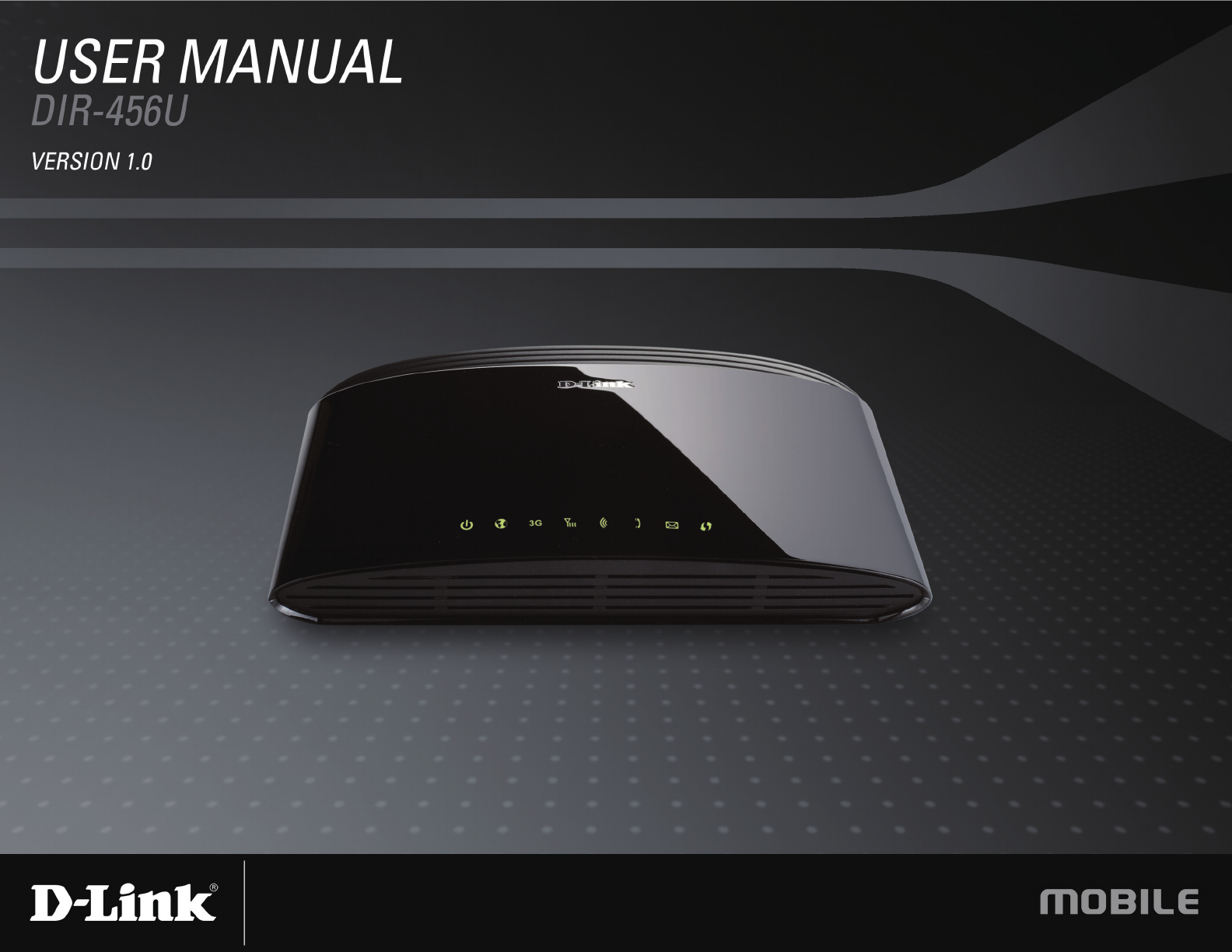

iD-Link DIR-456U User Manual
D-Link reserves the right to revise this publication and to make changes in the content hereof without obligation to
notify any person or organization of such revisions or changes.
Trademarks
D-Link and the D-Link logo are trademarks or registered trademarks of D-Link Corporation or its subsidiaries in
the United States or other countries. All other company or product names mentioned herein are trademarks or
registered trademarks of their respective companies.
Copyright © 2010 by D-Link Systems, Inc.
All rights reserved. This publication may not be reproduced, in whole or in part, without prior expressed written
permission from D-Link Systems, Inc.
Preface

iiD-Link DIR-456U User Manual
Table of Contents
Preface...........................................................................i
Trademarks .............................................................. i
Product Overview ........................................................ 1
Package Contents ...................................................1
System Requirements .............................................1
Introduction ..............................................................2
Hardware Overview ................................................. 3
Rear Panel .........................................................3
Front Panel ........................................................4
LEDs ..................................................................5
Installation ....................................................................6
Connect to Your Network ........................................6
Connect a Telephone ..............................................7
Wireless Installation Considerations ........................ 8
Conguration ............................................................... 9
Web-based Conguration Utility .............................. 9
Setup Wizard ......................................................... 10
Internet Connection Setup Wizard ................... 10
Manual Internet Connection Setup ..................14
Internet Connection .........................................15
Internet Connection Type ................................15
Static IP ...........................................................16
Dynamic IP (DHCP) ......................................... 17
PPPoE .............................................................18
PPTP ...............................................................19
L2TP ................................................................20
Russia PPTP (Dual Access) ............................ 21
Russia PPPoE (Dual Access) .......................... 23
3G Internet .......................................................25
Wireless Settings .............................................26
Network Settings ..............................................28
Router Settings ............................................28
DHCP Server Settings .................................29
DHCP Reservations .....................................30
Message Service .............................................31
Virtual Server ...................................................33
Application Rules .............................................34
QoS Engine .....................................................35
Network Filter ...................................................36
Website Filter ................................................... 37
Firewall Settings ..............................................38
Advanced Wireless ..........................................40
Wi-Fi Protected Setup ......................................42
Advanced Network ...........................................44
Call Setting ......................................................46
Admin ...............................................................47
Time ................................................................. 48
Email Settings .................................................. 49
System ............................................................. 50
Firmware .......................................................... 51
Table of Contents

iiiD-Link DIR-456U User Manual
Table of Contents
Dynamic DNS ..................................................52
System Check ..................................................53
Schedules ........................................................54
Device Information ........................................... 55
Logs .................................................................56
Statistics ..........................................................57
Internet Sessions .............................................58
Wireless ...........................................................59
Support ............................................................60
Wireless Security.......................................................61
What is WEP? .......................................................61
Congure WEP ...................................................... 62
What is WPA? .......................................................63
Congure WPA-PSK .............................................64
Congure WPA (RADIUS) ..................................... 65
Using Windows® 7 and WPS for Wireless
Conguration .........................................................66
Connecting to a Wireless Network
Using Windows® 7 ................................................. 70
Connecting to a Wireless Network
Using Windows Vista® .......................................... 73
Connecting to a Wireless Network ........................75
Using Windows® XP ............................................... 75
Troubleshooting ........................................................ 77
Wireless Basics ......................................................... 79
What is Wireless? .................................................. 80
Tips ........................................................................ 82
Wireless Modes ..................................................... 83
Networking Basics .................................................... 84
Check your IP address ..........................................84
Statically Assign an IP address .............................85
Technical Specications........................................... 86
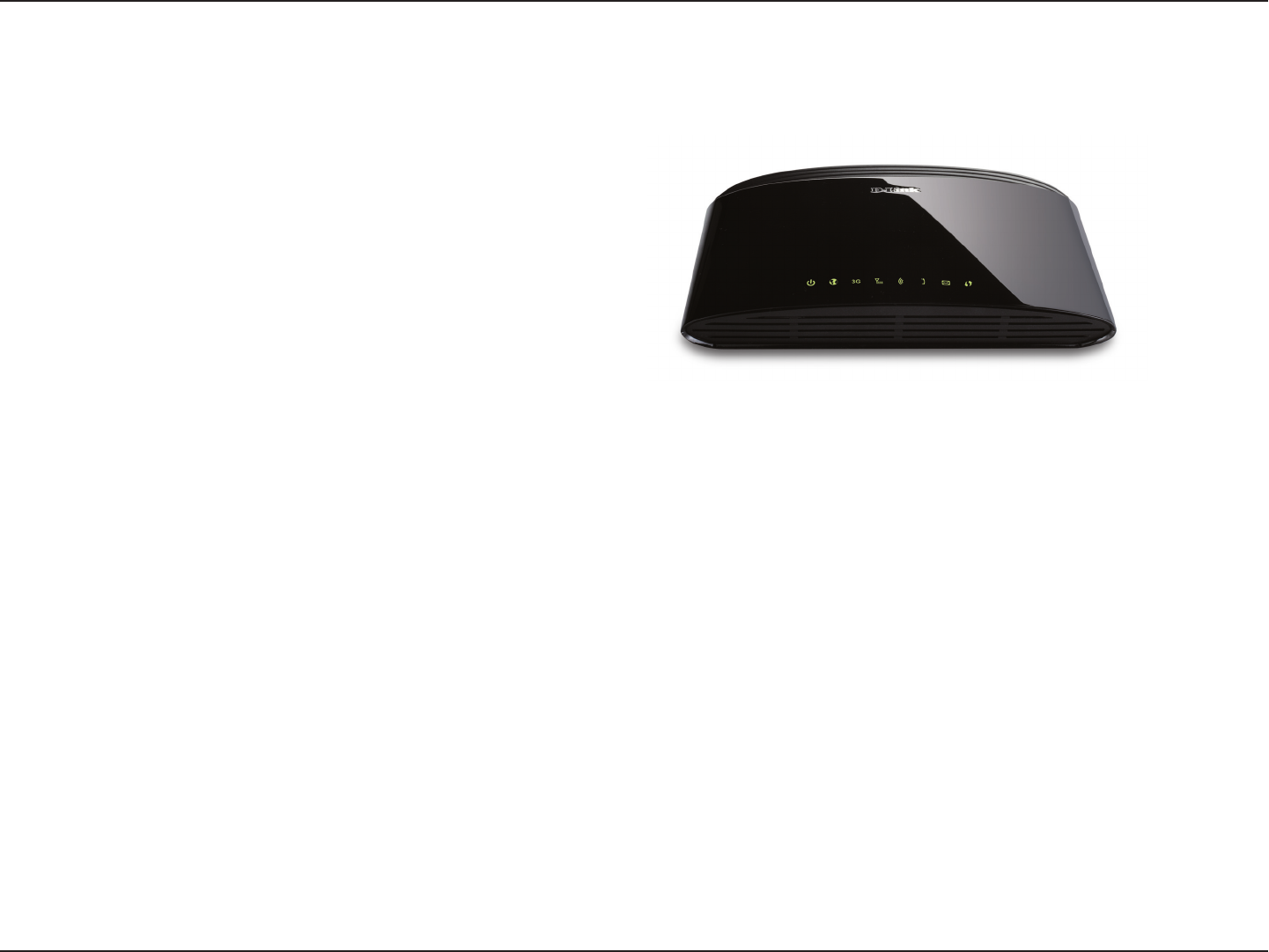
1D-Link DIR-456U User Manual
Section 1 - Product Overview
• D-Link DIR-456U Mobile Router
• Power Adapter
• Ethernet Cable
• RJ-11 Telephone Cable
• Manual and Warranty on CD
System Requirements
• A compatible (U)SIM card with service*
• Computers with Windows®, Macintosh®, or Linux-based operating systems with an installed Ethernet
adapter
• Internet Explorer Version 6.0 or Netscape Navigator™ Version 6.0 and above (for conguration)
*Subject to services and service terms available from your carrier.
Product Overview
Package Contents
Note: Using a power supply with a different voltage rating than the one included with the DIR-456U will cause damage and
void the warranty for this product.

2D-Link DIR-456U User Manual
Section 1 - Product Overview
Introduction
DIR-456U allows users to access worldwide mobile broadband networks. Once connected, users can transfer data,
stream media, send SMS messages, and make mobile phone calls. Simply insert your UMTS/HSUPA SIM card,
and share your 3.5G Internet connection through a secure 802.11n wireless network or using any of the four 10/100
Ethernet ports.
While accessing your 3.5G Internet connection, you will still have the ability to answer incoming mobile calls and
respond to SMS messages. An RJ-11 jack allows you to attach a standard analog phone for high-quality mobile
calls over a GSM network. Enjoy the comfort and convenience of your favorite ofce phone anywhere you go.
Keep your wireless network safe with WPA/WPA2 wireless encryption. The DIR-456U utilizes dual-active rewalls
(SPI and NAT) to prevent potential attacks across the Internet.
DIR-456U can be installed quickly and easily almost anywhere. This router is great for situations where an impromptu
wireless network must be set up, or wherever conventional network access is unavailable. The DIR-456U can even
be installed in buses, trains, or boats, allowing passengers to check e-mail or chat online while commuting.
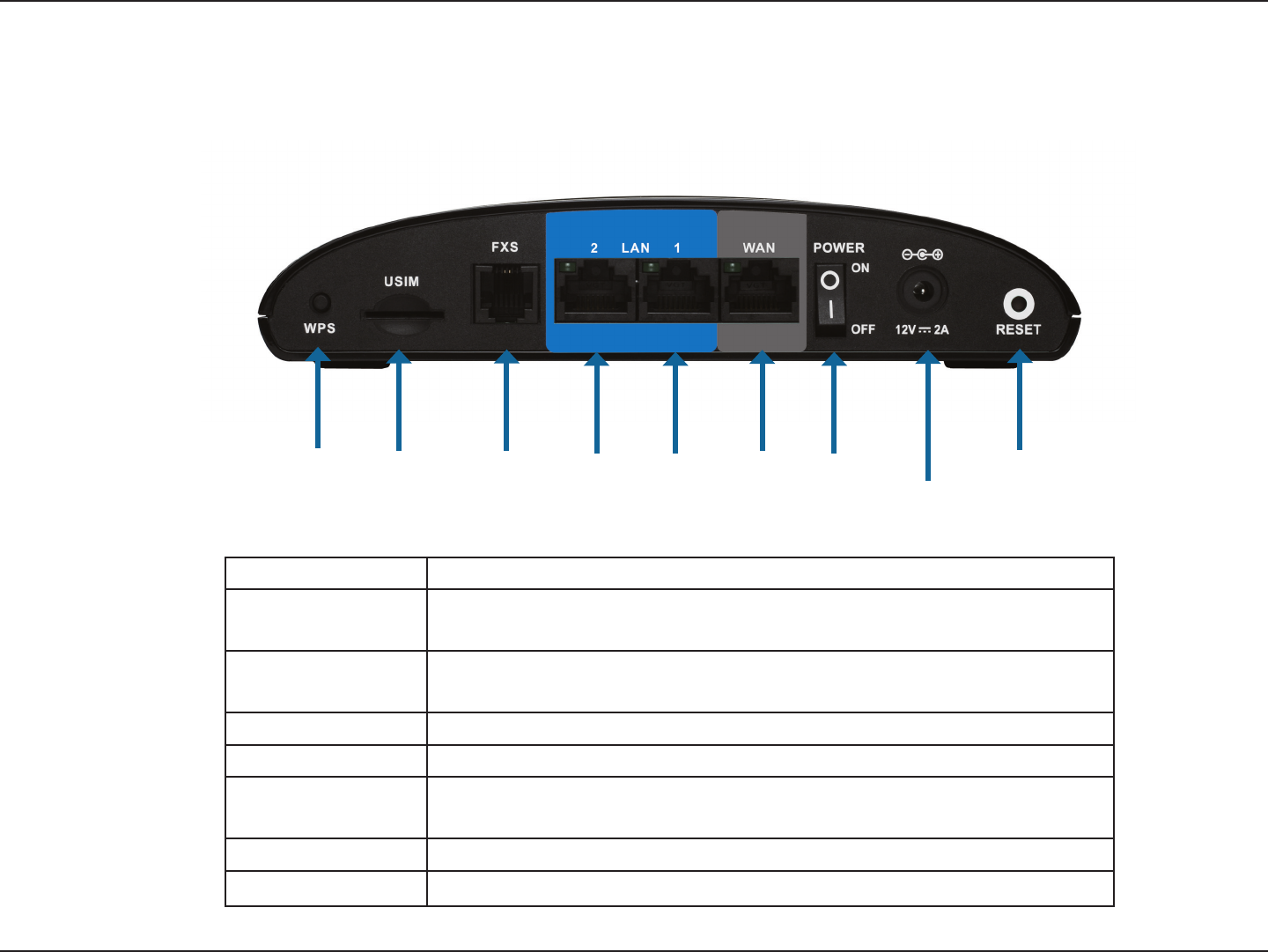
3D-Link DIR-456U User Manual
Section 1 - Product Overview
Hardware Overview
Rear Panel
WPS USIM FXS LAN2 LAN1 WAN Power RESET
Port Function
LAN 1-2 (RJ-45) Insert an Ethernet cable connected to a network device such
as a desktop or notebook computer.
WAN (RJ-45) Insert a standard CAT5 Ethernet cable connected to a DSL/
Cable modem or router.
SIM Insert a standard (U)SIM card into this slot.
Power Insert the provided DC power adapter into this socket.
Phone (RJ-11) Insert an RJ-11 telephone cable connected to a standard
landline telephone.
Reset Hold this button down to reset the device.
WPS Press this button to initiate a new WPS connection.
Power
Connector
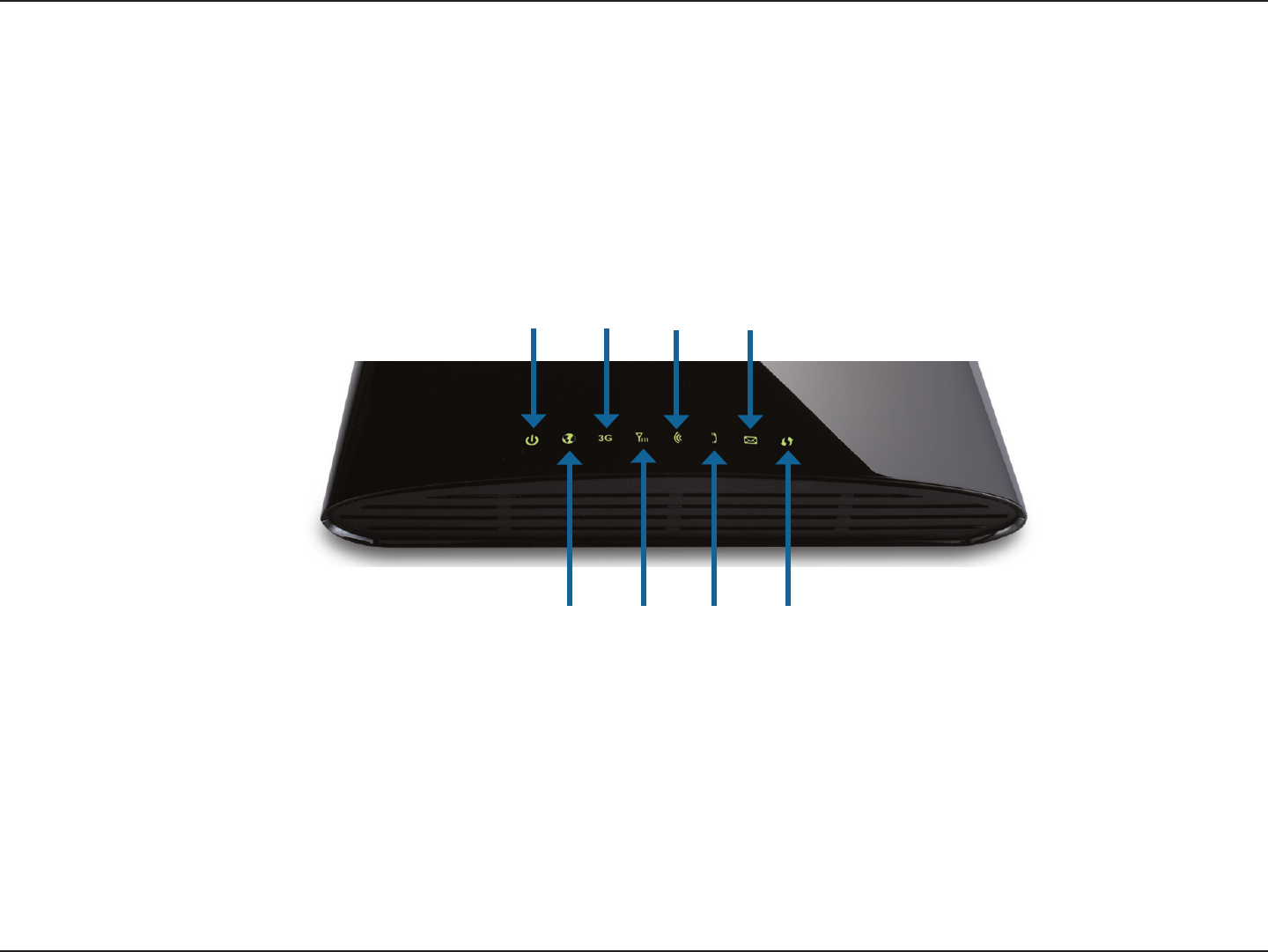
4D-Link DIR-456U User Manual
Section 1 - Product Overview
Hardware Overview
Front Panel
Power 3G WLAN SMS
WAN Signal
Strength
Phone WPS

5D-Link DIR-456U User Manual
Section 1 - Product Overview
LED Name Function
WAN Solid Green: Ethernet connection has been established
Blinking Green: Data is being transferred
LAN 1-2 Solid Green: Ethernet connection has been established
Blinking Green: Data is being transferred
Signal
Strength
OFF: No signal
ON (Blinking Orange): Signal is weak
ON (Solid Orange): Signal strength is medium
ON (Solid Green): Signal strength is strong
WPS Slow Blinking Green: WPS is functioning normally
Fast Blinking Green: WPS is functioning in PBC mode
3.5G Solid Green: UMTS/HSDPA/HSUPA connection is established
Blinking: Data is being transferred via 3G
SMS Solid Green: Lights up when an SMS has been received
WLAN Solid Green: WLAN is active and available
Blinking Green: Data is being transferred via WLAN
Hardware Overview
LEDs

6D-Link DIR-456U User Manual
Section 2 - Installation
Connect to Your Network
Installation
This section will guide you through the installation process. Placement of the router is very important. Do not place the router in an enclosed
area such as a closet, cabinet, or in an attic or garage.
Note: Ensure that your DIR-456U Mobile Router is disconnected and powered off before performing the installation steps below.
1. Insert a standard (U)SIM card into the SIM card slot on the back of the router with the gold contacts facing downwards.
2. Insert your Internet/WAN network cable into the INTERNET port on the back of the router.
Note: The 3.5G connection can also be used as a backup WAN. Once a backup is congured, the router will automatically use 3.5G
for the Internet connection if the Ethernet WAN is not available.
3. Insert the Ethernet cable into the LAN Port 1 on the back panel of the DIR-456U Mobile Router, and an available Ethernet port on the
network adapter in the computer you will use to congure the unit.
Note: The DIR-456U Mobile Router LAN Ports are “Auto-MDI/MDIX.” Therefore, patch or crossover Ethernet cables can be used.
4. Connect the power adapter to the socket on the back panel of your DIR-456U Mobile Router. Plug the other end of the power adapter
into a wall outlet or power strip.
a. The Status LED will light up to indicate that power has been supplied to the router.
b. The LEDs on the front panel will ash on and off as the DIR-456U Mobile Router performs initialization and Internet connection
processes.
c. After a few moments, if a connection has been established, the following LEDs will turn solid green: Power, Status, WAN, WLAN,
and LAN Port 1 (or whichever port(s) your Ethernet cable has been connected to).
Caution! Always unplug/power down the router before installing or removing the SIM card. Never insert or remove the SIM card while
the router is in use.
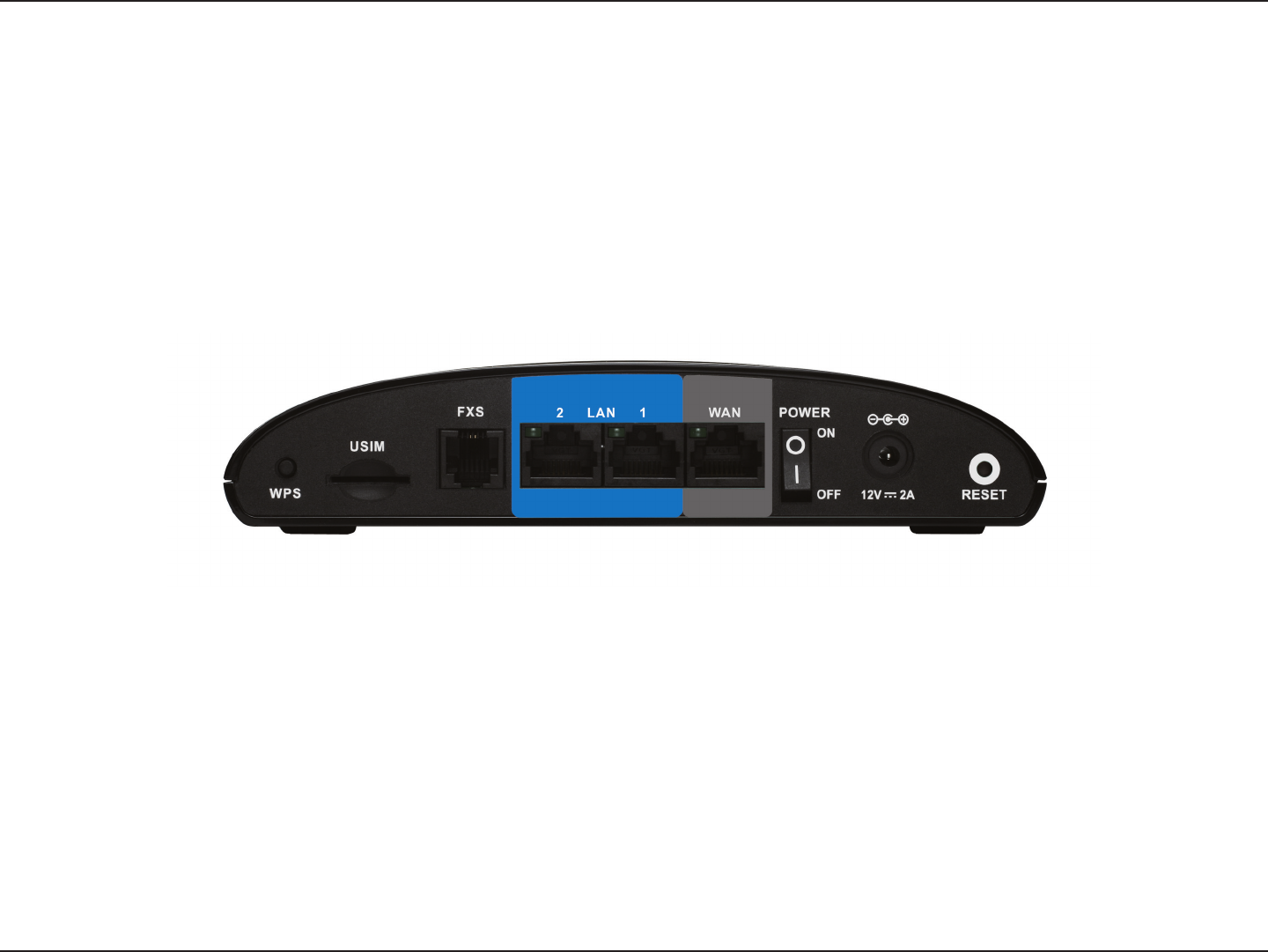
7D-Link DIR-456U User Manual
Section 2 - Installation
Connect a Telephone
A standard RJ-11 jack on the back of the router allows you to connect a standard analog telephone for voice calls.
Simply plug the phone cable into the jack labeled FXS.
You can then use your handset to dial out as you typically would with a standard landline.
Your attached phone will also ring for any incoming voice calls.

8D-Link DIR-456U User Manual
Section 2 - Installation
Wireless Installation Considerations
The DIR-456U can be accessed using a wireless connection from virtually anywhere within the operating range of your wireless network.
Keep in mind, however, that the quantity, thickness and location of walls, ceilings, or other objects that the wireless signals must pass
through, may limit the range. Ranges vary depending on the types of materials and background RF (radio frequency) noise in your home
or ofce. The key to maximizing the wireless range is to follow these basic guidelines:
1. Minimize the number of walls and ceilings between the D-Link router and other network devices. Each wall or ceiling can
reduce your adapter’s range from 3 to 90 feet (1 to 30 meters).
2. Be aware of the direct line between network devices. A wall that is 1.5 feet thick (0.5 meters), at a 45-degree angle
appears to be almost 3 feet (1 meter) thick. At a 2-degree angle it looks over 42 feet (14 meters) thick. Position devices
so that the signal will travel straight through a wall or ceiling (instead of at an angle) for better reception.
3. Try to position access points, wireless routers, and computers so that the signal passes through open doorways and
drywall. Materials such as glass, metal, brick, insulation, concrete and water can affect wireless performance. Large
objects such as sh tanks, mirrors, le cabinets, metal doors and aluminum studs may also have a negative effect on
range.
4. If you are using 2.4GHz cordless phones, make sure that the 2.4GHz phone base is as far away from your wireless device
as possible. The base transmits a signal even if the phone in not in use. In some cases, cordless phones, X-10 wireless
devices, and electronic equipment such as ceiling fans, uorescent lights, and home security systems may dramatically
degrade wireless connectivity.
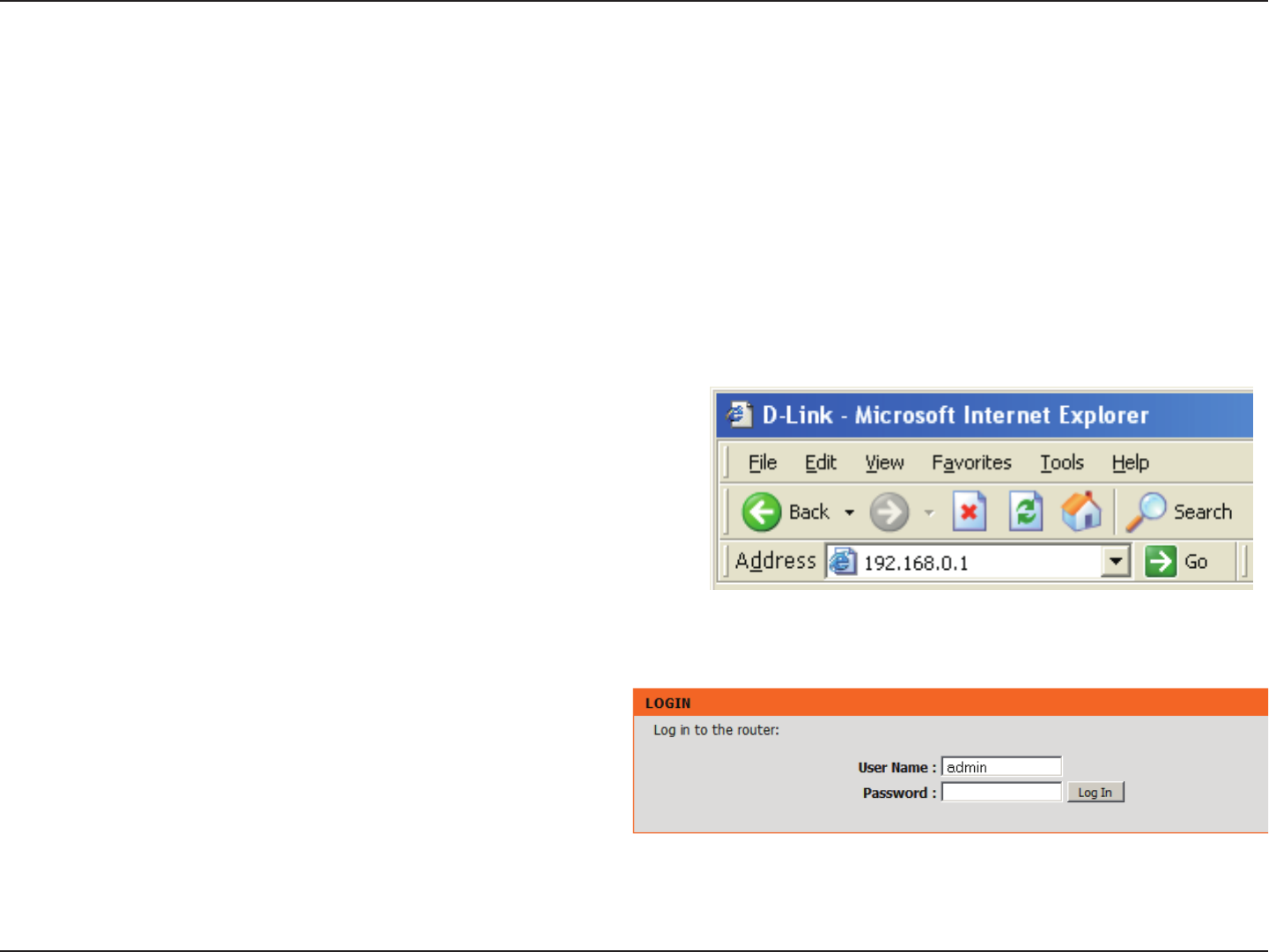
9D-Link DIR-456U User Manual
Section 3 - Configuration
Configuration
This section will show you how to congure your new D-Link mobile router using the web-based conguration utility.
Web-based Configuration Utility
To access the conguration utility, open a web-browser such
as Internet Explorer and enter the IP address of the router
(192.168.0.1).
Type Admin and then enter the password. By default, the
password is blank.
If you get a Page Cannot be Displayed error, please refer to
the Troubleshooting section for assistance.
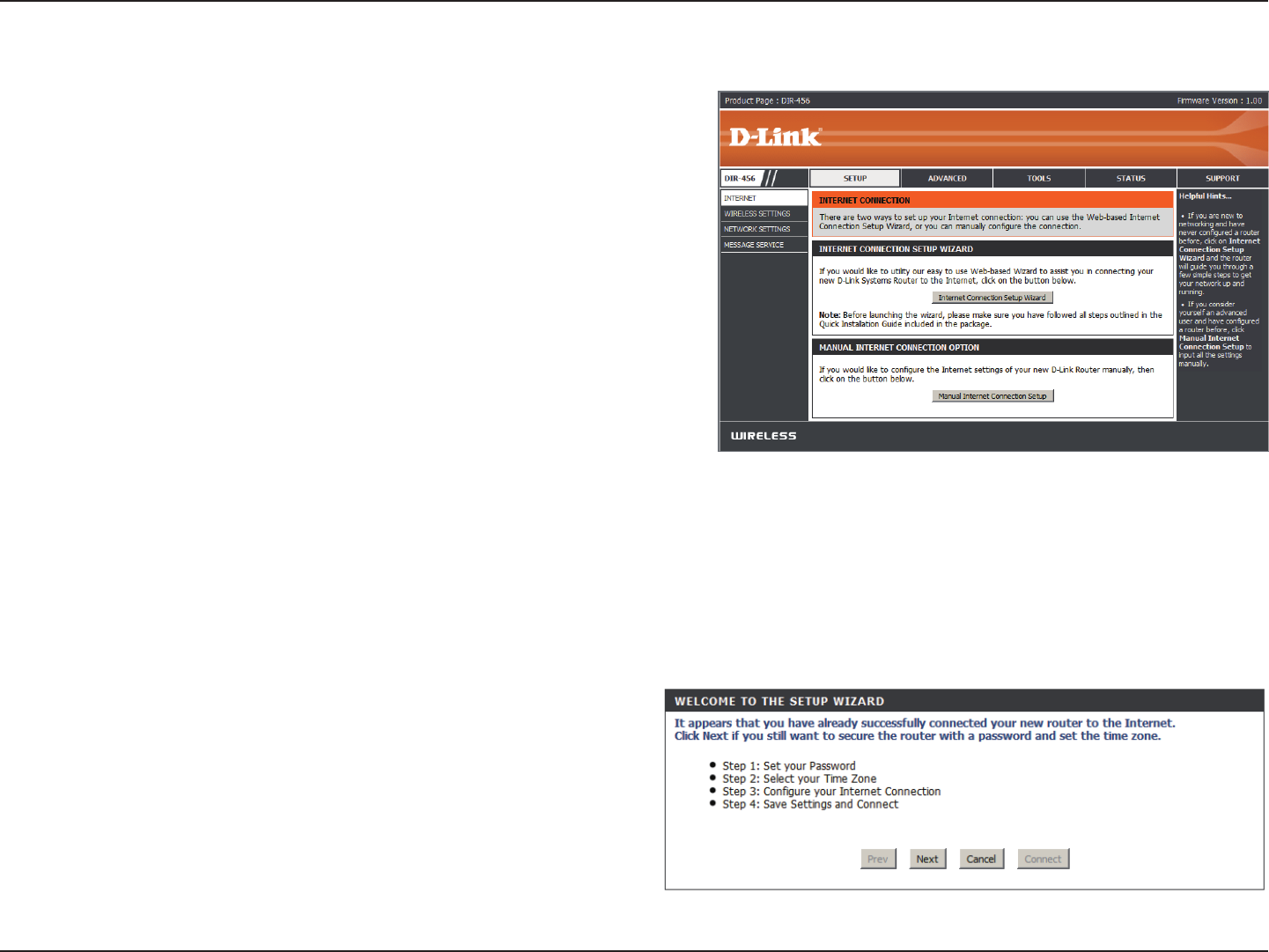
10D-Link DIR-456U User Manual
Section 3 - Configuration
Setup Wizard
The setup wizard guides you through the initial setup of your router.
There are two ways to setup your Internet connection. You can use the
Web-based Internet Connection Setup Wizard or you can manually
congure using the Manual Internet Connection Setup wizard.
Click Internet Connection Setup Wizard to begin.
If you want to enter your settings without running the wizard, click
Manual Internet Connection Setup and skip to page 14.
This wizard will guide you through a step-by-step process to congure
your D-Link router to connect to the Internet.
Click Next to continue.
Internet Connection Setup Wizard
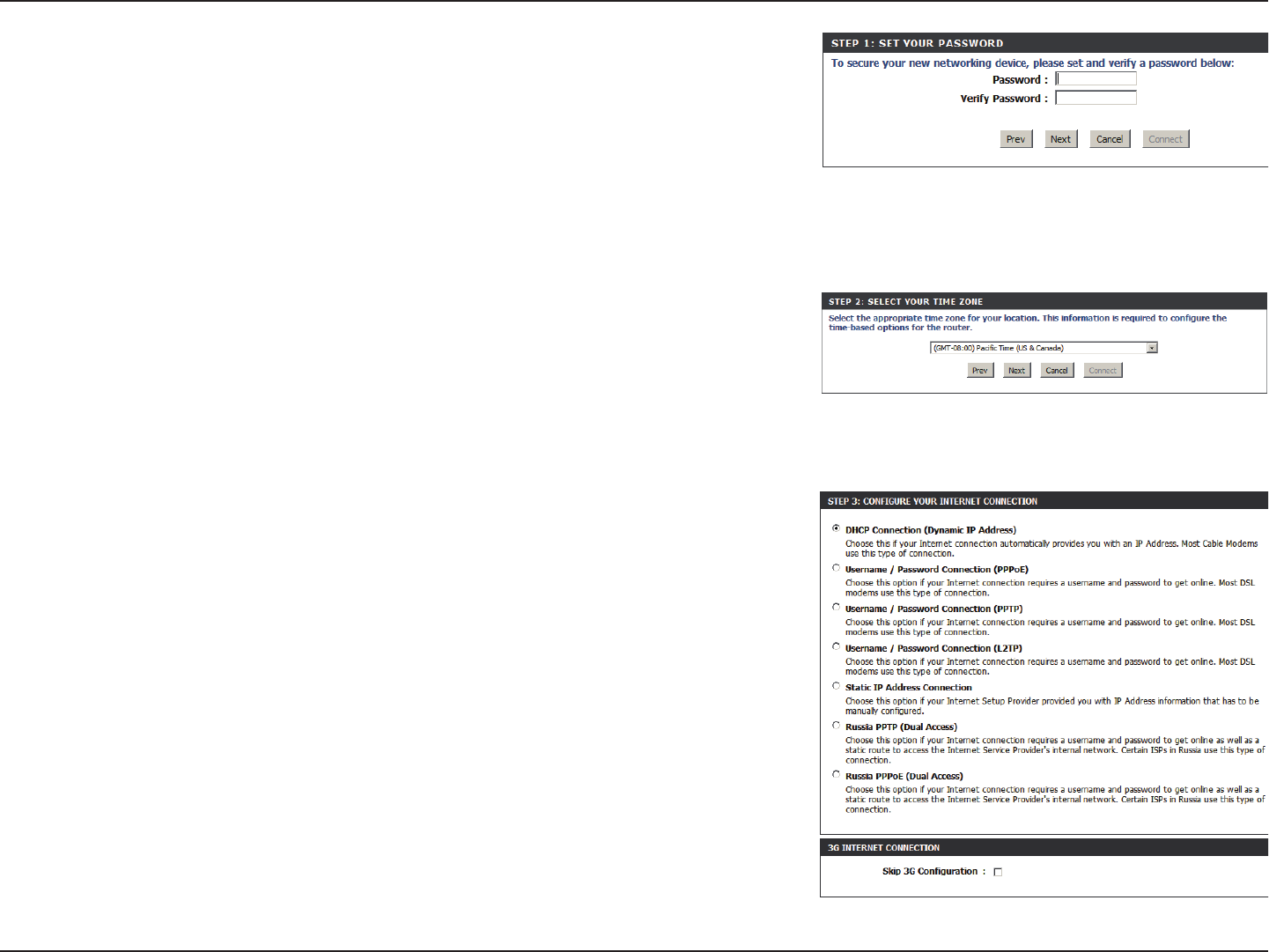
11D-Link DIR-456U User Manual
Section 3 - Configuration
Create a new password and then click Next to continue.
Click Prev to go back to the previous page or click Cancel to close the wizard.
Select your time zone from the drop-down box and then click Next to continue.
Click Prev to go back to the previous page or click Cancel to close the wizard.
Select the Internet connection type. The connection types are explained on the
following page. If you are unsure of the correct connection type, you may have to
contact your Internet Service Provider (ISP).
Click Prev to go back to the previous page or click Cancel to close the wizard.
Note: The DIR-456U supports several kinds of WAN interfaces, allowing you to
assign either a WAN or a WWAN(3.5G) connection as the Backup WAN. If the
Primary WAN is down or unavailable, congure the Backup WAN to Enable, and all
the trafc will be routed through Backup WAN. This feature is called WAN Failover.
You can use WAN Failover if you need redundancy to your Internet connection or
any other network.

12D-Link DIR-456U User Manual
Section 3 - Configuration
Choose this option if your Internet connection uses an IP address that does not change. Your ISP generally
will provide you with this information. See page 16 for information about how to congure this type of
connection.
Choose this if your Internet connection automatically provides you with an IP Address. Most cable modems
use this type of connection. See page 17 for information about how to congure this type of connection.
Choose this option if your Internet connection requires a username and password to connect. Most DSL modems
use this style of connection. See page 18 for information about how to congure this type of connection.
Choose this option if your Internet connection requires Point-to-Point Tunneling Protocol (PPTP). See page
19 for information about how to congure this type of connection.
Choose this option if your Internet connection requires Layer 2 Tunneling Protocol (L2TP). See page 21 for
information about how to congure this type of connection.
To congure a Russian PPTP Internet connection, congure as previously described for PPTP connections.
See page 21 for information about how to congure this type of connection.
Some PPPoE connections use a static IP route to the ISP in addition to the global IP settings for the connection.
This requires an added step to dene IP settings for the physical WAN port. To congure a Russian PPPoE
Internet connection, congure as previously described for PPPoE connections and add the physical WAN
IP settings as instructed by your ISP. See page 23 for information about how to congure this type of
connection.
Select this option if you do not need to congure 3G.
Static IP Address
Connection:
DHCP Connection
(Dynamic IP Address):
Username / Password
Connection (PPPoE):
Username / Password
Connection (PPTP):
Username / Password
Connection (L2TP):
Russia PPTP (Dual
Access):
Russia PPPoE (Dual
Access):
Skip 3G Configuration:
The subsequent conguration pages will differ depending on the selection you make on this page.
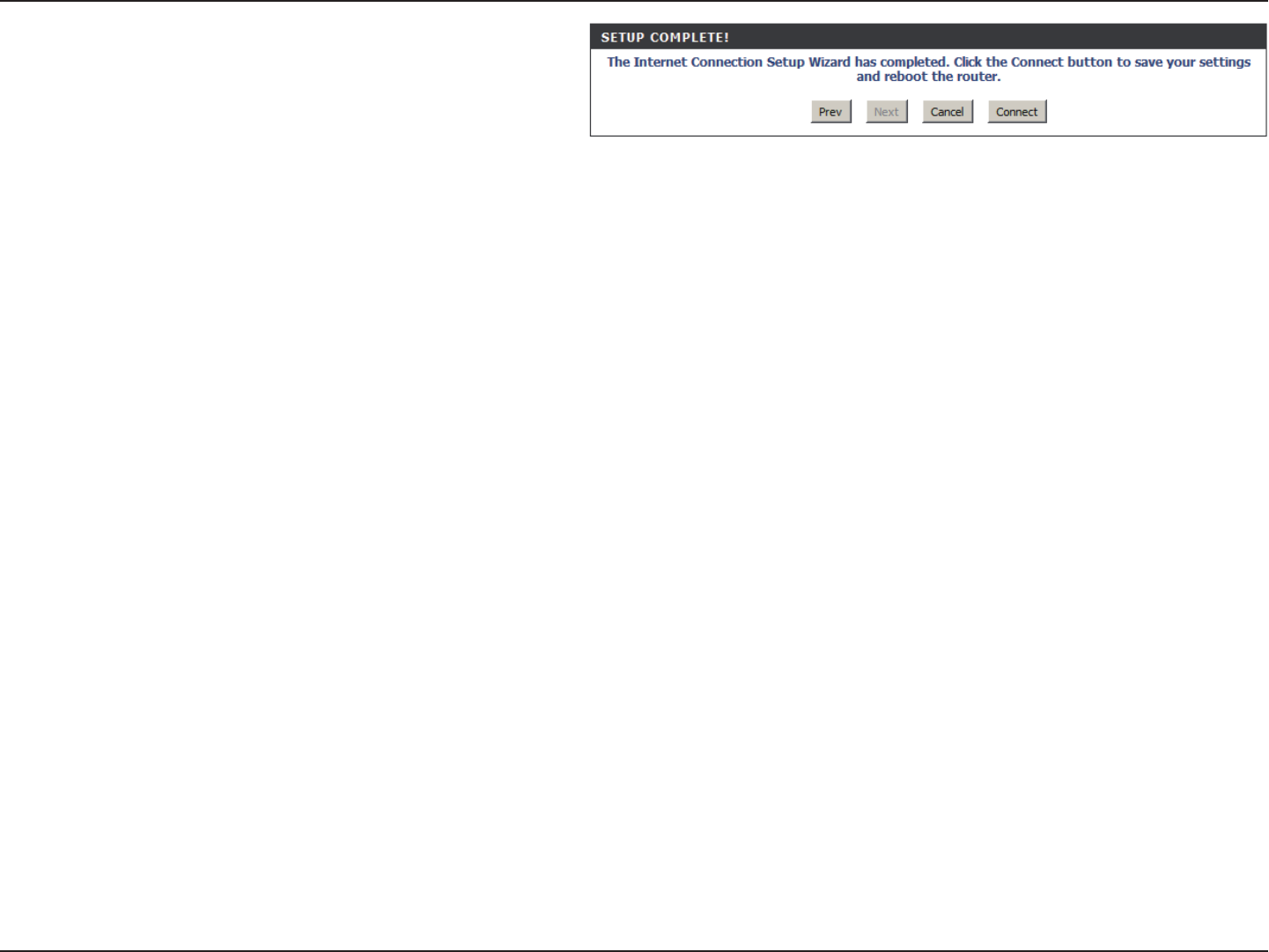
13D-Link DIR-456U User Manual
Section 3 - Configuration
You have completed the Setup Wizard.
Click Connect to save your settings.
A popup will appear to conrm your settings.
Click OK to save your settings.
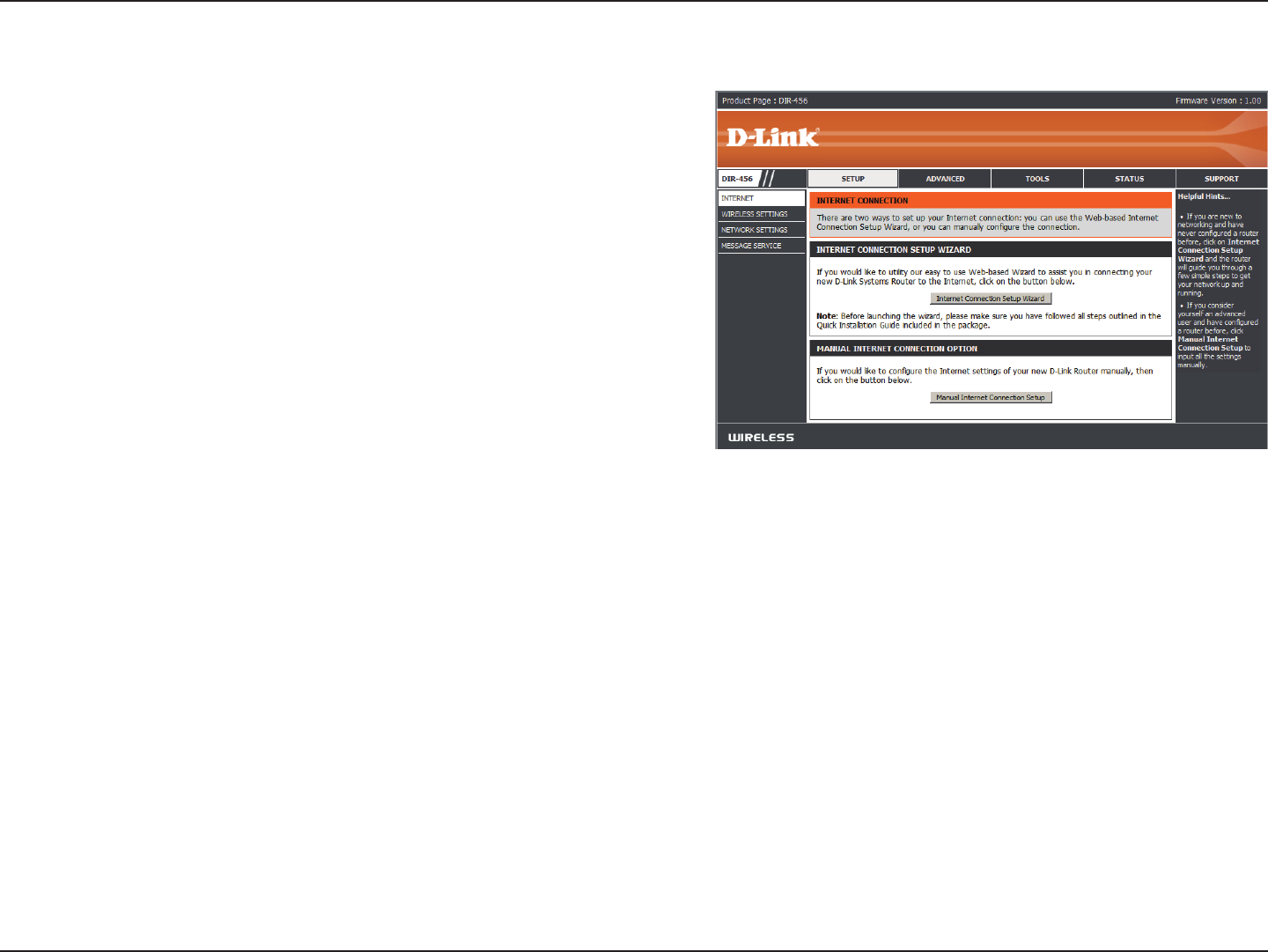
14D-Link DIR-456U User Manual
Section 3 - Configuration
Manual Internet Connection Setup
Click Manual Internet Connection Setup to begin.
If you prefer to congure your router’s Internet connection using the wizard,
click Internet Connection Setup Wizard and refer to page 10.
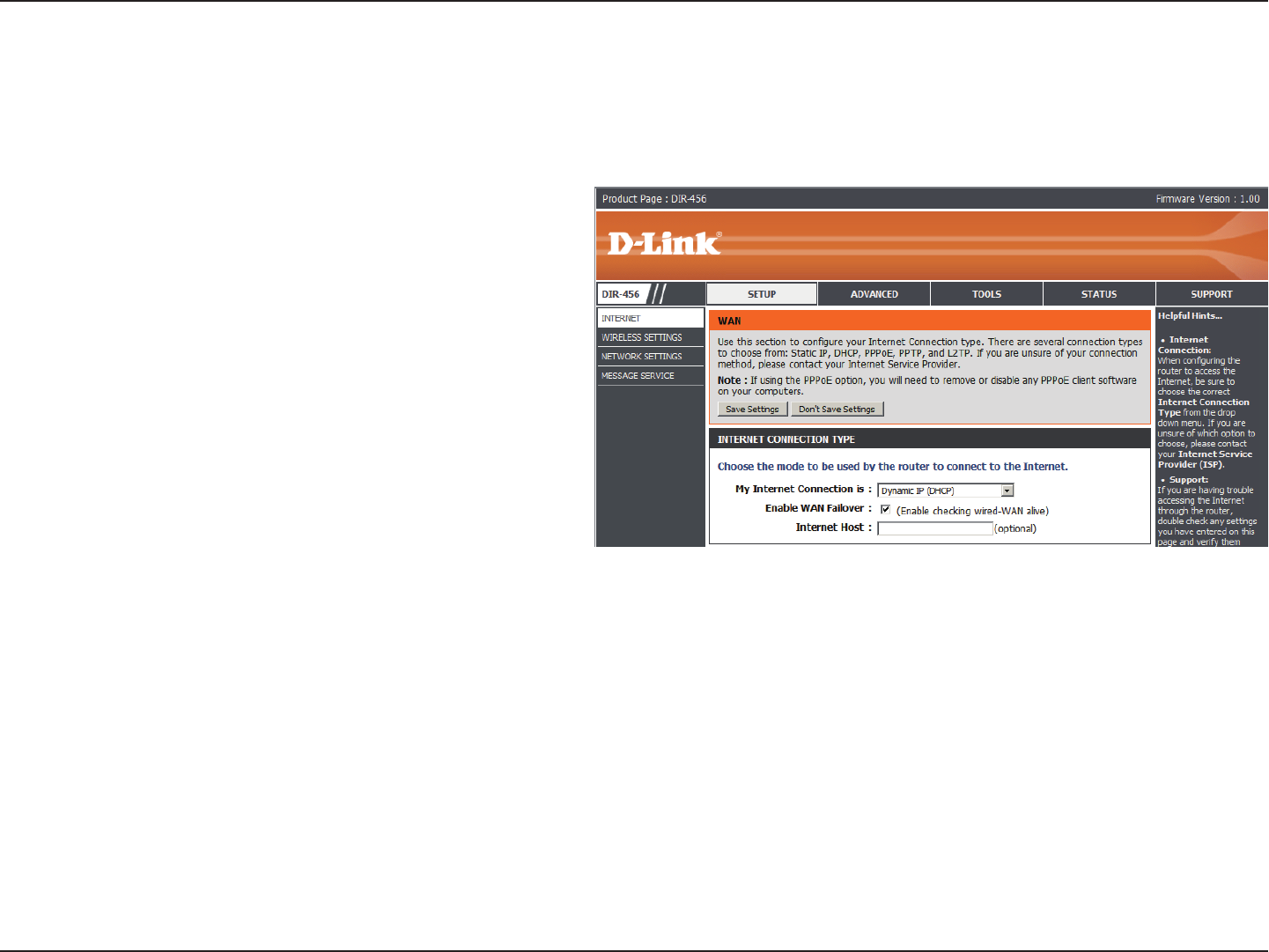
15D-Link DIR-456U User Manual
Section 3 - Configuration
Several different Internet Connection types can be selected depending upon the specications of your Internet Service Provider (ISP).
Select the Internet Connection type
specied by your Internet Service
Provider (ISP). The corresponding
settings will be displayed below.
Please see the following pages for
details on how to congure these
different connection types.
When this box is checked, the
selected connection will act as a
backup for the 3.5G connection.
Select this box to enable checking
wired-WAN alive. The router will test
your connection status and connect
to the 3G connection if your WAN
connection goes down.
Enter the IP address of the Internet host to be used as the backup connection.
Internet Connection
Internet Connection Type
My Internet Connection is:
Enable WAN Failover:
Internet Host:
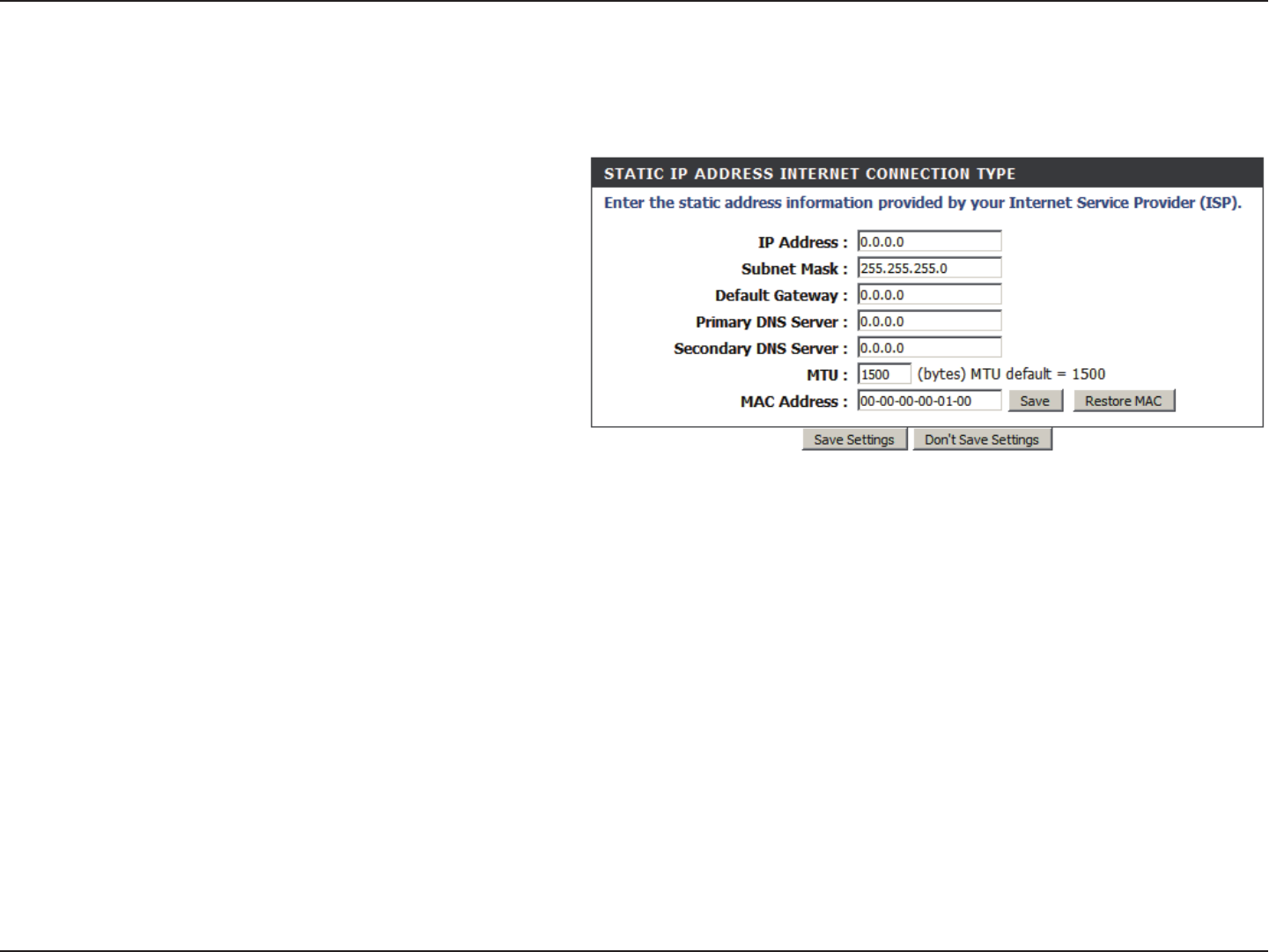
16D-Link DIR-456U User Manual
Section 3 - Configuration
Enter the IP address assigned to
your network connection.
Enter the subnet mask.
Enter the default gateway.
Enter the primary DNS server.
Enter the secondary DNS server.
You may need to change the
Maximum Transmission Unit (MTU)
for optimal performance. The default value is 1500.
The default MAC Address is set to the Internet port’s physical interface MAC address on the Broadband Router.
It is not recommended that you change the default MAC address unless required by your ISP. You can use
the Clone Your PC’s MAC Address button to replace the Internet port’s MAC address with the MAC address
of your Ethernet card.
Click Save Settings to save your changes, or click Don’t Save Settings to discard your changes.
IP Address:
Subnet Mask:
Default Gateway:
Primary DNS Server:
Secondary DNS Server:
MTU:
MAC Address:
Choose this Internet connection if your ISP assigns you a static IP address.
Static IP
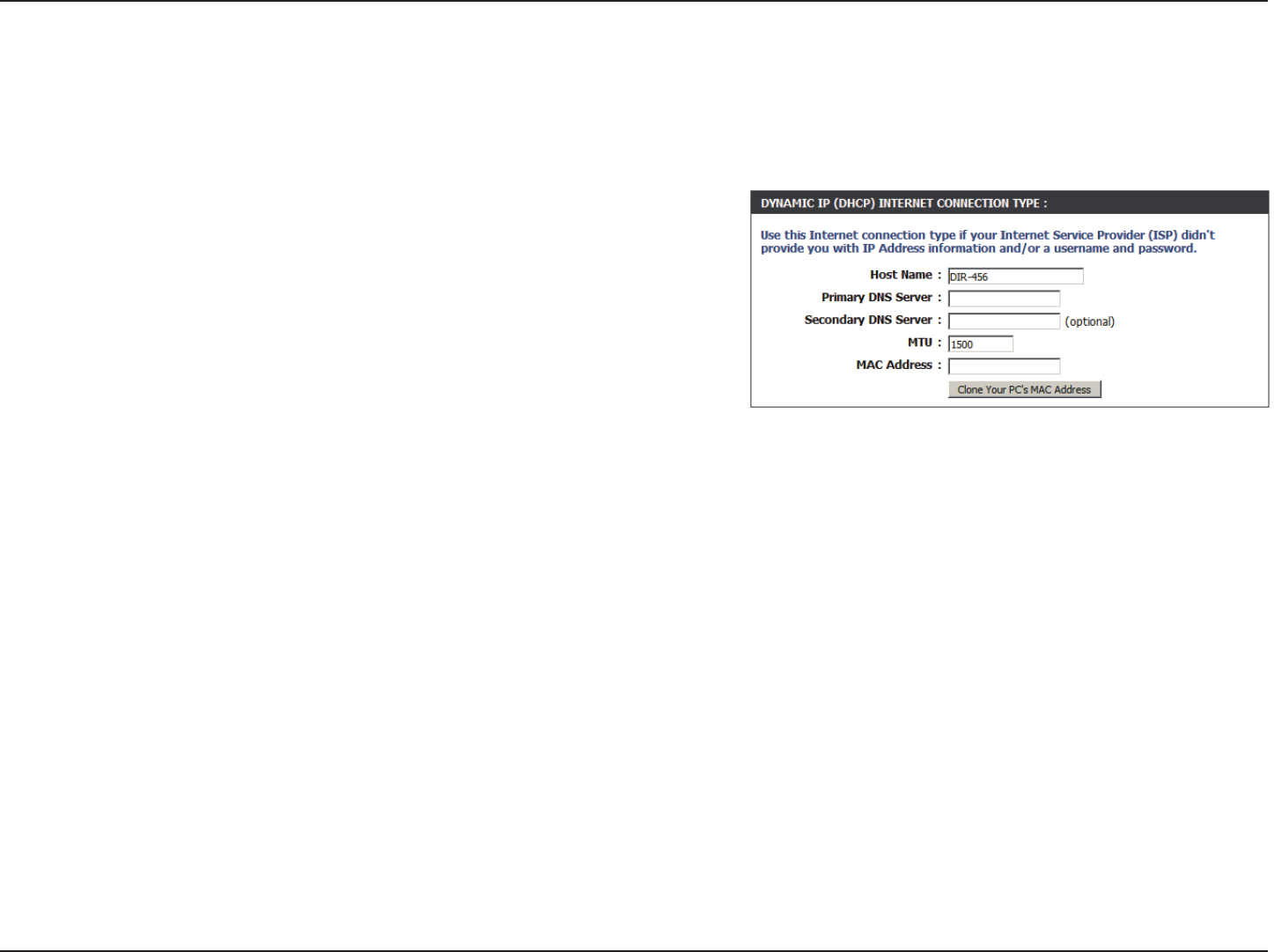
17D-Link DIR-456U User Manual
Section 3 - Configuration
Dynamic IP (DHCP)
(Optional) Required by some ISPs.
(Optional) Fill in with IP address of primary DNS
server.
(Optional) Fill in with IP address of secondary DNS
server.
You may need to change the Maximum Transmission
Unit (MTU) for optimal performance. The default
value is 1500.
The default MAC Address is set to the Internet port’s physical interface MAC address on the Broadband Router.
It is not recommended that you change the default MAC address unless required by your ISP. You can use
the Clone Your PC’s MAC Address button to replace the Internet port’s MAC address with the MAC address
of your PC.
Click Save Settings to save your changes, or click Don’t Save Settings to discard your changes.
This section will help you to obtain IP Address information automatically from your ISP. Use this option if your ISP didn’t provide you with
IP Address information and/or a username and password.
Host Name:
Primary DNS Server:
Secondary DNS Server:
MTU (Maximum
Transmission Unit):
MAC Address:
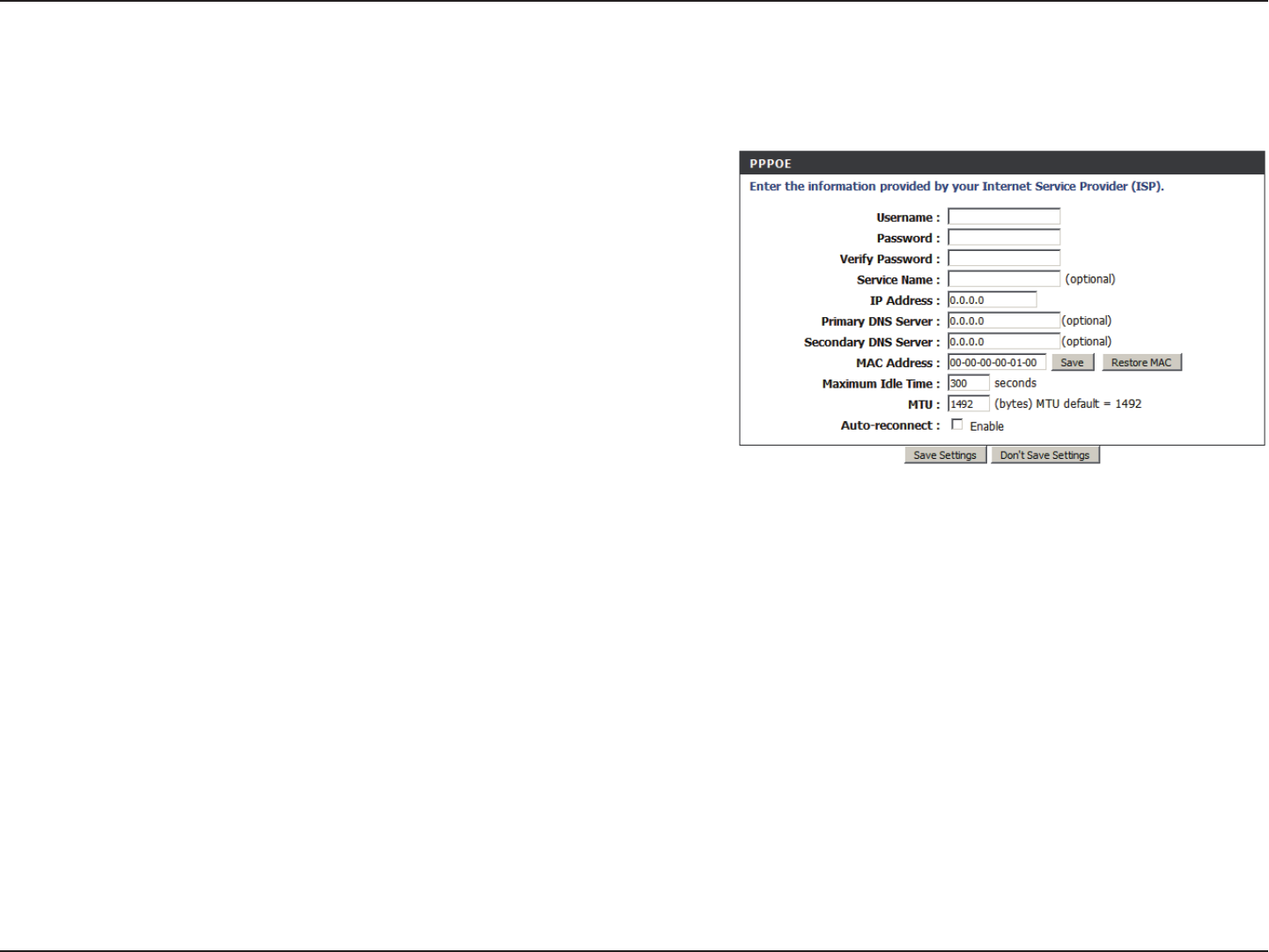
18D-Link DIR-456U User Manual
Section 3 - Configuration
PPPoE
Choose this Internet connection if your ISP provides you PPPoE account.
The username/account name that your ISP provides
to you for PPPoE dial-up.
The password that your ISP provides to you for
PPPoE dial-up.
Re-enter the password.
(Optional) Fill in if provided by your ISP. If not, keep
the default value.
(Optional) Fill in if provided by your ISP. If not, keep
the default value.
(Optional) Fill in if provided by your ISP. If not, keep the default value.
MAC address of WAN interface. You can also copy MAC address of your PC to its WAN interface by pressing
Clone Your PC’s MAC button. The Restore MAC button will reset the router to its default MAC address.
The amount of time of inactivity before disconnecting established PPPoE session. Set it to zero or enable
Auto-reconnect will disable this feature.
The default setting of PPPoE is 1492.
Click Save Settings to save your changes, or click Don’t Save Settings to discard your changes.
Username:
Password:
Verify Password:
IP Address:
Primary DNS Server:
Secondary DNS Server:
MAC Address:
Maximum Idle Time:
Maximum Transmission
Unit (MTU):
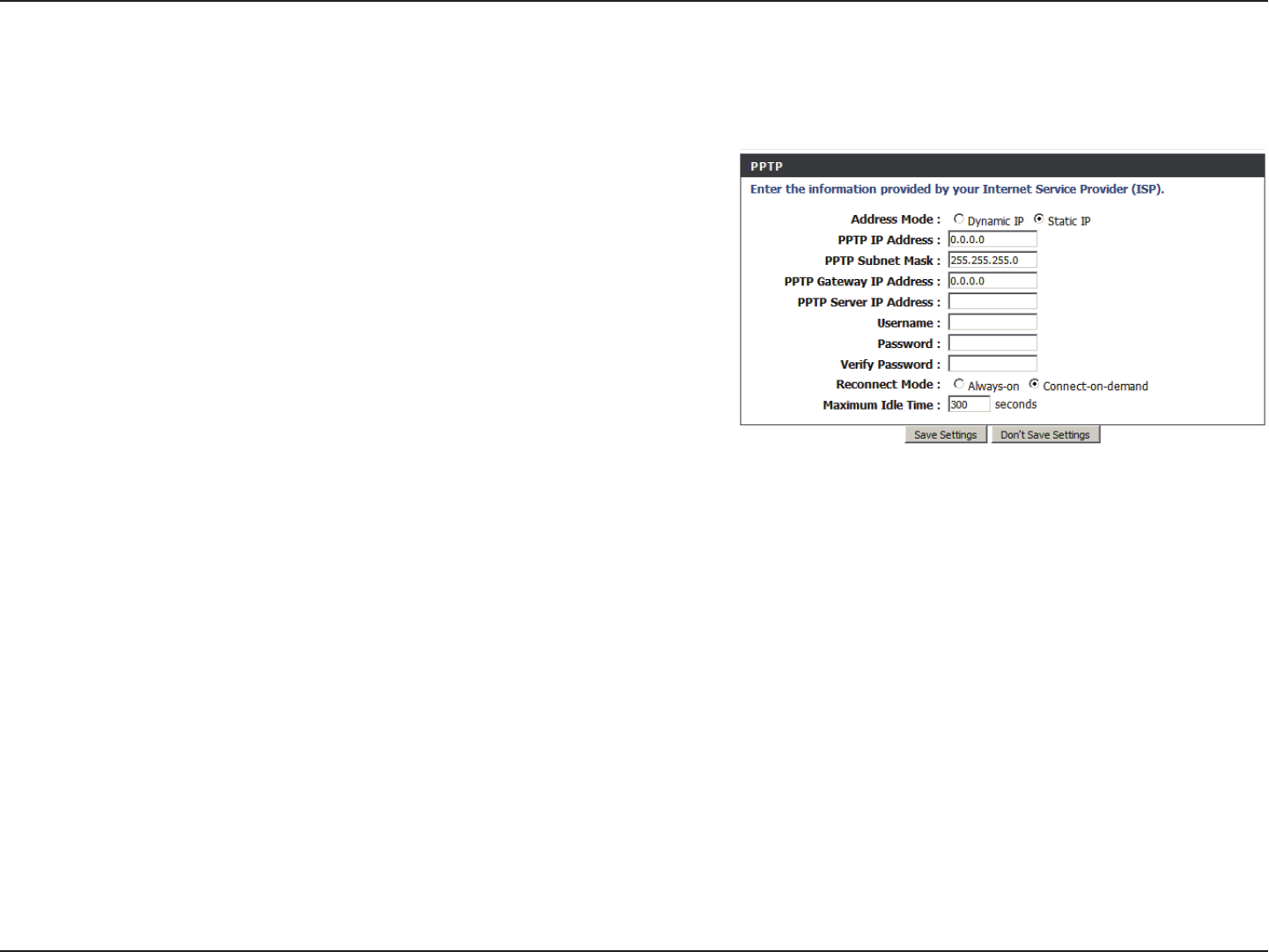
19D-Link DIR-456U User Manual
Section 3 - Configuration
PPTP
Choose this Internet connection if your ISP provides you PPTP account.
Choose Static IP only if your ISP assigns you an IP
address. Otherwise, please choose Dynamic IP.
Enter the information provided by your ISP.
(Only applicable for Static IP PPTP.)
Enter the information provided by your ISP.
(Only applicable for Static IP PPTP.)
Enter the information provided by your ISP.
(Only applicable for Static IP PPTP.)
Enter the IP address of the PPTP server.
User/account name that your ISP provides to you for PPTP dial-up.
Password that your ISP provides to you for PPTP dial-up.
Re-enter the password.
Choose Always-on when you want to establish PPTP connection all the time. If you choose Connect-on-
demand, the device will establish PPTP connection when local users want to surf Internet, and disconnect if
no trafc after time period of Maximum Idle Time.
The time of no activity to disconnect your PPTP session. Set it to zero or choose Always-on to disable this
feature.
Click Save Settings to save your changes, or click Don’t Save Settings to discard your changes.
Address Mode:
PPTP IP Address:
PPTP Subnet Mask:
PPTP Gateway IP Address:
PPTP Server IP Address:
Username:
Password:
Verify Password:
Reconnect Mode:
Maximum Idle Time:
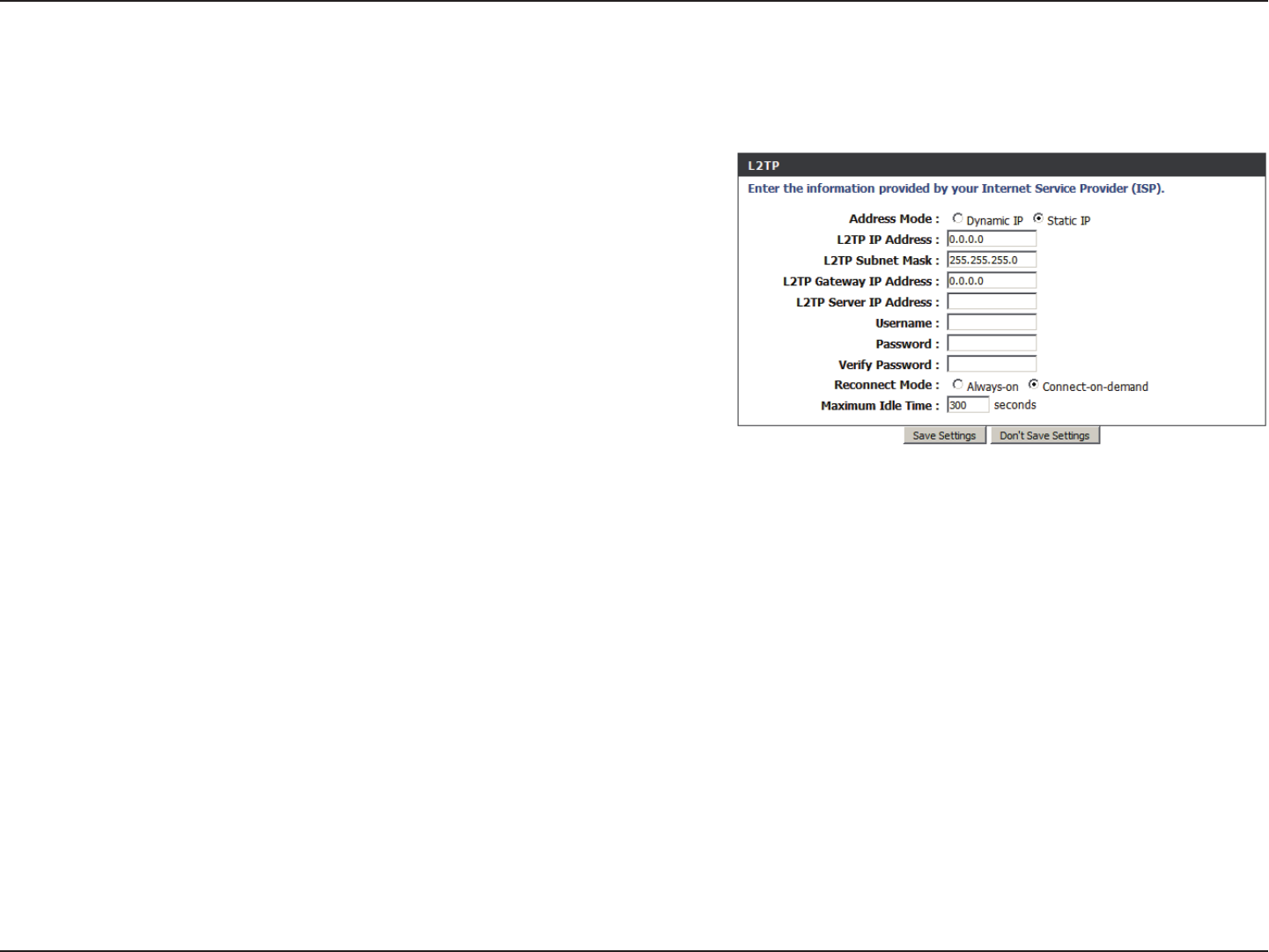
20D-Link DIR-456U User Manual
Section 3 - Configuration
L2TP
Choose this Internet connection if your ISP provides you L2TP account.
Choose Static IP only if your ISP assigns you an IP
address. Otherwise, please choose Dynamic IP.
Enter the information provided by your ISP.
(Only applicable for Static IP L2TP.)
Enter the information provided by your ISP.
(Only applicable for Static IP L2TP.)
Enter the information provided by your ISP.
(Only applicable for Static IP L2TP.)
IP address of L2TP server.
User/account name that your ISP provides to you for L2TP dial-up.
Password that your ISP provides to you for L2TP dial-up.
Re-enter the password.
Choose Always-on when you want to establish L2TP connection all the time. Choose Connect-on-demand the
device will establish L2TP connection when local users want to surf Internet, and disconnect if no trafc after
time period of Maximum Idle Time.
The time of no activity to disconnect your L2TP session. Set it to zero or choose Always-on to disable this
feature.
Click Save Settings to save your changes, or click Don’t Save Settings to discard your changes.
Address Mode:
L2TP IP Address:
L2TP Subnet Mask:
L2TP Gateway IP Address:
L2TP Server IP Address:
Username:
Password:
Verify Password:
Reconnect Mode:
Maximum Idle Time:
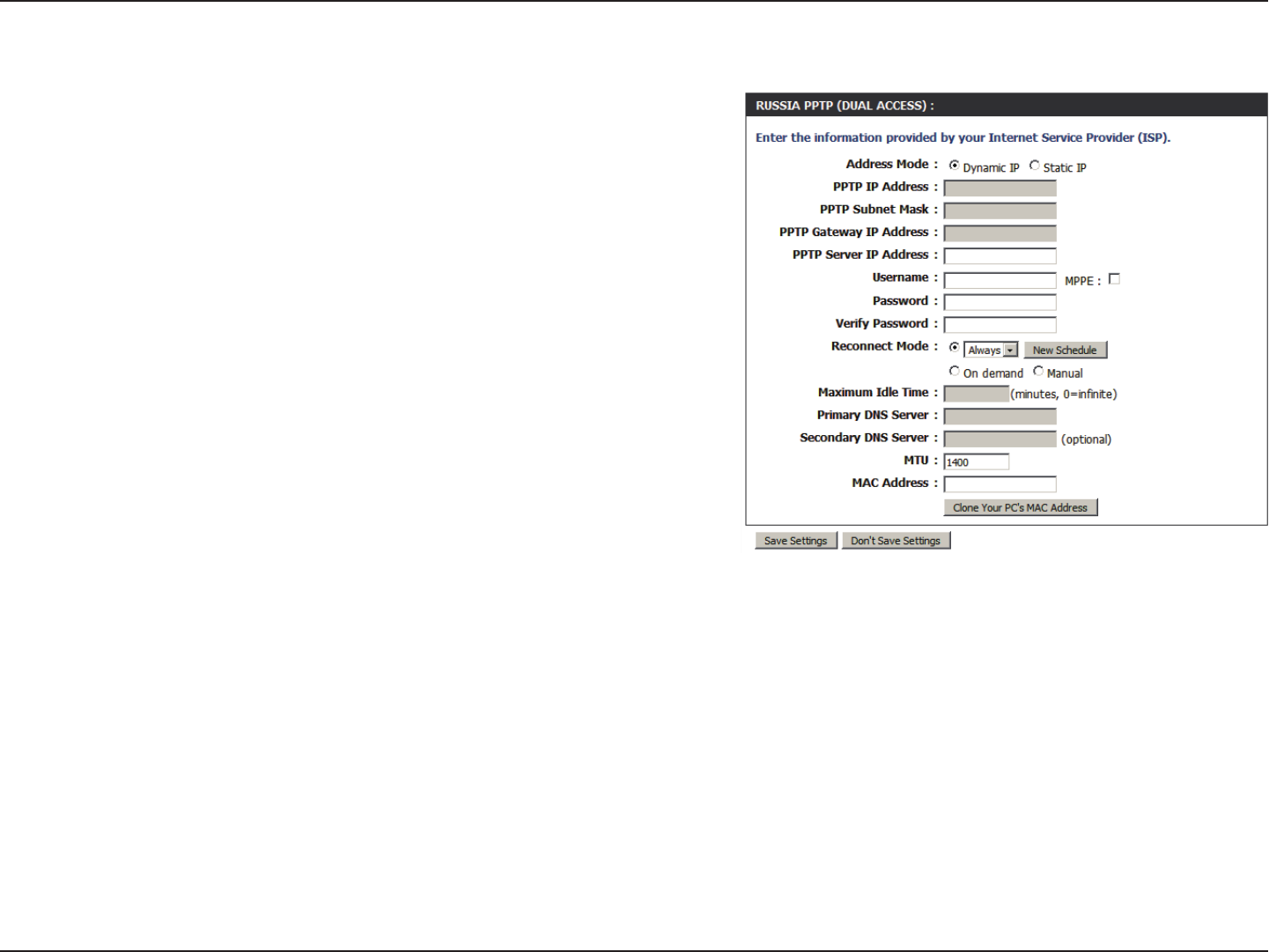
21D-Link DIR-456U User Manual
Section 3 - Configuration
Russia PPTP (Dual Access)
Choose this Internet connection if you are using PPTP in Russia.
Choose Static IP only if your ISP assigns you an IP
address. Otherwise, please choose Dynamic IP.
Enter the information provided by your ISP.
(Only applicable for Static IP PPTP.)
Enter the information provided by your ISP.
(Only applicable for Static IP PPTP.)
Enter the information provided by your ISP.
(Only applicable for Static IP PPTP.)
Enter the IP address of the PPTP server.
User/account name that your ISP provides to you
for PPTP dial-up.
Password that your ISP provides to you for PPTP dial-up.
Re-enter the password.
Choose Always-on when you want to establish PPTP connection all the time. If you choose Connect-on-
demand, the device will establish PPTP connection when local users want to surf Internet, and disconnect if
no trafc after time period of Maximum Idle Time.
The time of no activity to disconnect your PPTP session. Set it to zero or choose Always-on to disable this
feature.
Click Save Settings to save your changes, or click Don’t Save Settings to discard your changes.
Address Mode:
PPTP IP Address:
PPTP Subnet Mask:
PPTP Gateway IP Address:
PPTP Server IP Address:
Username:
Password:
Verify Password:
Reconnect Mode:
Maximum Idle Time:

22D-Link DIR-456U User Manual
Section 3 - Configuration
(Optional) Fill in with IP address of primary DNS server.
(Optional) Fill in with IP address of secondary DNS server.
You may need to change the Maximum Transmission Unit (MTU) for optimal performance. The default value
is 1400.
The default MAC Address is set to the Internet port’s physical interface MAC address on the Broadband Router.
It is not recommended that you change the default MAC address unless required by your ISP. You can use
the Clone Your PC’s MAC Address button to replace the Internet port’s MAC address with the MAC address
of your PC.
Primary DNS Server:
Secondary DNS Server:
Maximum Transmission
Unit (MTU):
MAC Address:
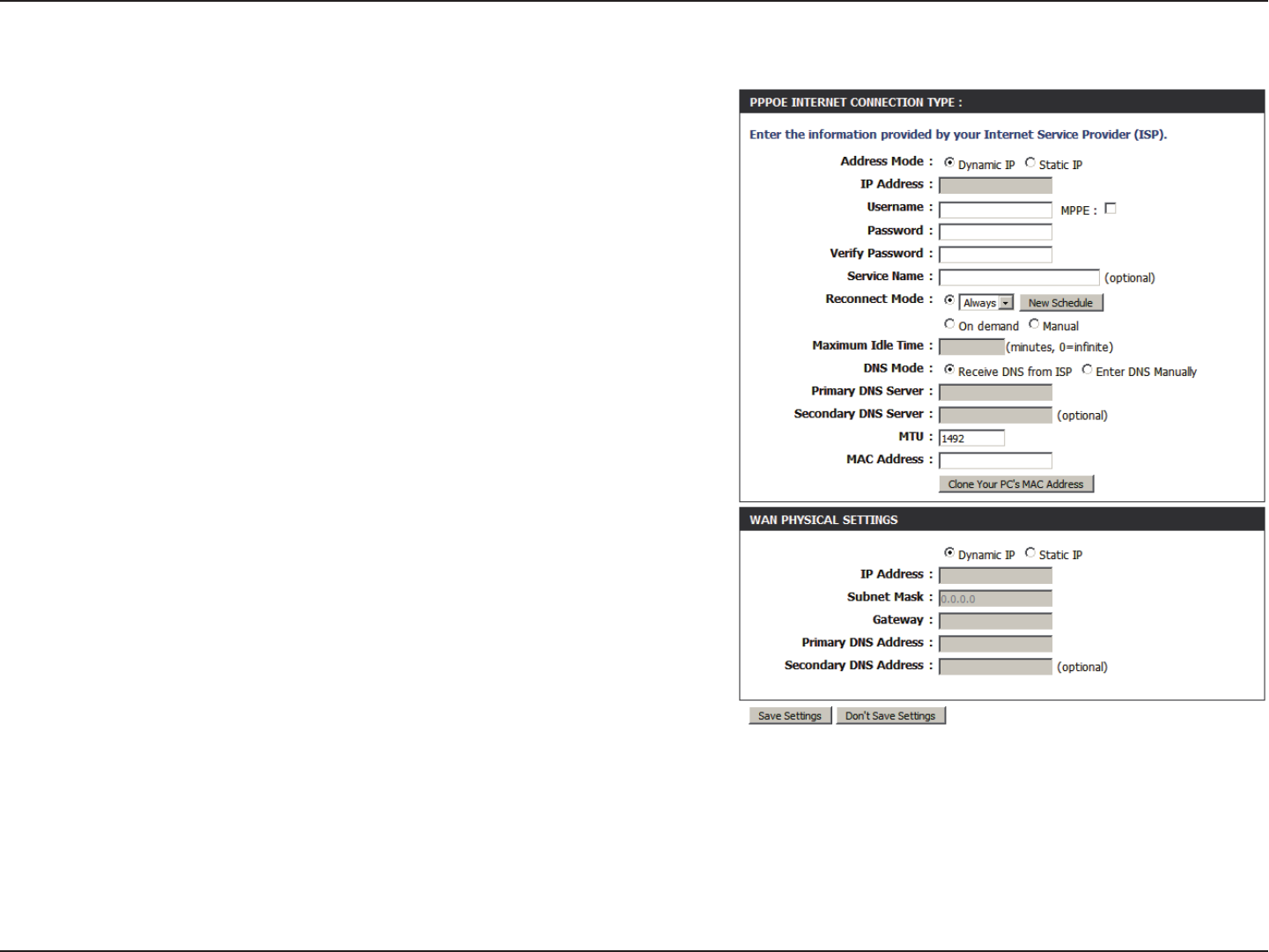
23D-Link DIR-456U User Manual
Section 3 - Configuration
Russia PPPoE (Dual Access)
Choose this Internet connection if you are using PPPoE in Russia.
Choose Static IP only if your ISP assigns you an
IP address. Otherwise, please choose Dynamic IP.
(Optional) Fill in if provided by your ISP. If not, keep
the default value.
The username/account name that your ISP provides
to you for PPPoE dial-up.
Password that your ISP provides to you for PPPoE
dial-up.
(Optional) Enter the service name.
Always - The connection will always be on.
Schedule - The connection run according to a
specied schedule.
On demand - The router will reconnect when
needed.
Manual - The router will reconnect only
when the user initiates a connection.
The amount of time of inactivity before disconnecting
established PPPoE session. Setting it to zero or
enabling Auto-reconnect will disable this feature.
You may choose Receive DNS from ISP or Enter DNS Manually.
(Optional) Fill in with IP address of primary DNS server.
(Optional) Fill in with IP address of secondary DNS server.
Address Mode:
IP Address:
Username:
Password:
Verify Password:
Service Name:
Reconnect Mode:
Maximum Idle Time:
DNS Mode:
Primary DNS Server:
Secondary DNS Server:
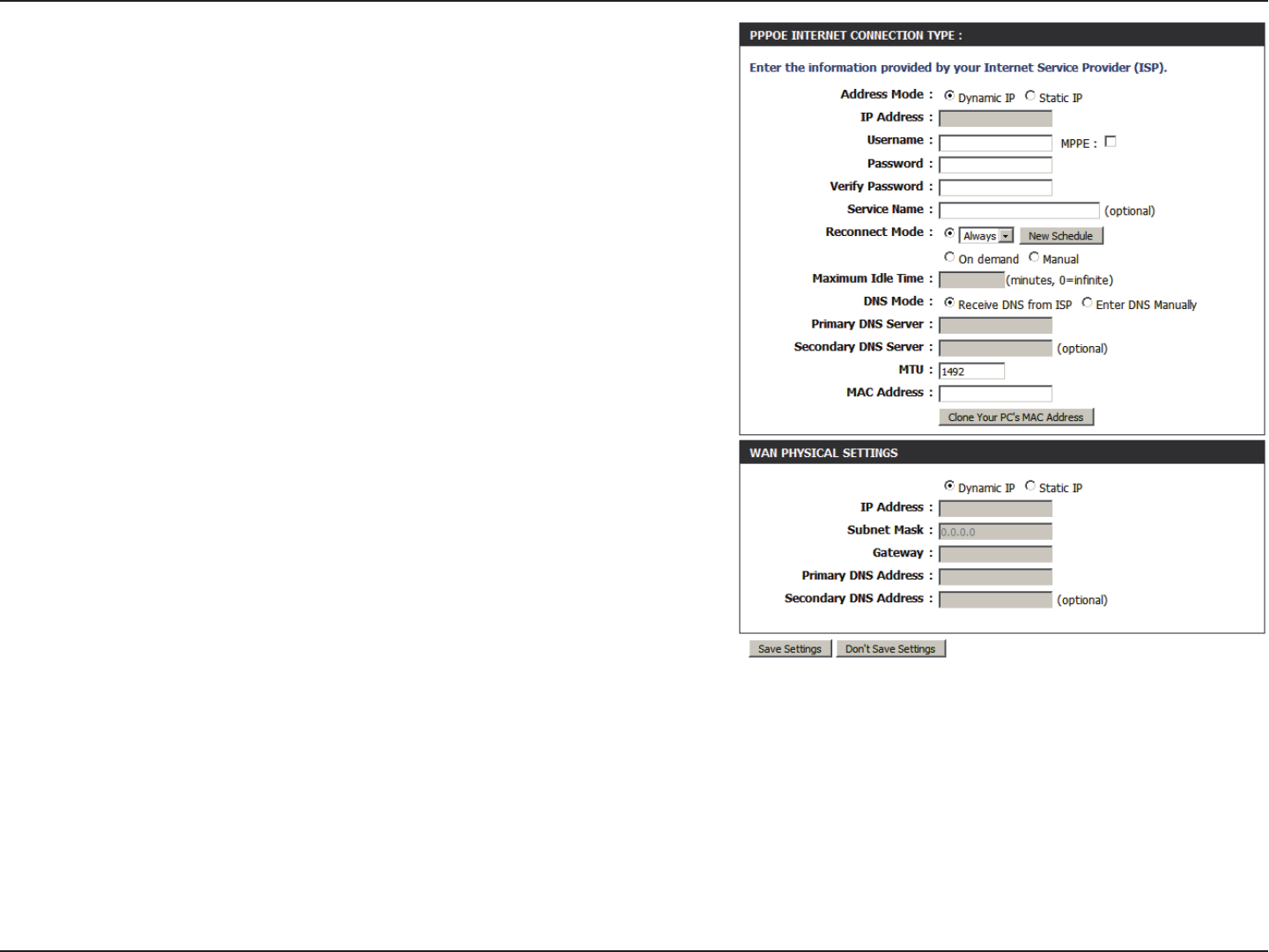
24D-Link DIR-456U User Manual
Section 3 - Configuration
You may need to change the Maximum Transmission
Unit (MTU) for optimal performance. The default
value is 1492.
The default MAC Address is set to the Internet port’s
physical interface MAC address on the Broadband
Router. It is not recommended that you change the
default MAC address unless required by your ISP.
You can use the Clone Your PC’s MAC Address
button to replace the Internet port’s MAC address
with the MAC address of your PC.
WAN PHYSICAL SETTINGS
Choose Static IP only if your ISP assigns you an
IP address. Otherwise, please choose Dynamic IP.
(Optional) Fill in if provided by your ISP. If not, keep
the default value.
Enter the Subnet Mask of the router. The default
subnet mask is 255.255.255.0.
Enter the default gateway.
(Optional) Fill in with IP address of primary DNS
server.
(Optional) Fill in with IP address of secondary DNS server.
Maximum Transmission
Unit (MTU):
MAC Address:
Address Mode:
IP Address:
Subnet Mask:
Gateway:
Primary DNS Address:
Secondary DNS Address:
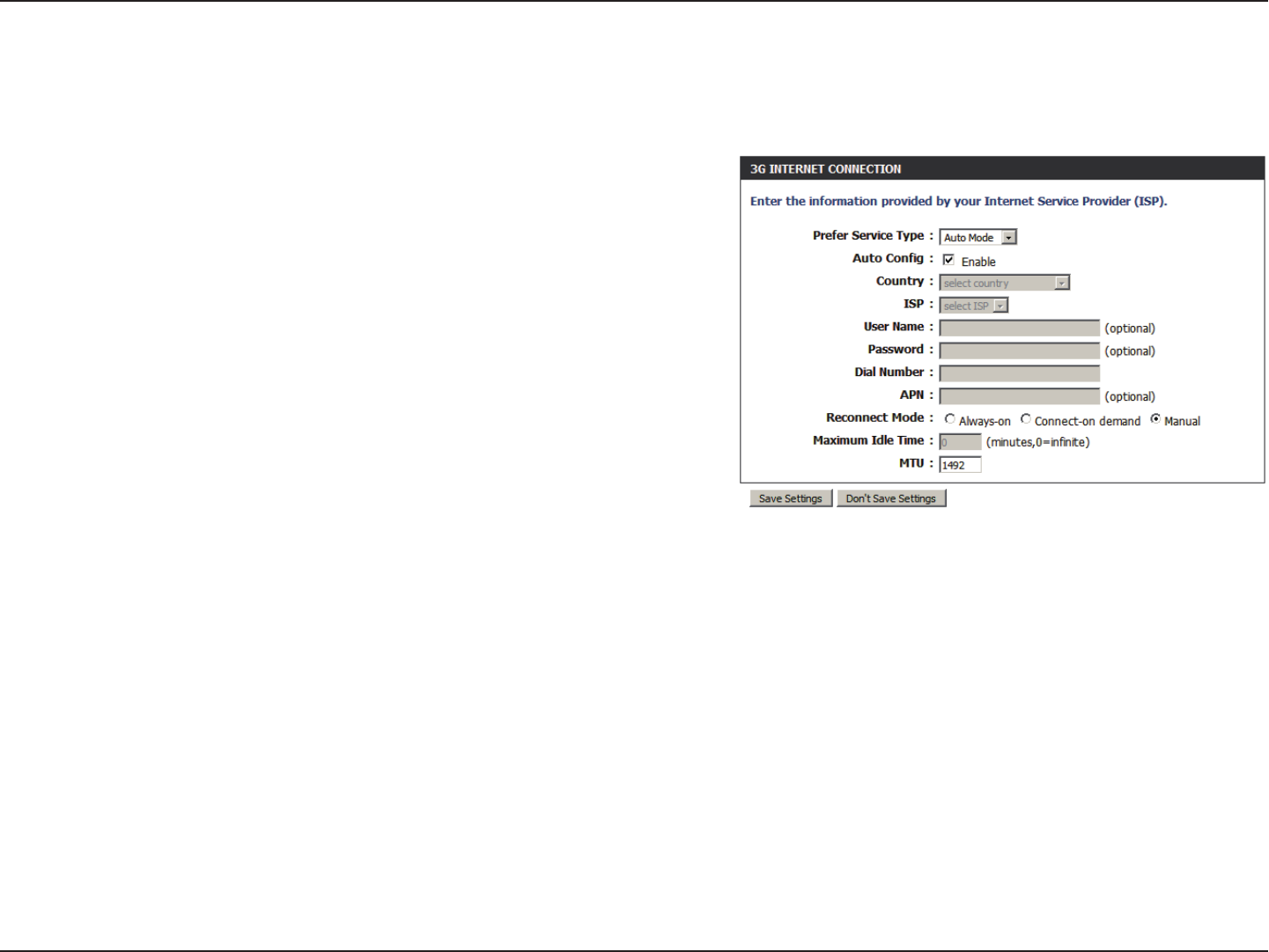
25D-Link DIR-456U User Manual
Section 3 - Configuration
You may select GPRS/EDGE or WCDMA as the
preferred service type.
Select this box to enable automatic conguration.
Select your country.
Select your ISP.
(Optional) Fill in only if requested by your ISP.
(Optional) Fill in only if requested by your ISP.
Enter the number to be dialed.
(Optional) Enter the APN information.
You may select from the following option:
Always-on - The 3G connection will always be on.
Connect on demand - The router will reconnect when needed.
Manual - The router will reconnect only when the user initiates a connection.
The default value for 3G is 1492.
Click Save Settings to save your changes, or click Don’t Save Settings to discard your changes.
Prefer Service Type:
Auto Config:
Country:
ISP:
User Name:
Password:
Dial Number:
APN:
Reconnect Mode:
MTU (Maximum
Transmission Unit:
3G Internet
Choose this Internet connection if you already apply a SIM card for 3G Internet service from Telecom company. The elds here may not
be necessary for your connection. The information on this page is only be used when your service provider requires.
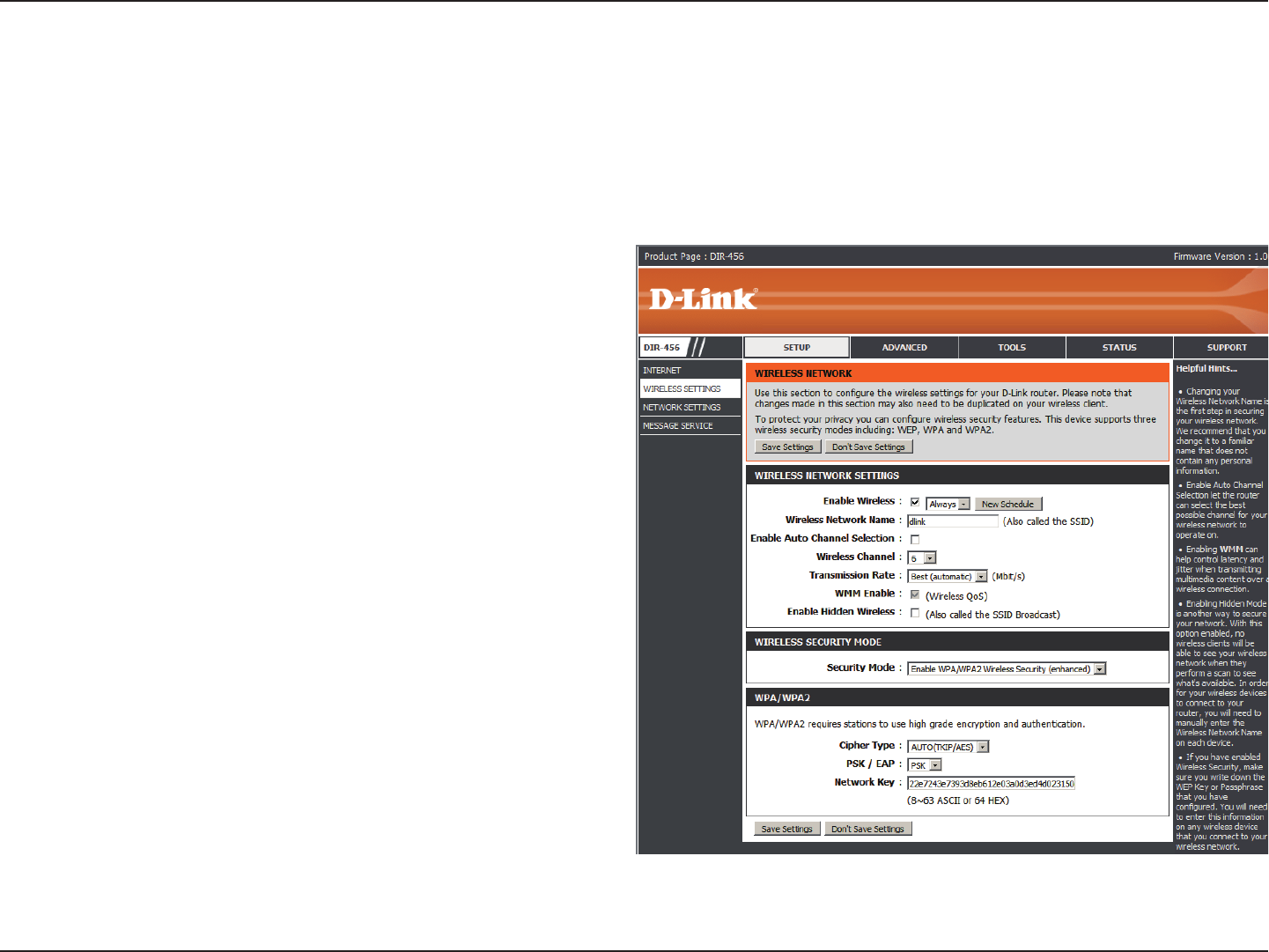
26D-Link DIR-456U User Manual
Section 3 - Configuration
WIRELESS NETWORK SETTINGS
Select this checkbox to enable wireless
access. When you set this option, the
following parameters take effect.
Also known as the SSID (Service
Set Identifier), this is the name of
your Wireless Local Area Network
(WLAN). Enter a name using up to 32
alphanumeric characters. The SSID is
case-sensitive.
A wireless network uses specific
channels in the wireless spectrum to
handle communication between clients.
Some channels in your area may
experience interference from other
electronic devices. Choose the clearest
channel to help optimize the performance
and coverage of your wireless network.
Click Save Settings to save your
changes, or click Don’t Save Settings
to discard your changes.
Enable Wireless:
Wireless Network Name:
Auto Channel Scan:
Wireless Settings
This section will help you to manually congure the wireless settings of your router. Please note that changes made on this section may
also need to be duplicated on your Wireless Client.
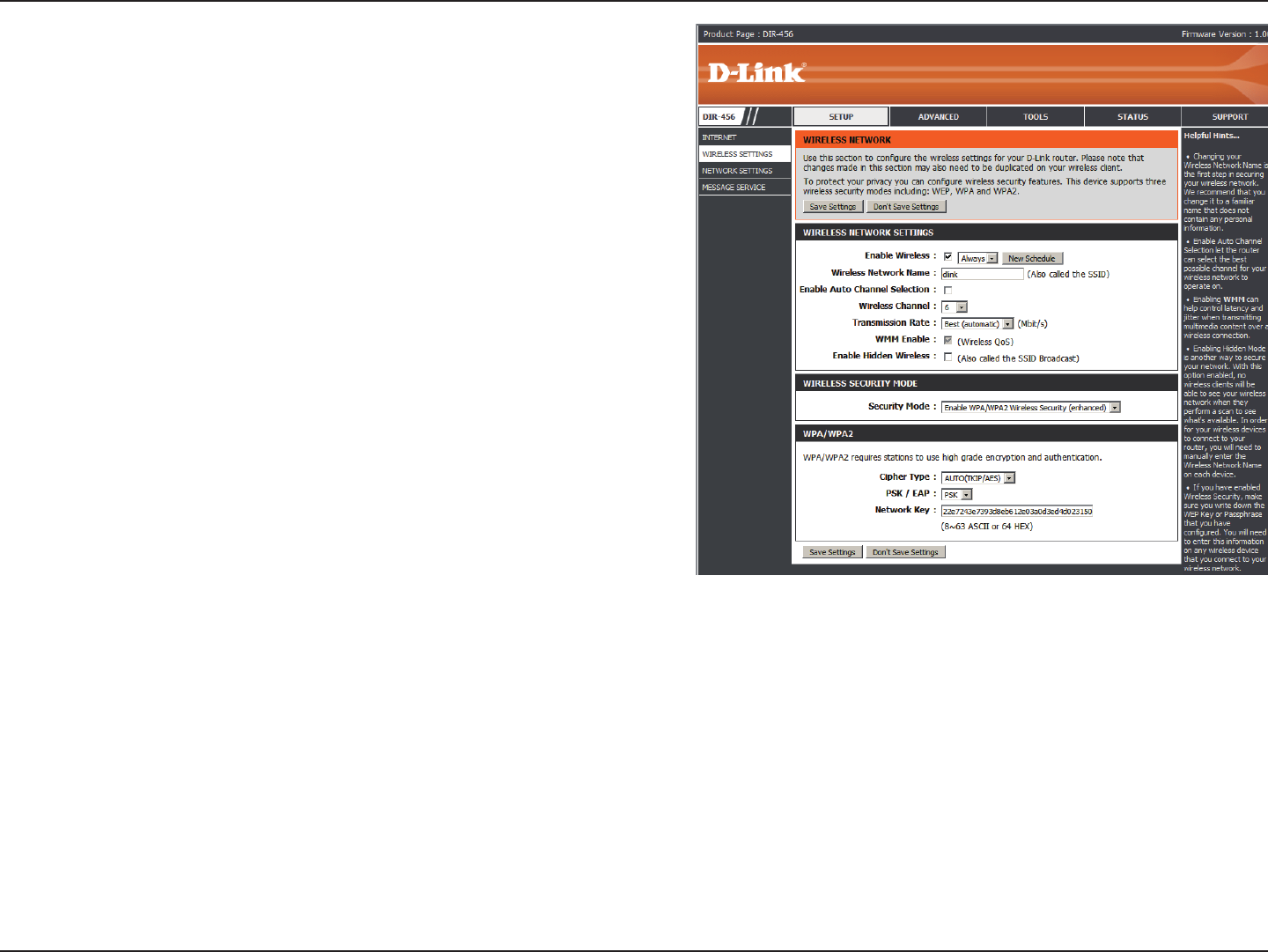
27D-Link DIR-456U User Manual
Section 3 - Configuration
Indicates the channel setting for the DIR-
456U. By default the channel is set to 11. This
can be changed to t the channel setting for
an existing wireless network or to customize
your wireless network. Click Auto Channel
Scan to automatically select the channel that
it will operate on. This option is recommended
because the router will choose the channel with
the least amount of interference.
Select Invisible if you do not want the SSID
of your wireless network to be broadcasted by
DIR-456U. The SSID of your router will not be
seen by Site Survey utilities. Therefore while
setting up your wireless clients, you will have
to manually enter your SSID to connect to the
router.
WIRELESS SECURITY MODE
This device supports three wireless security
mo d es, WEP, WPA-Pe r s o nal, WP A -
Enterprise or None. WEP is the original
wireless encryption standard. WPA provides a higher level of security and WPA-Personal does not require an
authentication server. When WPA enterprise is enabled, the router uses EAP (802.1x) to authenticate clients
via a remote RADIUS server.
IP address of RADIUS server.
The port used for RADIUS server. The default port is 1812.
Key value shared by RADIUS server and this device.
Please refer to Section 4 - Wireless Security for more information on security and encryption.
Click Save Settings to save your changes, or click Don’t Save Settings to discard your changes.
Wireless Channel:
Visibility Status:
Security Mode:
Radius Server IP:
Radius Port:
Radius Shared Key:
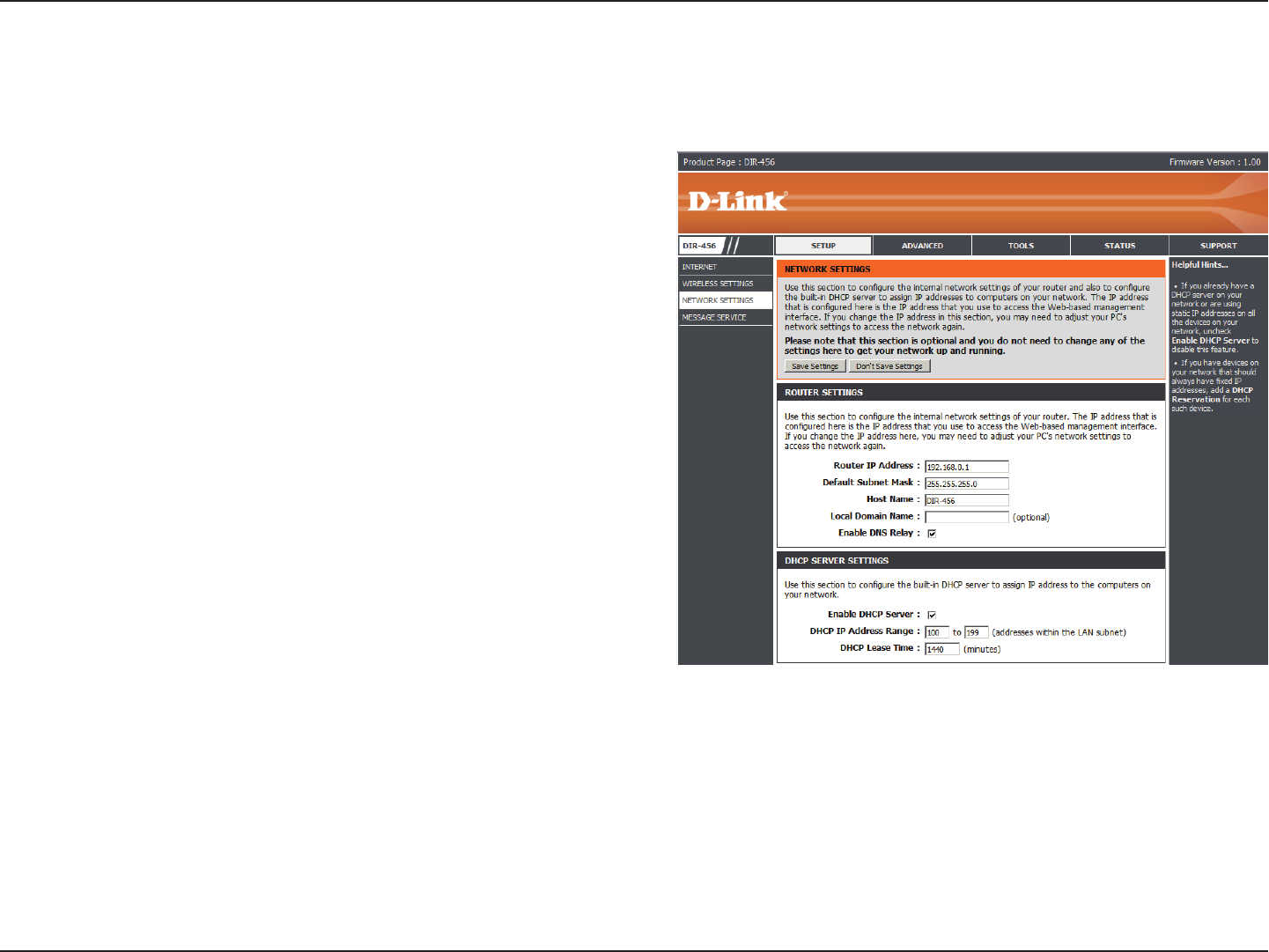
28D-Link DIR-456U User Manual
Section 3 - Configuration
This section will help you to change the internal network settings of your router and to congure the DHCP Server settings.
Network Settings
Router Settings
Enter the IP address of the router. The
default IP address is 192.168.0.1.
If you change the IP address, you will need
to enter the new IP address in your browser
to get into the conguration utility.
Enter the Subnet Mask of the router. The
default subnet mask is 255.255.255.0.
Enter the local domain name for your
network.
Click Save Settings to save your changes,
or click Don’t Save Settings to discard
your changes.
Router IP Address:
Default Subnet Mask:
Local Domain Name:
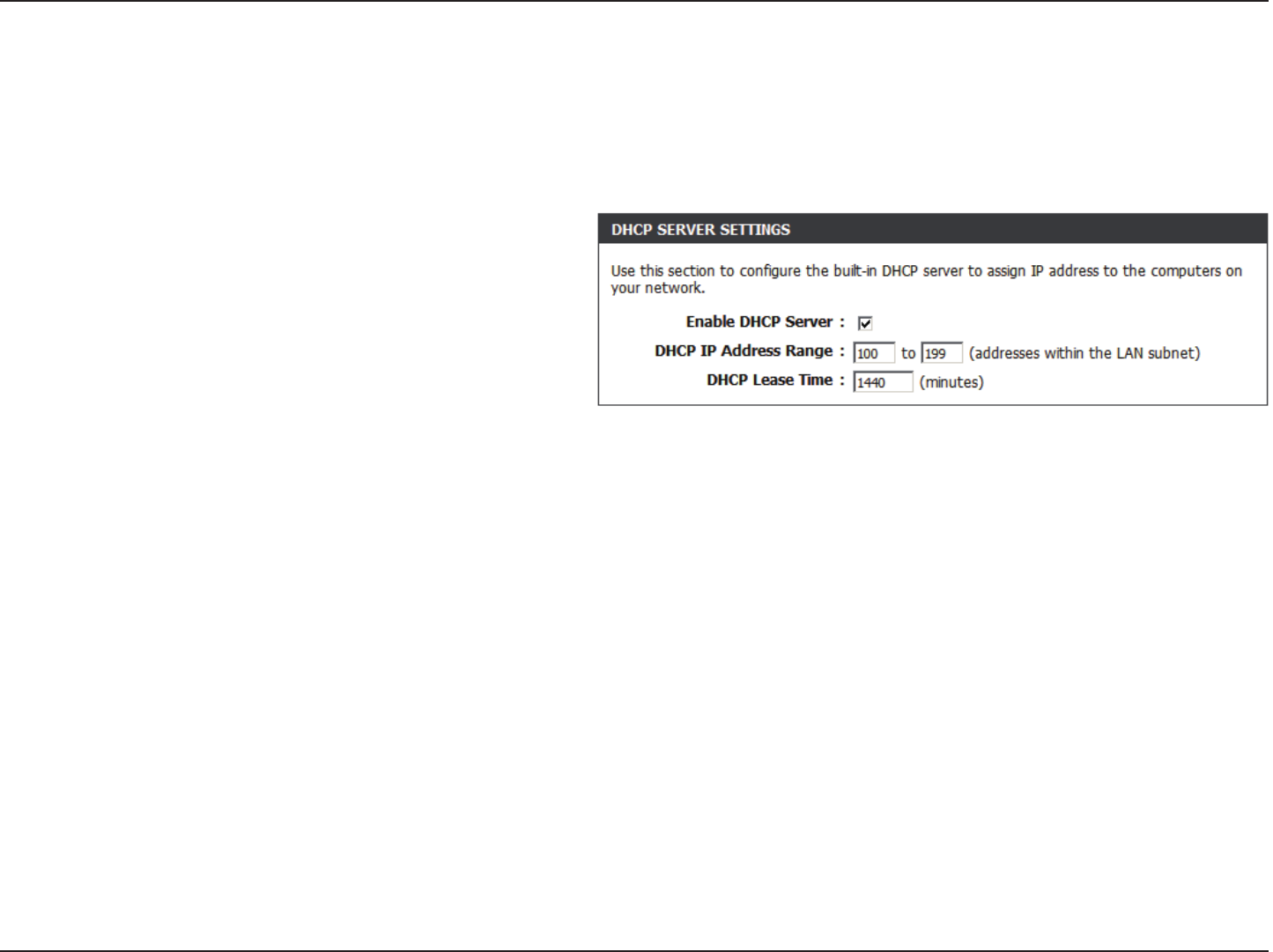
29D-Link DIR-456U User Manual
Section 3 - Configuration
Select this box to enable the DHCP
server on your router.
Enter the starting and ending
IP address for the server’s IP
assignment.
The time period for the IP address
lease. Enter the Lease time in
minutes.
Click Save Settings to save your changes, or click Don’t Save Settings to discard your changes.
Enable DHCP Server:
DHCP IP Address Range:
DHCP Lease Time:
DHCP Server Settings
The DIR-456U has a built-in DHCP (Dynamic Host Control Protocol) server. The DHCP server assigns IP addresses to devices on the
network that request them. By default, the DHCP Server is enabled on the device. The DHCP address pool contains a range of IP addresses,
which is automatically assigned to the clients on the network.
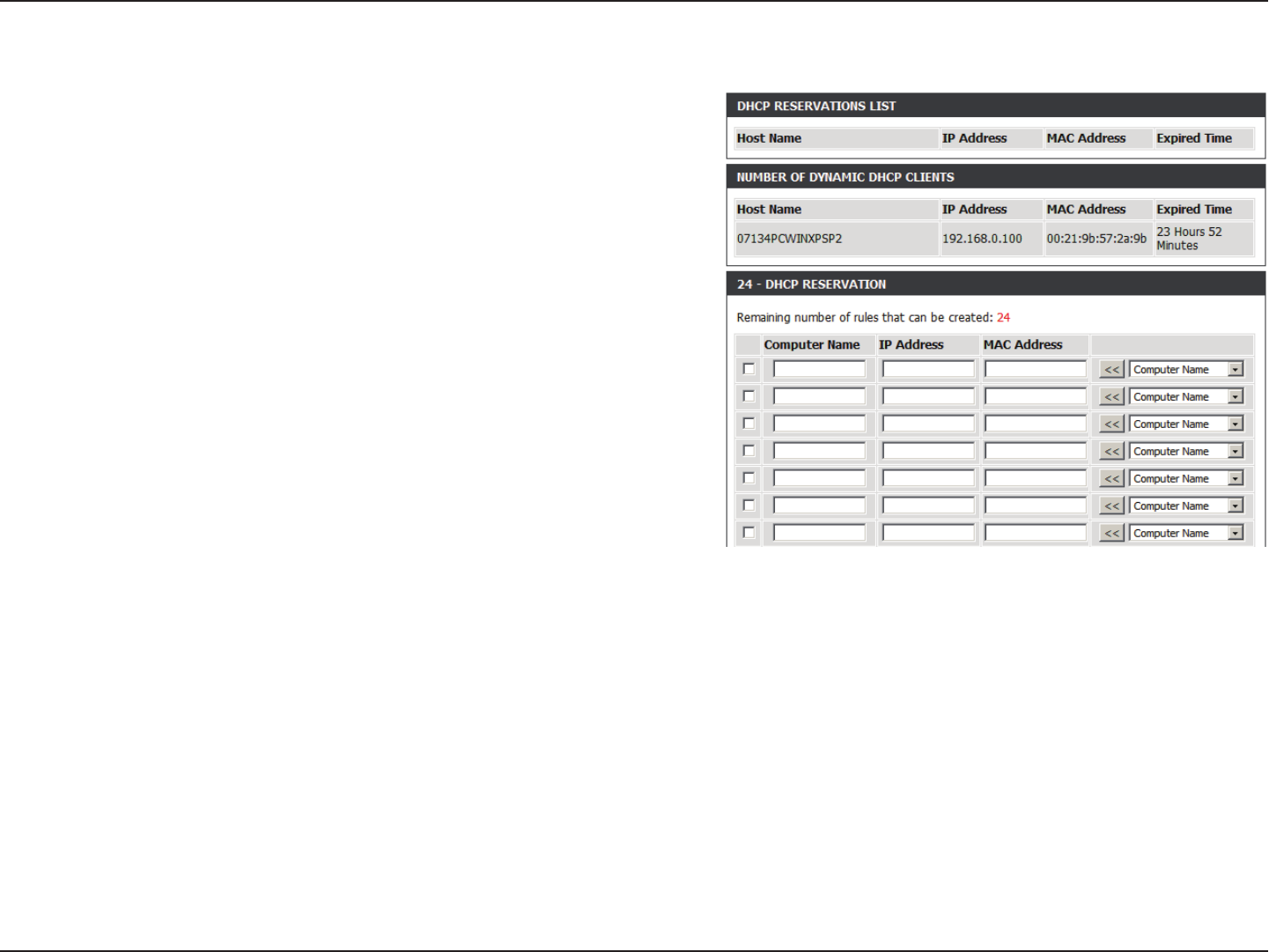
30D-Link DIR-456U User Manual
Section 3 - Configuration
Select the box next to the computer name to
enable the DHCP reservation.
Species the name of the workstation.
Species IP Address of the workstation.
Species the MAC Address of workstation.
Click Save Settings to save your changes, or click
Don’t Save Settings to discard your changes.
DHCP Reservations
Enable:
Computer Name:
IP Address:
MAC Address:
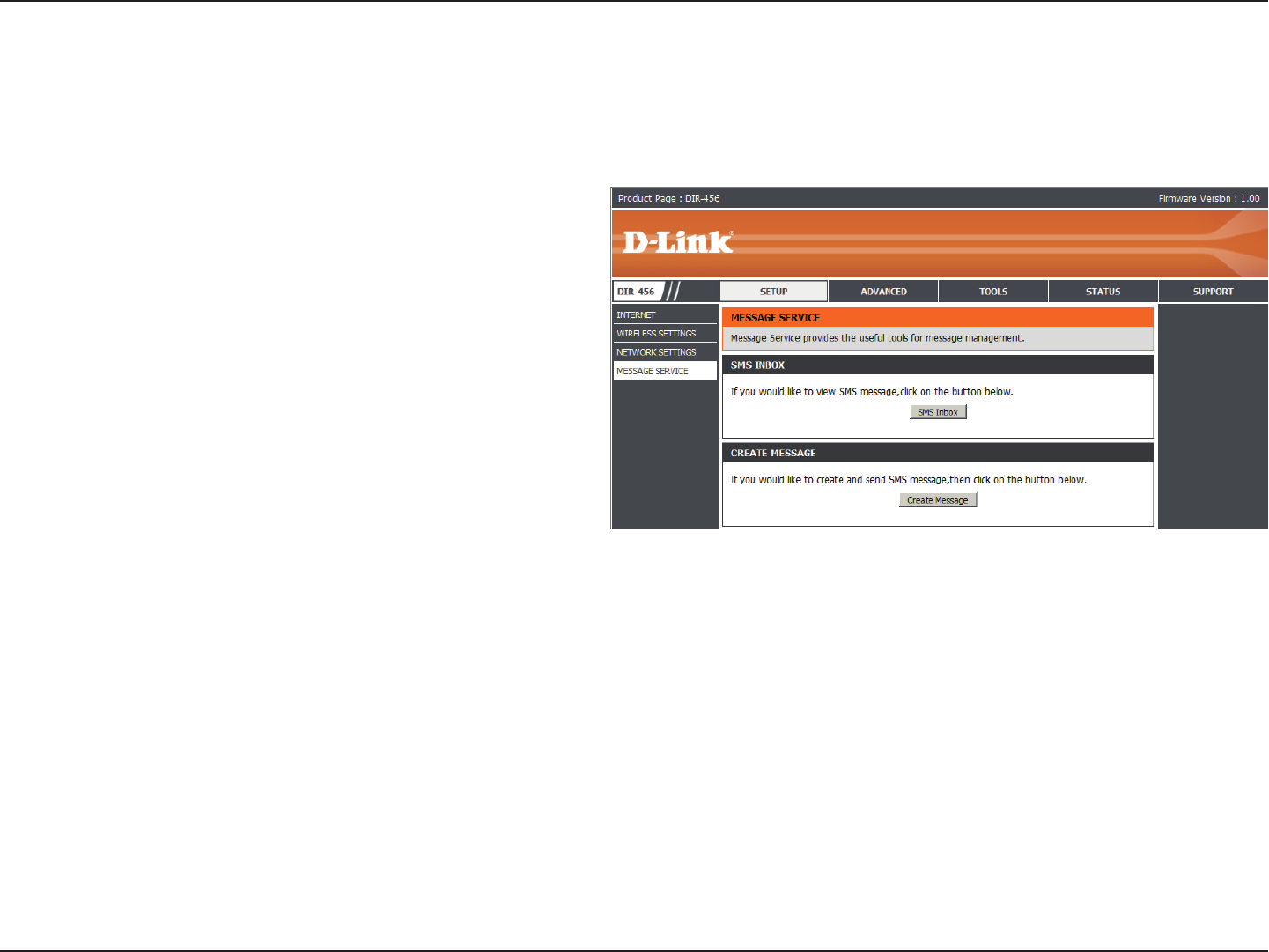
31D-Link DIR-456U User Manual
Section 3 - Configuration
SMS INBOX
Click this button to view any SMS
message that you may have
received.
CREATE MESSAGE
Click this button to create a
message.
Message Service
SMS Inbox:
Create Message:
If your ISP provide SMS service, you can create new messages, and manage your messages from this page.
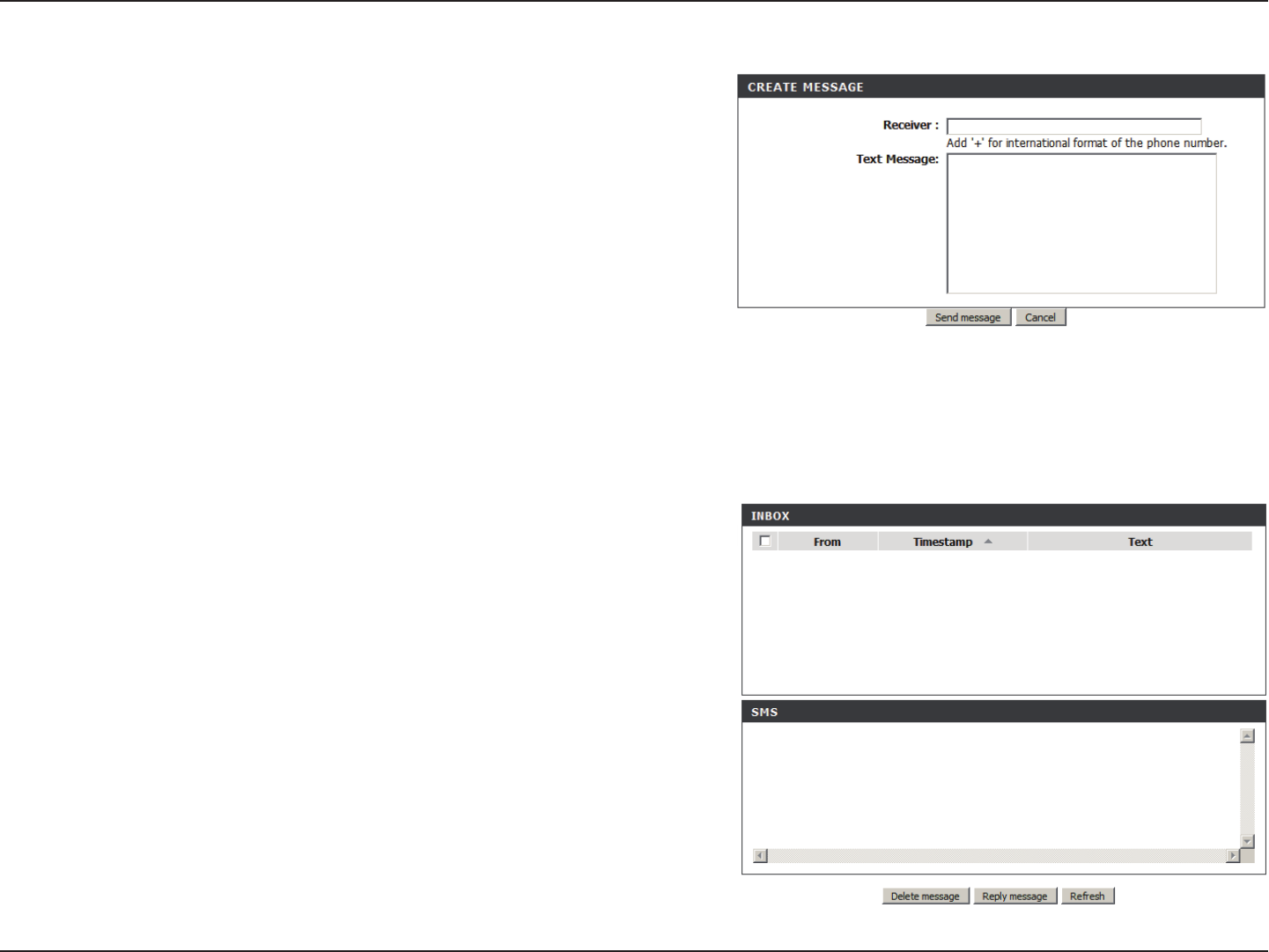
32D-Link DIR-456U User Manual
Section 3 - Configuration
CREATE MESSAGE
This page allows you to send an SMS to your
contacts. Just fill in the phone number of the
recipient, and type the content of message. Then
push the “Send Message” button to send out this
message. If you would like to add more than one
recipient, you must put a semicolon (;) between
each of the phone numbers.
Type the phone number of the recipient.
Type the message that you would like to send.
Click this button to send the message.
Click this button to cancel message input.
INBOX
This page shows all messages that are stored on
the SIM card. Selecting a message, and the content
will be shown in the SMS window. After you read it,
you can delete it, or reply to the sender. Push the
“Refresh” button to update the list.
SMS
Deletes the selected SMS message.
Replies to the selected SMS message.
Click this button to check for new messages.
Receiver:
Text Message:
Sent Message:
Cancel:
Delete Message:
Reply Message:
Refresh:
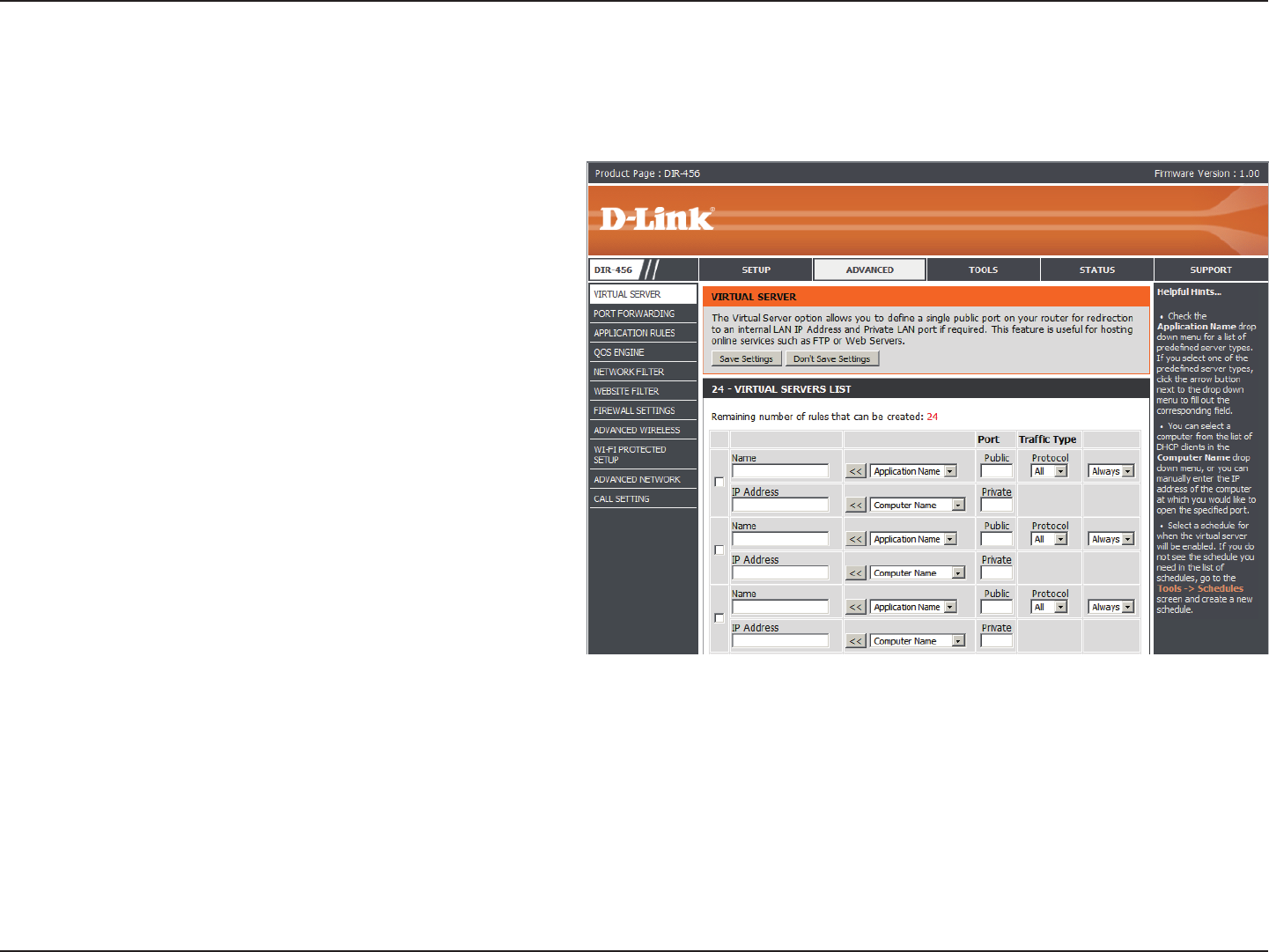
33D-Link DIR-456U User Manual
Section 3 - Configuration
Virtual Server
The device can be congured as a virtual server so that users can access services such as Web or FTP via the public (WAN) IP address
of the router.
You may select Always On or
choose the number of a schedule
rule that you have dened.
VIRTUAL SERVERS LIST
Identies the virtual server.
Enter the last digits of the IP
address of the computer on your
local network that you want to allow
the incoming service. In the next
box, enter the port number that you
would like to open.
Select this box to enable the rule.
Specify the schedule rule
number.
Click Save Settings to save your changes, or click Don’t Save Settings to discard your changes.
Use schedule rule:
ID:
Server IP: Port:
Enable:
Schedule Rule #:
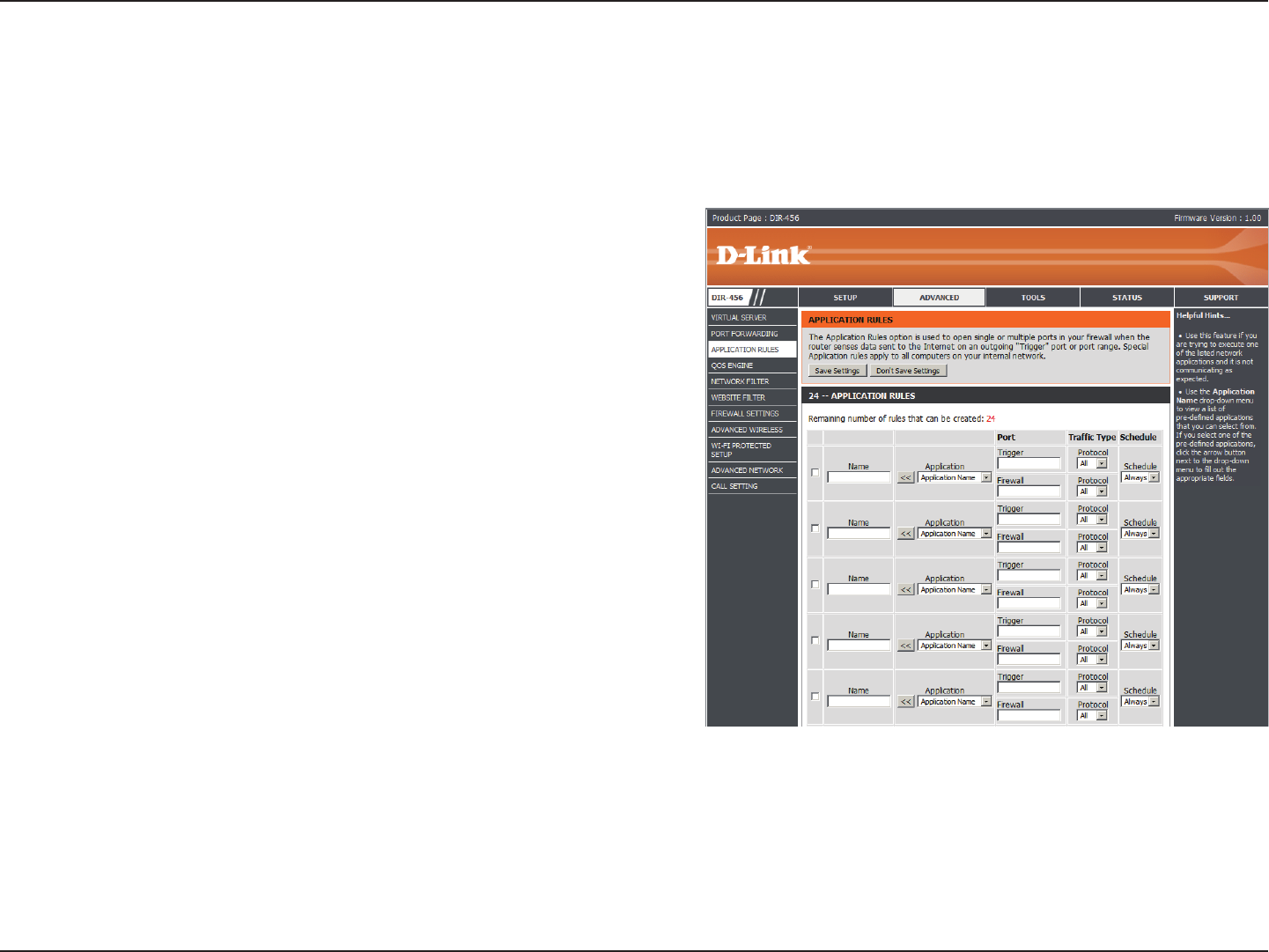
34D-Link DIR-456U User Manual
Section 3 - Configuration
Application Rules
Some applications require multiple connections, such as Internet gaming, video conferencing, Internet telephony and others. These
applications have difculties working through NAT (Network Address Translation). Applications Rules allow some of these applications
work with the DIR-456U.
APPLICATION RULES
Select this box to enable the rule.
Enter a name for the rule.
Select from a list of popular applications.
The name of the trigger.
The port that will be used on your internal
network.
The port that will be accessed from the
Internet.
Select TCP or UDP.
Specify whether the rule should always be
active, or active according a predefined
schedule.
Click Save Settings to save your changes,
or click Don’t Save Settings to discard your
changes.
Enable:
Name:
Applications:
Trigger:
Trigger:
Firewall:
Protocol:
Schedule:
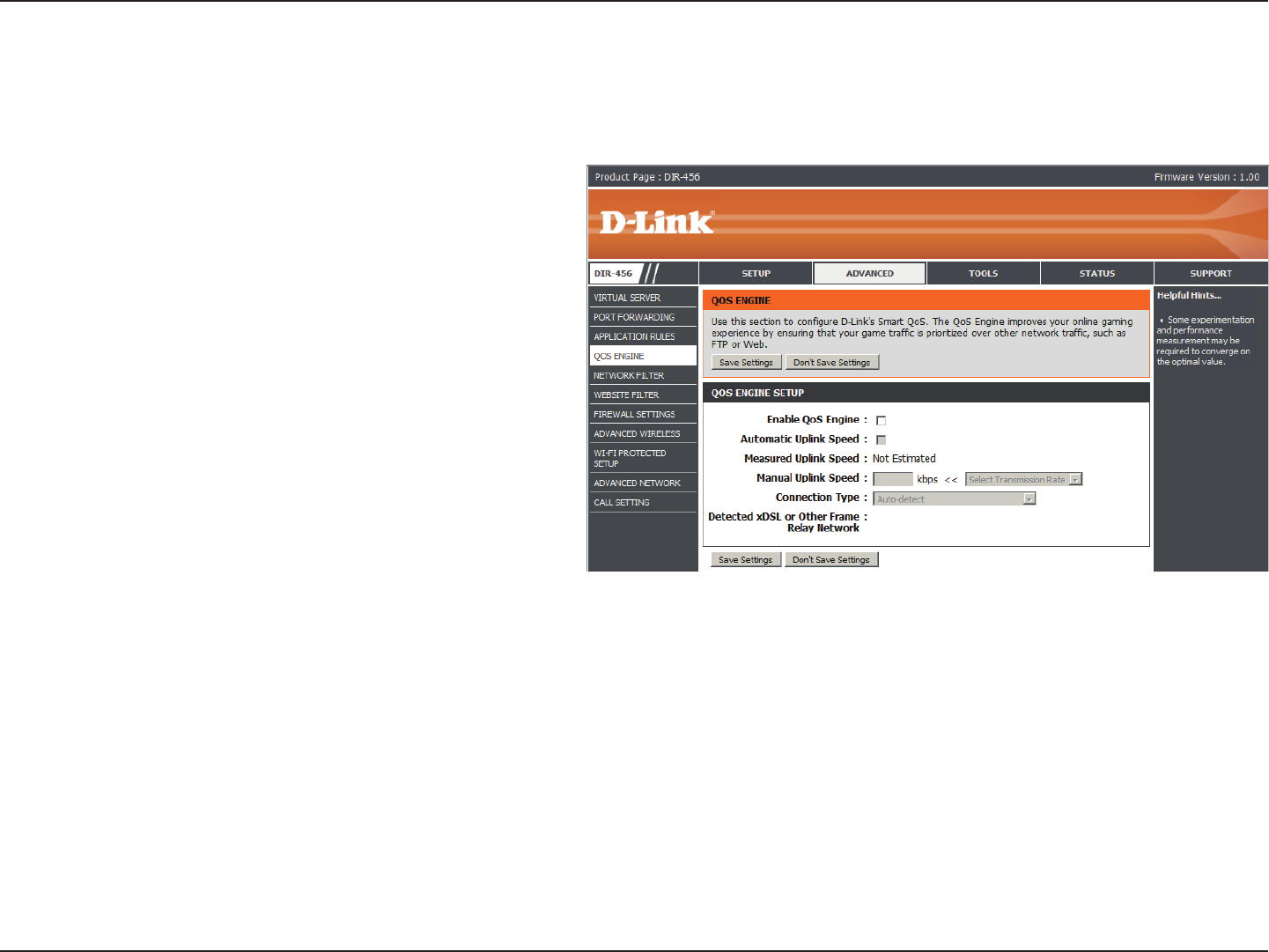
35D-Link DIR-456U User Manual
Section 3 - Configuration
QoS Engine
QoS ENGINE SETUP
Check this option if you want to
enable the QoS function.
Check this option to automatically
get the optimal performance.
This field displays the current
measured uplink speed here.
If the measured uplink speed is
not optimal, please disable the
Automatic Uplink Speed and
select the transmission rate from
drop-down menu.
You can choose auto-detect for the known connection type. Or choose xDSL or cable etc if you know what
connection type you use for the Internet network.
Click Save Settings to save your changes, or click Don’t Save Settings to discard your changes.
Enable QoS Engine:
Automatic Uplink Speed:
Measured Uplink Speed:
Manual Uplink Speed:
Connection Type:
The QoS Engine improves your online gaming experience by ensuring that your game trafc is prioritized over other network trafc, such
as FTP or Web. For best performance, use the Automatic Classication option to automatically set the priority for the applications.
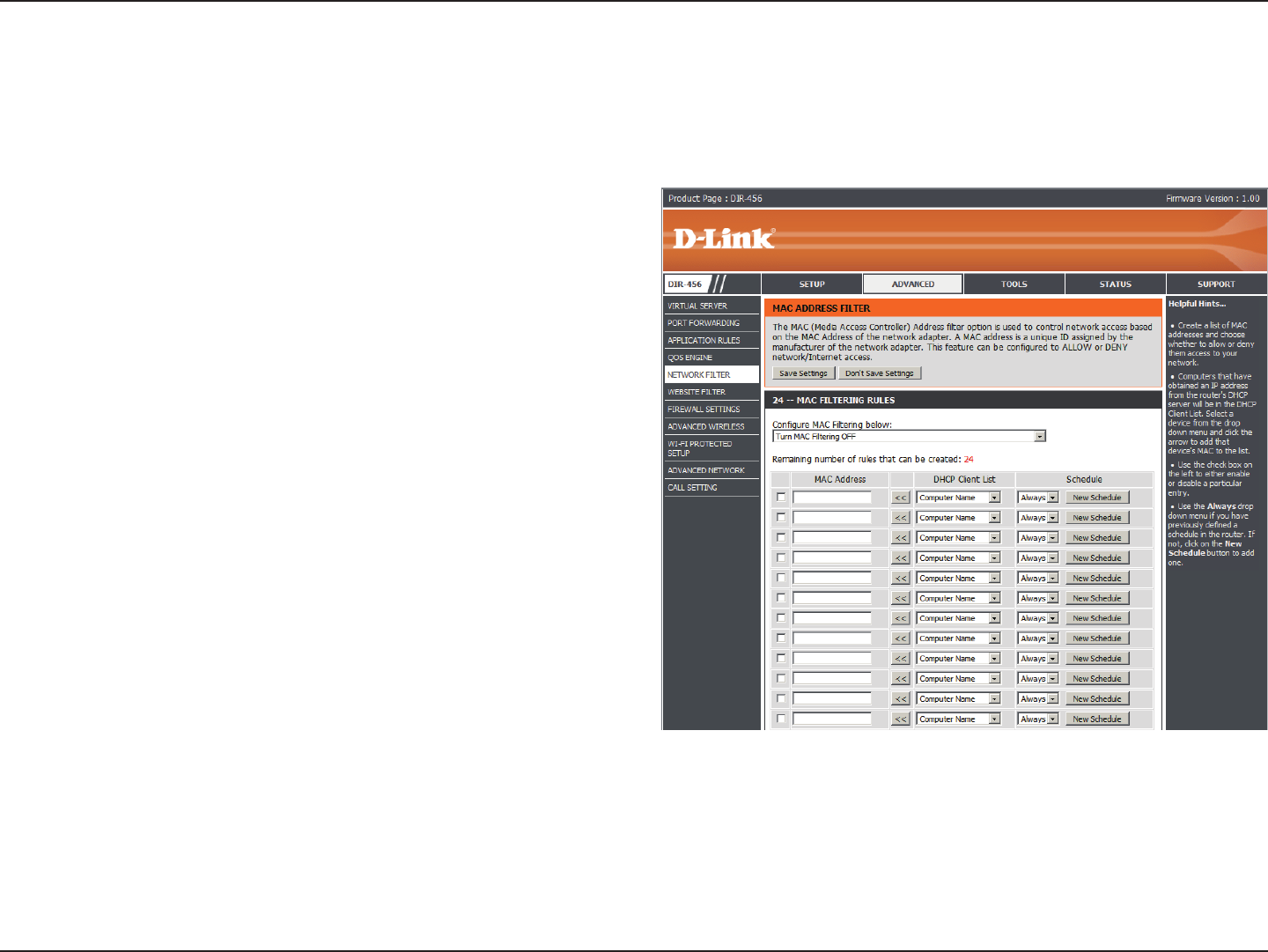
36D-Link DIR-456U User Manual
Section 3 - Configuration
Network Filter
MAC FILTERING SETTINGS
Select this box to enable MAC Filtering.
The MAC address of the network device to
be added to the MAC Filter List.
DHCP clients will have their hostname in
the Computer Name drop down menu. You
can select the client computer you want to
add to the MAC Filter List and click arrow
button. This will automatically add that
computer’s MAC address to the appropriate
eld.
Click Save Settings to save your changes,
or click Don’t Save Settings to discard
your changes.
Enable:
MAC Address:
DHCP Client List:
The MAC (Media Access Controller) Address Filter option is used to control network access based on the MAC Address of the network
adapter. A MAC address is a unique ID assigned by the manufacturer of the network adapter. This feature can be congured to ALLOW
or DENY network/Internet access.
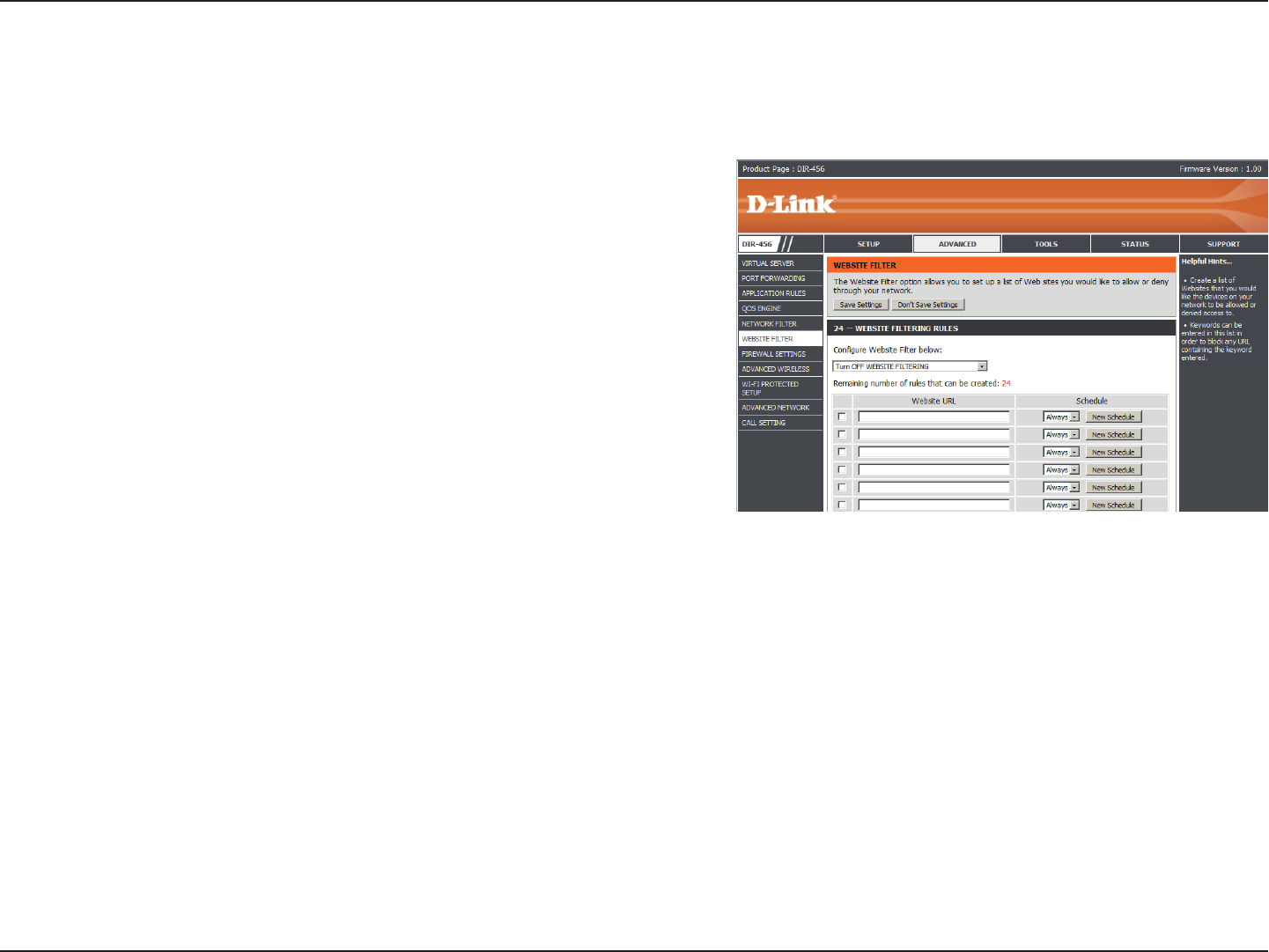
37D-Link DIR-456U User Manual
Section 3 - Configuration
WEBSITE FILTERING RULES
Specify the way website ltering should operate.
You may specify from the following:
- Turn OFF WEBSITE FILTERING
- ALLOW access to ONLY these sites
- DENY access to ONLY these sites
Enter the URLs that you would like to filter.
Select the checkbox next to the URL to enable
the URL.
Choose whether the lter should always be on, or
specify a schedule to use. Select New Schedule
to create a new schedule.
Click Save Settings to save your changes, or click Don’t Save Settings to discard your changes.
URL Filter allows you to set up a list of Web-sites that will be blocked from users on your network.
Website Filter
Configure Website Filter
Below:
Website URL:
Schedule:
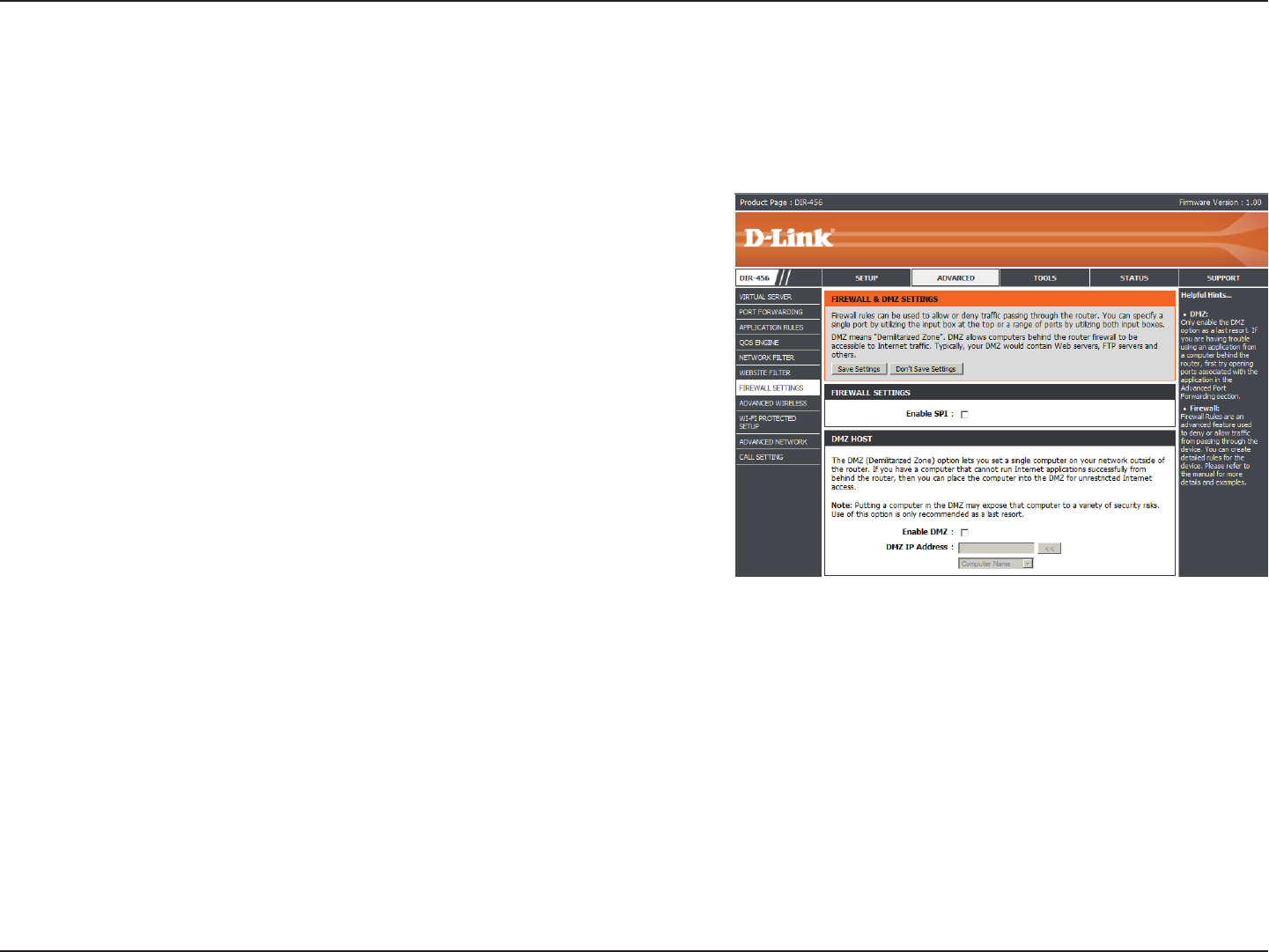
38D-Link DIR-456U User Manual
Section 3 - Configuration
FIREWALL SETTINGS
Select this box to enable Stateful Packet
Inspection (SPI).
DMZ HOST
Select this box to enable to the DMZ.
Select a computer from the dropdown box and
click the << button to display the IP address.
Firewall Settings
Firewall rules can be used to allow or deny trafc passing through the router. You can specify a single port by utilizing the input box at the
top or a range of ports by utilizing both input boxes. DMZ means “Demilitarized Zone.” DMZ allows computer behind the router rewall to
be accessible to Internet trafc. Typically, your DMZ would contain Web servers, FTP servers and others.
Enable SPI:
Enable DMZ:
DMZ IP Address:
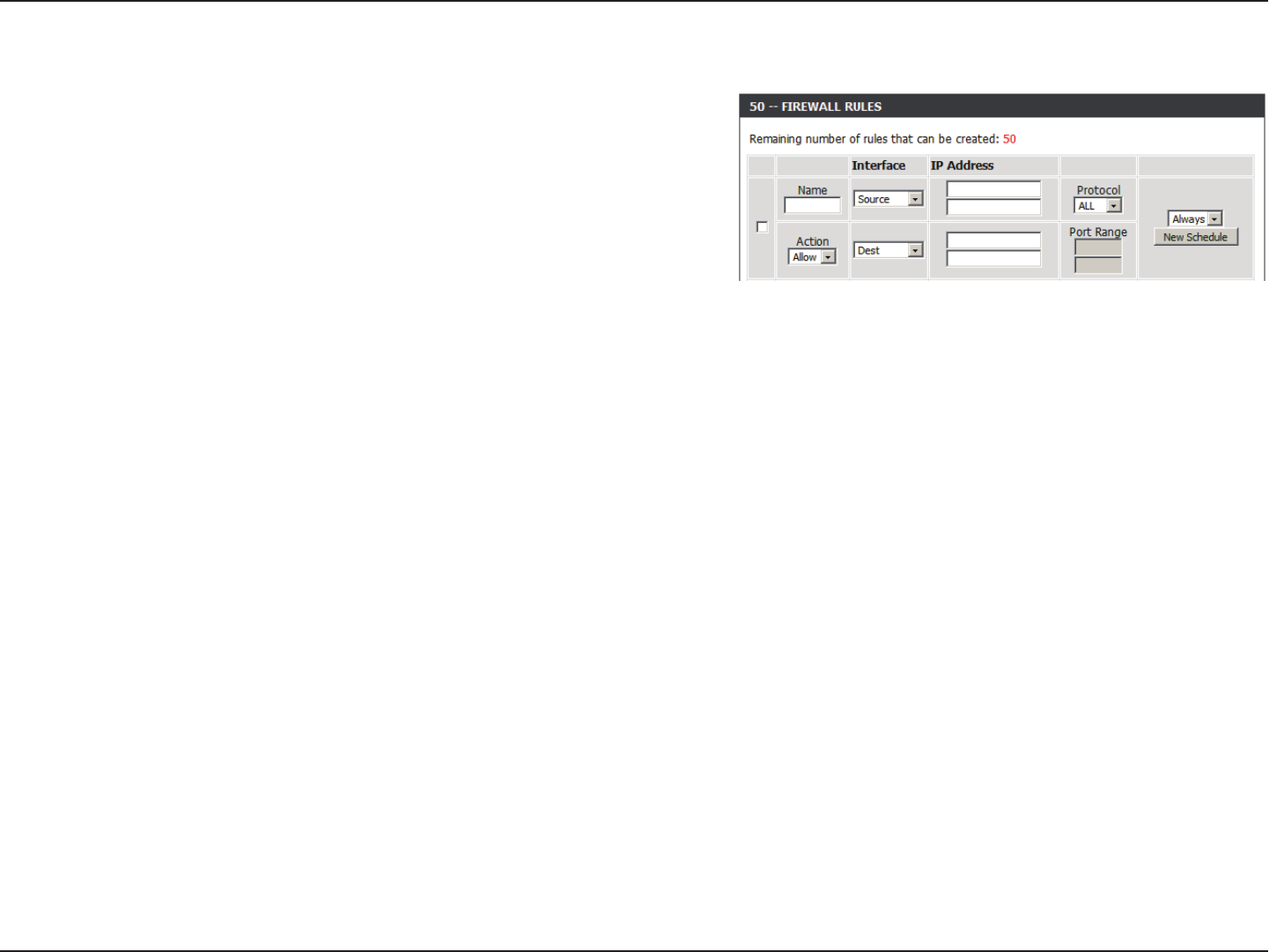
39D-Link DIR-456U User Manual
Section 3 - Configuration
FIREWALL RULES
Enter a name for the rule.
Specify the interface for the source and destination.
You may select LAN, WAN, or WAN(3G).
Enter the starting and ending IP address that you
wish to apply the rule to. If you are only applying this rule to one IP address, you may enter the same IP address
in both boxes.
Specify a protocol for the rule. You may select TCP, UDP, ICMP.
Specify whether to Allow or Deny access.
Specify the starting port and ending port.
Specify when the rule should be active. You may choose: Always or specify a schedule. Click New Schedule
to open the Schedules page.
Click Save Settings to save your changes, or click Don’t Save Settings to discard your changes.
Name:
Interface:
IP Address:
Protocol:
Action:
Port Range:
Schedule:
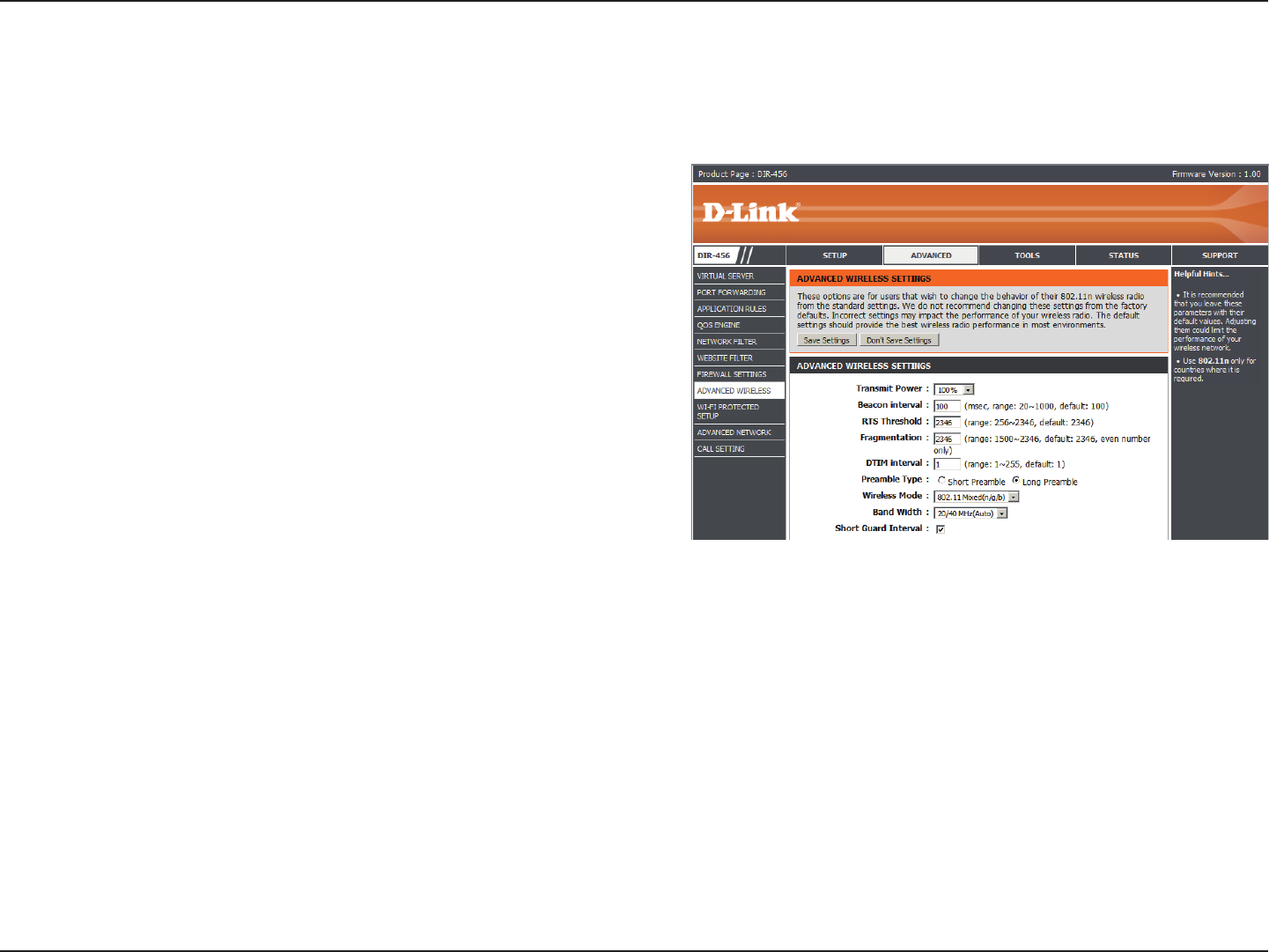
40D-Link DIR-456U User Manual
Section 3 - Configuration
You can lower the output power of the router
by selecting lower percentage Transmit Power
values from the drop down. Your choices are:
100%, 50%, 25%, and 12.5%.
Beacons are packets sent by an Access Point
to synchronize a wireless network. Specify a
Beacon interval value between 20 and 1000.
The default value is set to 100 milliseconds.
This value should remain at its default setting of
2346. If you encounter inconsistent data ow,
only minor modications to the value range
between 256 and 2346 are recommended.
The default value for RTS Threshold is set to
2346.
This value should remain at its default setting of 2346. If you experience a high packet error rate, you may
slightly increase your “Fragmentation” value within the value range of 1500 to 2346. Setting the Fragmentation
value too low may result in poor performance.
Enter a value between 1 and 255 for the Delivery Trafc Indication Message (DTIM). A DTIM is a countdown
informing clients of the next window for listening to broadcast and multicast messages. When the Access
Point has buffered broadcast or multicast messages for associated clients, it sends the next DTIM with a DTIM
Interval value. AP clients hear the beacons and awaken to receive the broadcast and multicast messages. The
default value for DTIM interval is set to 1.
Transmit Power:
Beacon Interval:
RTS Threshold:
Fragmentation:
DTIM Interval:
Advanced Wireless
Advanced Wireless contains settings which can negatively affect the performance of your router if congured improperly. Do not change
these settings unless you are already familiar with them or have been instructed to make the change by one of our support personnel.

41D-Link DIR-456U User Manual
Section 3 - Configuration
The Preamble Type denes the length of the CRC (Cyclic Redundancy Check) block for communication
between the Access Point and roaming wireless adapters. Make sure to select the appropriate preamble type
and click the Apply button.
Note: High network trafc areas should use the shorter preamble type. CRC is a common technique for detecting
data transmission errors.
If all of the wireless devices you want to connect with this access point can connect in the same transmission
mode, you can improve performance slightly by choosing the appropriate “Only” mode. If you have some
devices that use a different transmission mode, choose the appropriate “Mixed” mode.
The “Auto 20/40 MHz” option is usually best. The other options are available for special circumstances.
Using a short guard interval can increase throughput. However, it can also increase error rate in some
installations, due to increased sensitivity to radio-frequency reections. Select the option that works best for
your installation .
Preamble Type:
Wireless Mode:
Band Width:
Short Guard
Interval:
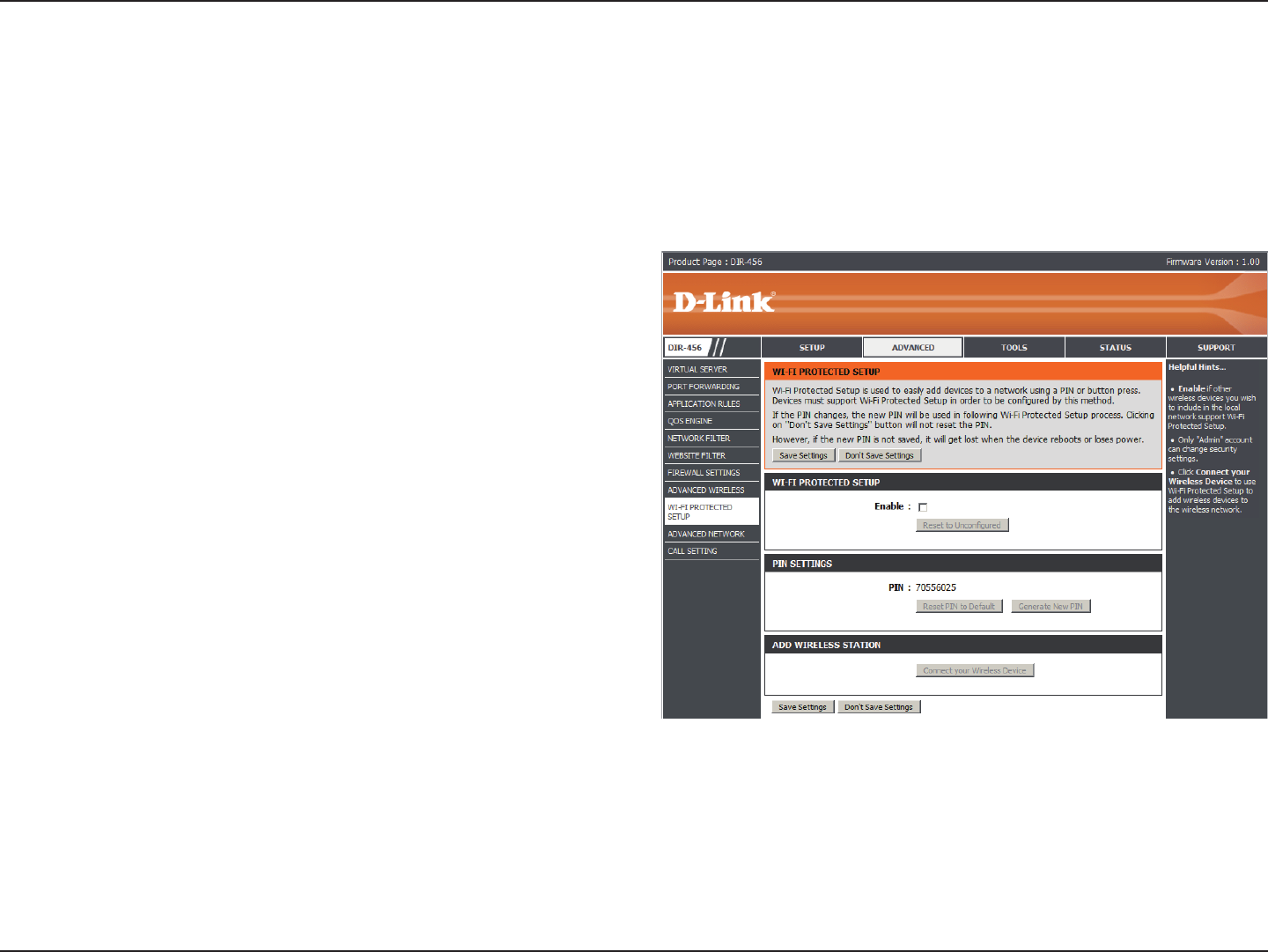
42D-Link DIR-456U User Manual
Section 3 - Configuration
WI-FI PROTECTED SETUP
Select this box to enable the WPS if
wireless devices you wish to include in
the local network support Wi-Fi Protected
Setup.
Only the “Admin” account can change
security settings.
Resets the PIN to the default number
shown on the device.
Generates a new PIN number for the
device.
Click Connect your Wireless Device
to add wireless devices to the wireless
network.
Click Save Settings to save your changes, or click Don’t Save Settings to discard your changes.
Wi-Fi Protected Setup
Enable:
PIN Settings:
Reset PIN to
Default:
Generate New PIN:
Add Wireless
Station:
Wi-Fi Protected Setup (WPS) is used to easily add devices to a network using a PIN or button press. Devices must support Wi-Fi Protected
Setup in order to be congured by this method.
If the PIN changes, the new PIN will be used in following Wi-Fi Protected Setup process. Clicking on “Don’t Save Settings” will not reset
the PIN. However, if the new PIN is not saved, it will be lost when the device reboots or loses power.
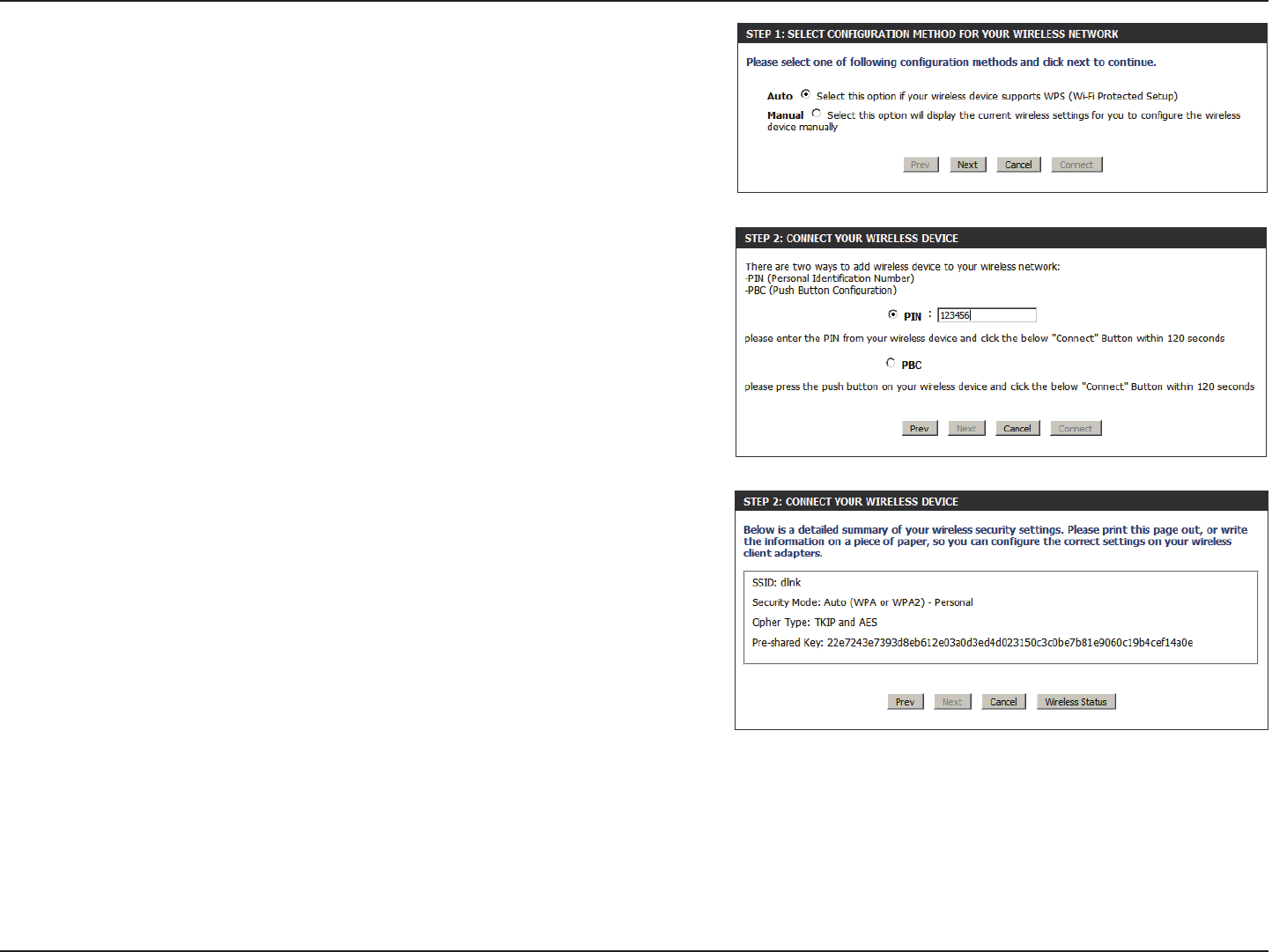
43D-Link DIR-456U User Manual
Section 3 - Configuration
STEP 1: SELECT CONFIGURATION METHOD
You may select Auto if your device supports WPS. You may select Manual
if you would like to view the current wireless setting for conguring your
device manually.
STEP 2: CONNECT YOUR WIRELESS DEVICE
If Auto conguration is chose, you will be given the option to add a wireless
device using a PIN, or using the Push Button Conguration (PBC).
PIN: Enter the PIN from your wireless device and click the Connect button
on your screen within 120 seconds.
PBC: Press the WPS button on your wireless device and click the Connect
button on your screen within 120 seconds.
If Manual Conguration is chosen, you will see a screen like the one shown
on the right.
Click Next to save your changes, or click Cancel to discard your changes.
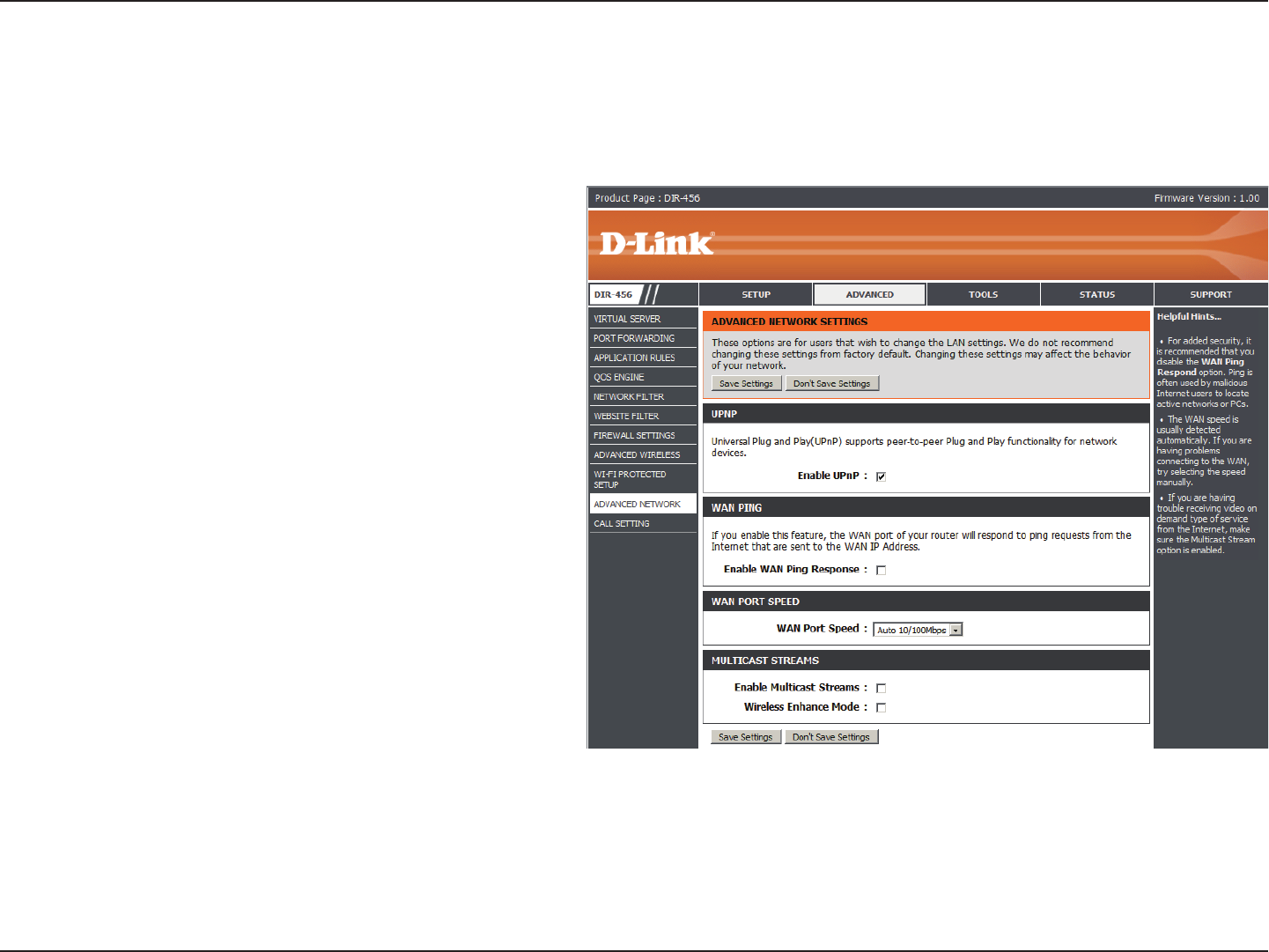
44D-Link DIR-456U User Manual
Section 3 - Configuration
UPnP is short for Universal Plug
and Play which is a networking
a r c h i t e c t u r e t h a t pr o v i d e s
compatibility among networking
equipment, software, and
peripherals. The device is a UPnP
enabled router, meaning it will work
with other UPnP devices/software.
If you do not want to use the UPnP
functionality, it can be disabled by
selecting “Disabled”.
When you Enable WAN Ping
respond, you are causing the public
WAN (Wide Area Network) IP
address on the device to respond
to ping commands sent by Internet
users. Pinging public WAN IP
addresses is a common method
used by hackers to test whether
your WAN IP address is valid.
Advanced Network
Advanced Network contains settings which can change the way the router handles certain types of trafc. We recommend that you do
not change any of these settings unless you are already familiar with them or have been instructed to make the change by one of our
support personnel.
Enable UPnP:
Enable WAN Ping Respond:

45D-Link DIR-456U User Manual
Section 3 - Configuration
This allows you to select the speed of the WAN interface of the router. You may select 100Mbps, 10Mbps, or
10/100Mbps Auto.
Enable this option to allow Multicast trafc to pass from the Internet to your network more efciently.
Enable this option if you are receiving video on demand type of service from the Internet. The router uses the
IGMP protocol to support efcient multicasting -- transmission of identical content, such as multimedia, from
a source to a number of recipients. This option must be enabled if any applications on the LAN participate
in a multicast group. If you have a multimedia LAN application that is not receiving content as expected, try
enabling this option.
Click Save Settings to save your changes, or click Don’t Save Settings to discard your changes.
WAN Port Speed:
Multicast Streams:
Enable Multicast Streams:
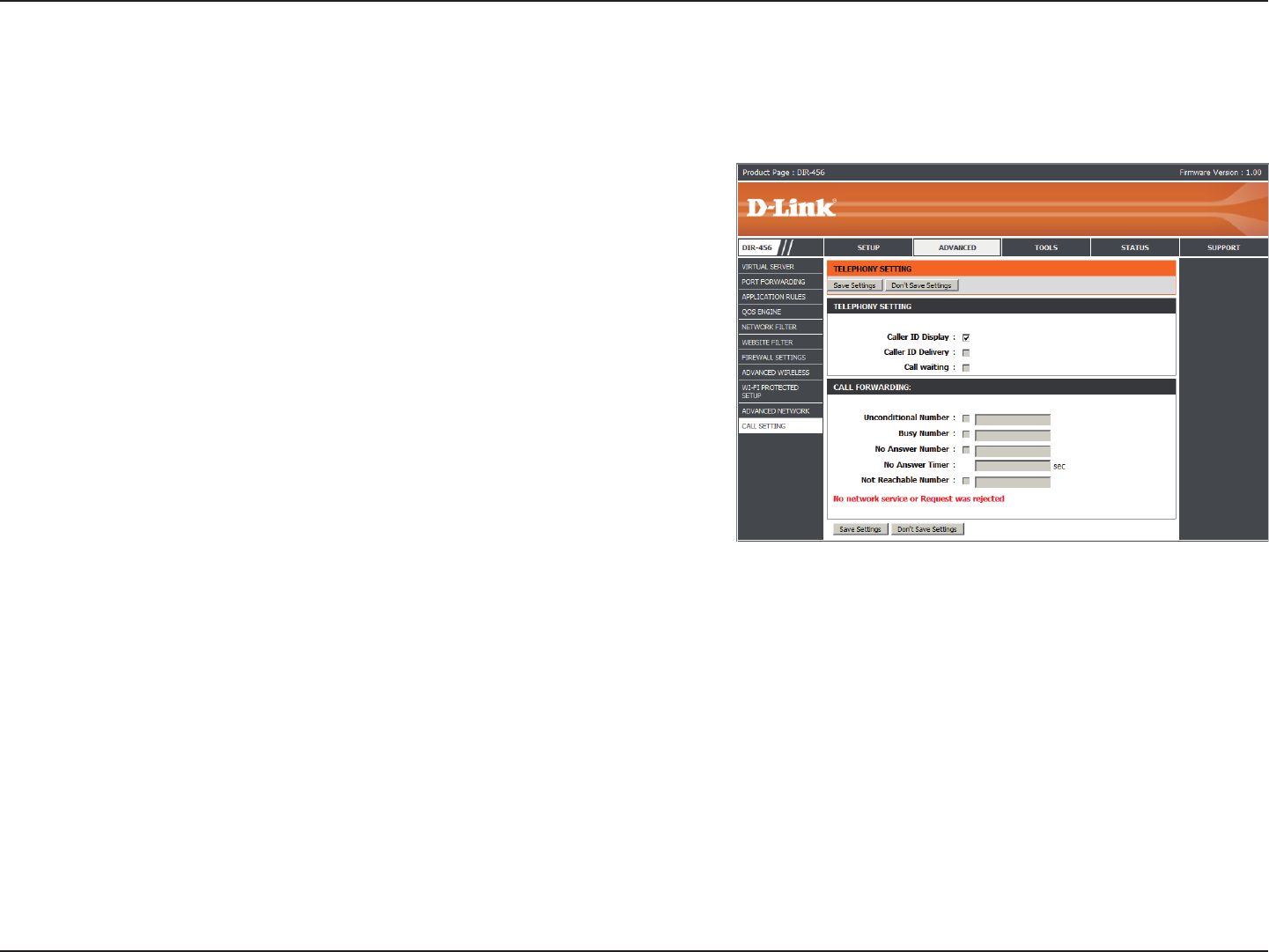
46D-Link DIR-456U User Manual
Section 3 - Configuration
TELEPHONY SETTING
Select this box to enable Caller ID display.
Select this box to enable Caller ID delivery.
Select this box to enable call waiting.
CALL FORWARDING
Select this box to enable the Unconditional
Number. Enter the number in the box provided.
Select this box to enable the Busy Number. Enter
the number in the box provided.
Select this box to enable the No Answer Number. Enter the number in the box provided.
Specify the No Answer Time in seconds.
Select this box to enable the Not Reachable Number. Enter the number in the box provided.
If your mobile service does not support these features, you will see a message at the bottom of the screen
stating No network service or Request was rejected.
Click Save Settings to save your changes, or click Don’t Save Settings to discard your changes.
Call Setting
Caller ID Display:
Caller ID Delivery:
Call Waiting:
Unconditional Number:
Busy Number:
No Answer Number:
No Answer Timer:
Not Reachable Number:
The Call Setting page allows you to congure the settings for incoming calls. The DIR-456U allows you to connect a standard landline
telephone and receive calls to the mobile number associated with your SIM card.
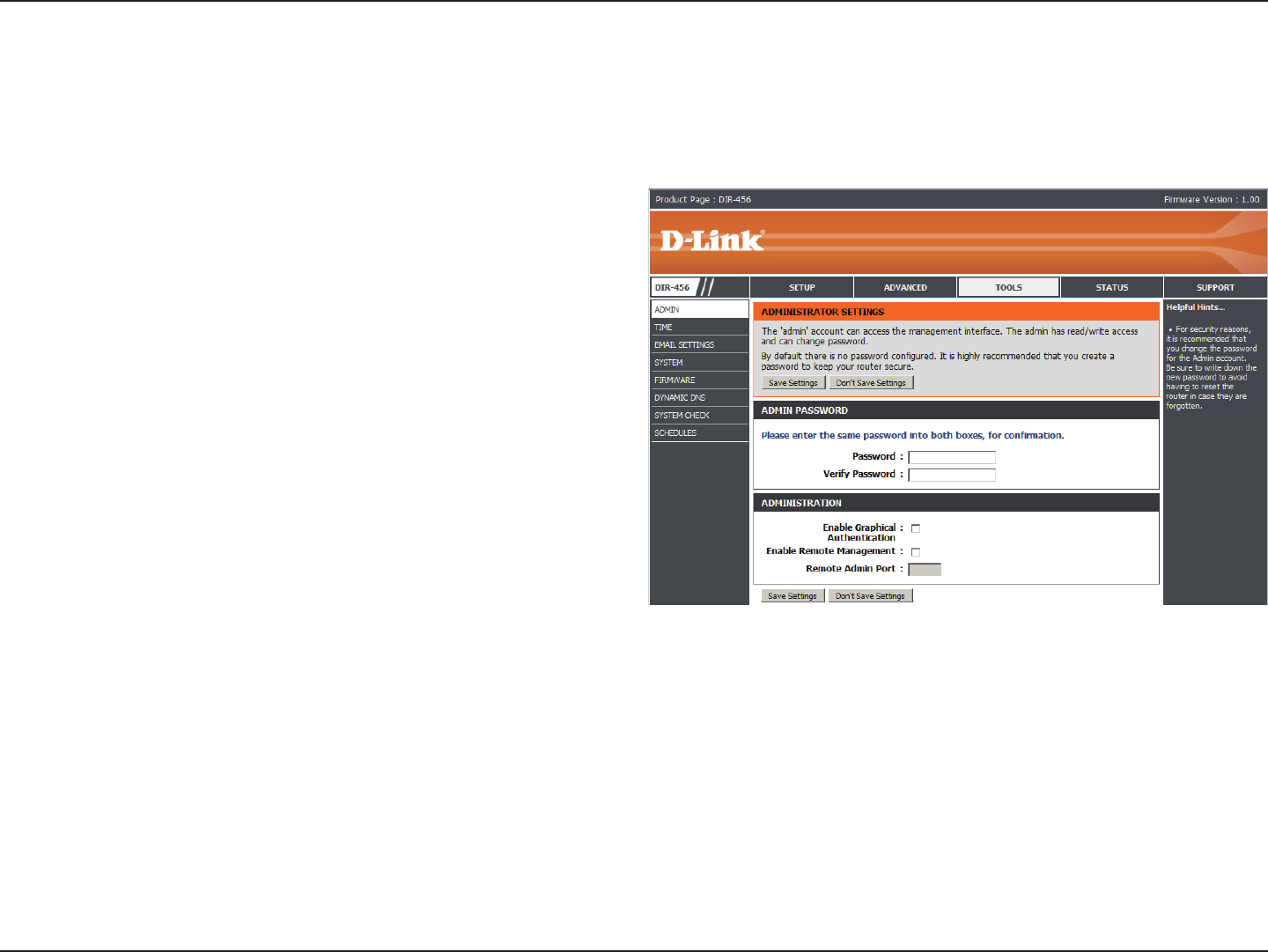
47D-Link DIR-456U User Manual
Section 3 - Configuration
ADMINISTRATOR
Enter and conrm the password that the
admin account will use to access the
router’s management interface.
REMOTE MANAGEMENT
Enabling Graphical Authentication make
you router more secure by helping to
prevent against automated attacks.
Remote management allows the DIR-
456U to be congured from the Internet
using a web browser. A username and
password is still required to access the
Web-Management interface. Usually only
a member of your network can browse the built-in web pages to perform Administrator tasks. This feature
enables you to perform Administrator tasks from the remote (Internet) host.
This is the port number used to access the router.
Example: 8080 is the port used for the Web-Management interface.
Click Save Settings to save your changes, or click Don’t Save Settings to discard your changes.
Admin
The Admin page allows you to change the Administrator password and enable Remote Management. Admin has read/write access while
the user has read-only access. Only the admin has the ability to change both admin and user account passwords.
Admin Password:
Enable Graphical
Authentication:
Remote Management:
Remote Admin Port:
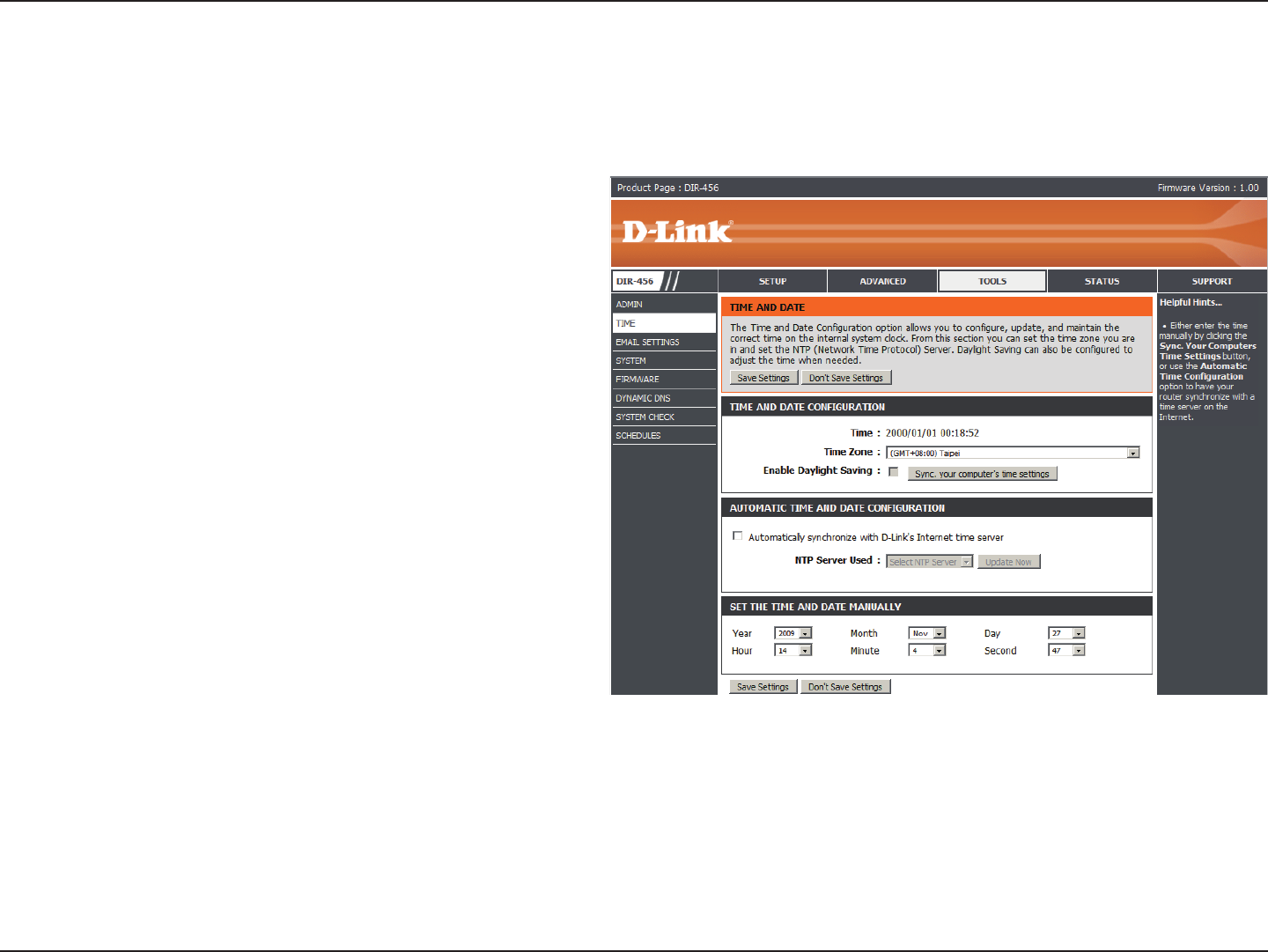
48D-Link DIR-456U User Manual
Section 3 - Configuration
Time
Select the appropriate Time Zone
from the drop-down box.
Select this checkbox to enter a start
date and an end date for daylight
saving time.
The Network Time Protocol (NTP)
synchronizes the computer’s clock
over a network.
Manually enter the values for Year,
Month, Day, Hour, Minute, and
Second.
This section will help you set the time zone that you are in and the NTP (Network Time Protocol) Server. Daylight Saving can also be
congured to adjust the time when needed.
Click Save Settings to save your changes, or click Don’t Save Settings to discard your changes.
Time Zone:
Enable Daylight Saving:
Automatic Time and Date
Configuration:
Set the Time and Date
Manually:
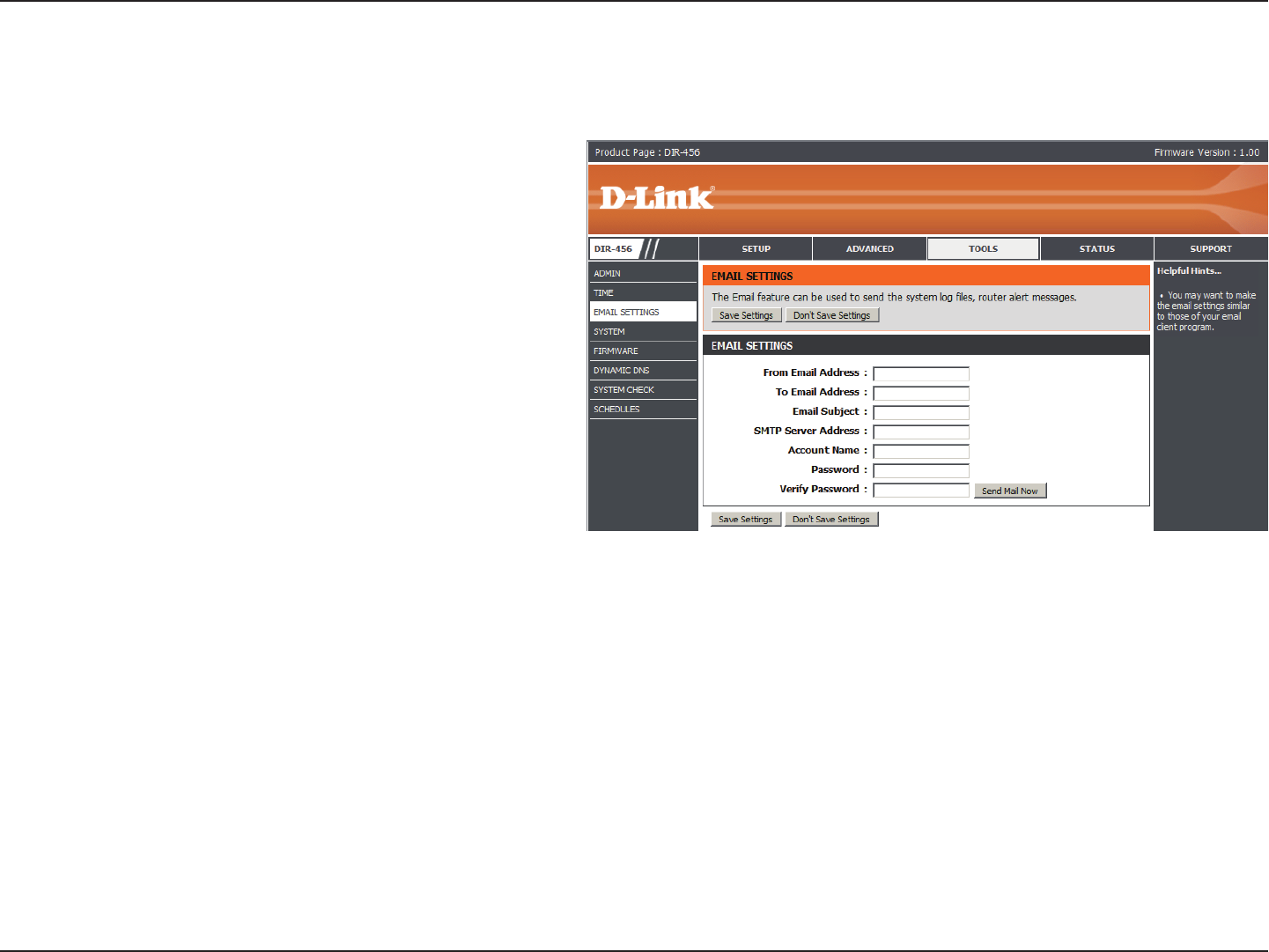
49D-Link DIR-456U User Manual
Section 3 - Configuration
Enter the e-mail address to be
displayed in the from field of
the e-mail that is send from the
router.
Enter the e-mail address of the
recipient.
Enter the subject of the e-mail to
be sent.
Enter the SMTP server address for
your e-mail account.
Enter the account name for your
e-mail account.
Enter the password associated with the account.
Re-enter the password associated with the account.
Click the Send Mail Now button to send a test message to e-mail address specied in the To Email Address
eld.
Click Save Settings to save your changes, or click Don’t Save Settings to discard your changes.
From Email Address:
To Email Address:
Email Subject:
SMTP Server Address:
Account Name:
Password:
Verify Password:
Send Mail Now:
The Email feature can be used to send the system log les and router alert messages.
Email Settings
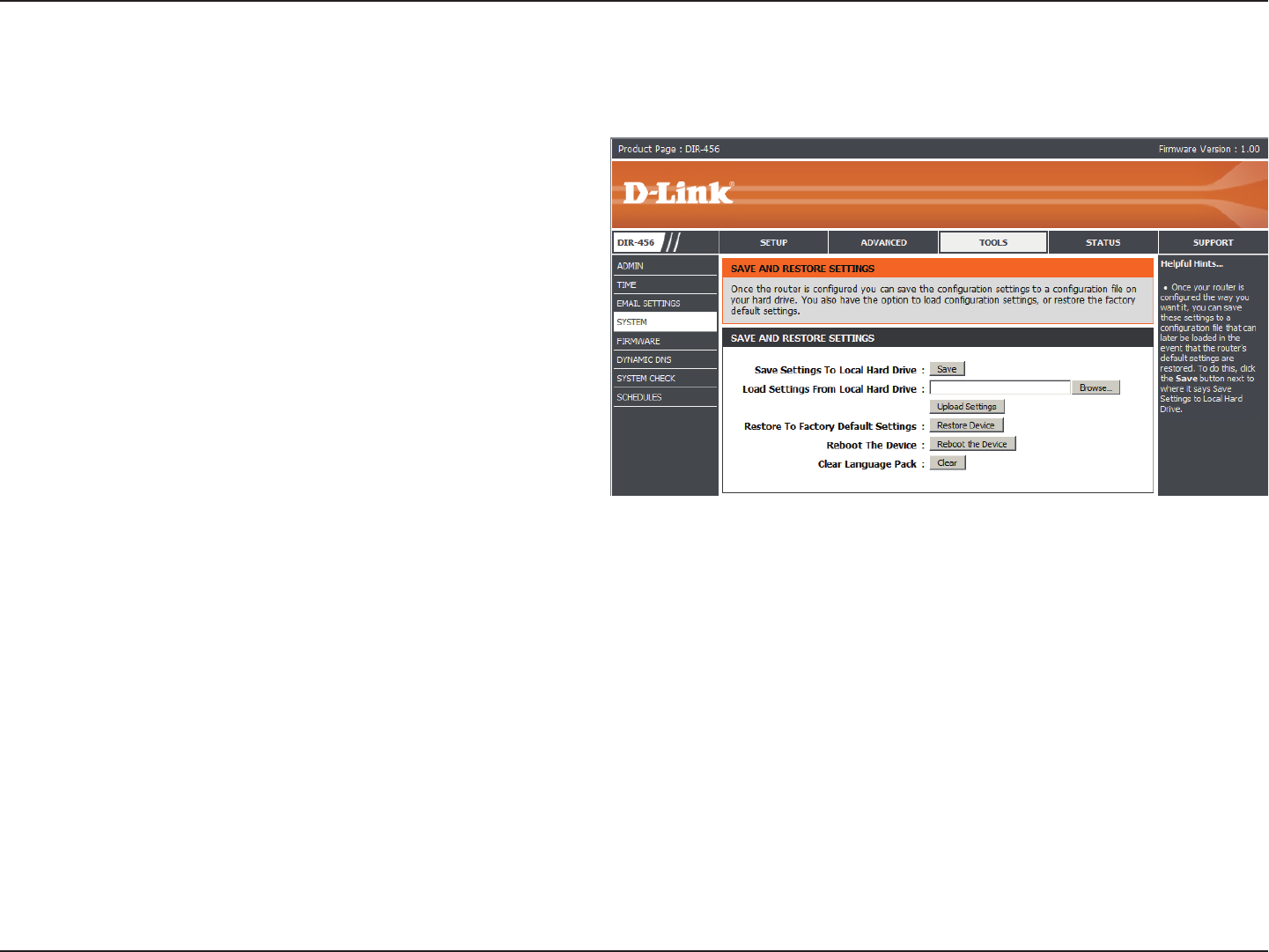
50D-Link DIR-456U User Manual
Section 3 - Configuration
System
Use this option to save your current
router configuration settings to a
le and onto your computer. Click
Save to open a le dialog, and then
select a location and le name for
the settings.
Use this option to load the previously
saved router conguration settings.
Browse to nd the saved le and then
click Upload Settings to transfer
those settings to the router.
This option will restore all settings
back to their defaults. Any settings
that have not been backed up will be lost, including any rules that you have created.
Click to reboot your router.
Click Clear to clear the language pack that has been installed to the router and restore the default language.
Save To Local Hard Drive:
Load From Local Hard
Drive:
Restore To Factory Default
Settings:
Reboot the Device:
Clear Language Pack:
Here, you can save the current system settings onto the local hard drive.
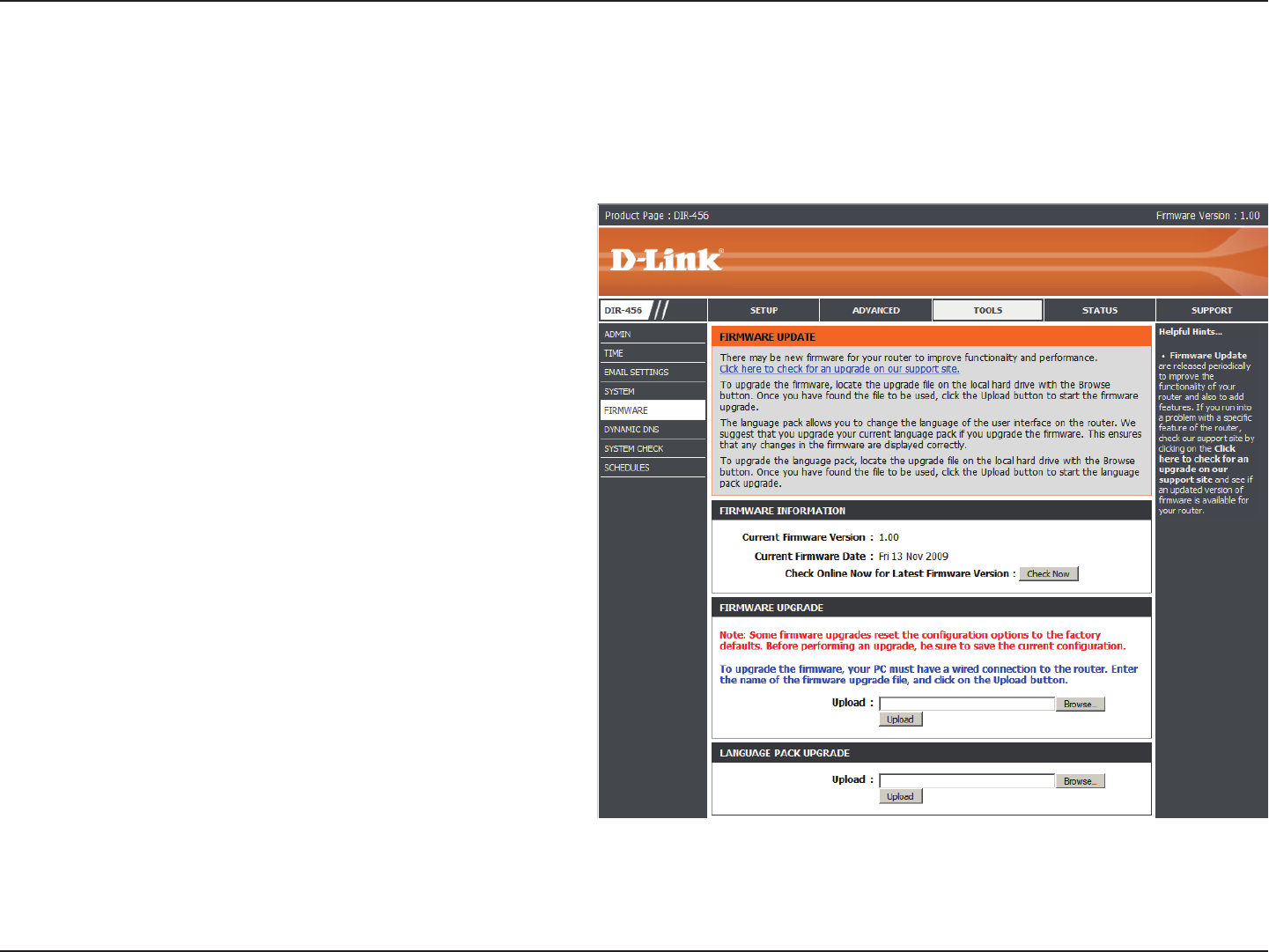
51D-Link DIR-456U User Manual
Section 3 - Configuration
Firmware
Displays your current firmware
version.
After you have downloaded the new
rmware, click Browse to locate the
rmware on your computer.
Click Upload to start the rmware
upgrade.
Here, you can upgrade the rmware of your Router. Make sure the rmware you want to use is on the local hard drive of the computer
and then click Browse to select the le to be uploaded. Please check the D-Link support site for rmware updates at http://support.dlink.
com. You can download rmware upgrades to your hard drive from the D-Link support site.
Current Firmware Version:
Browse:
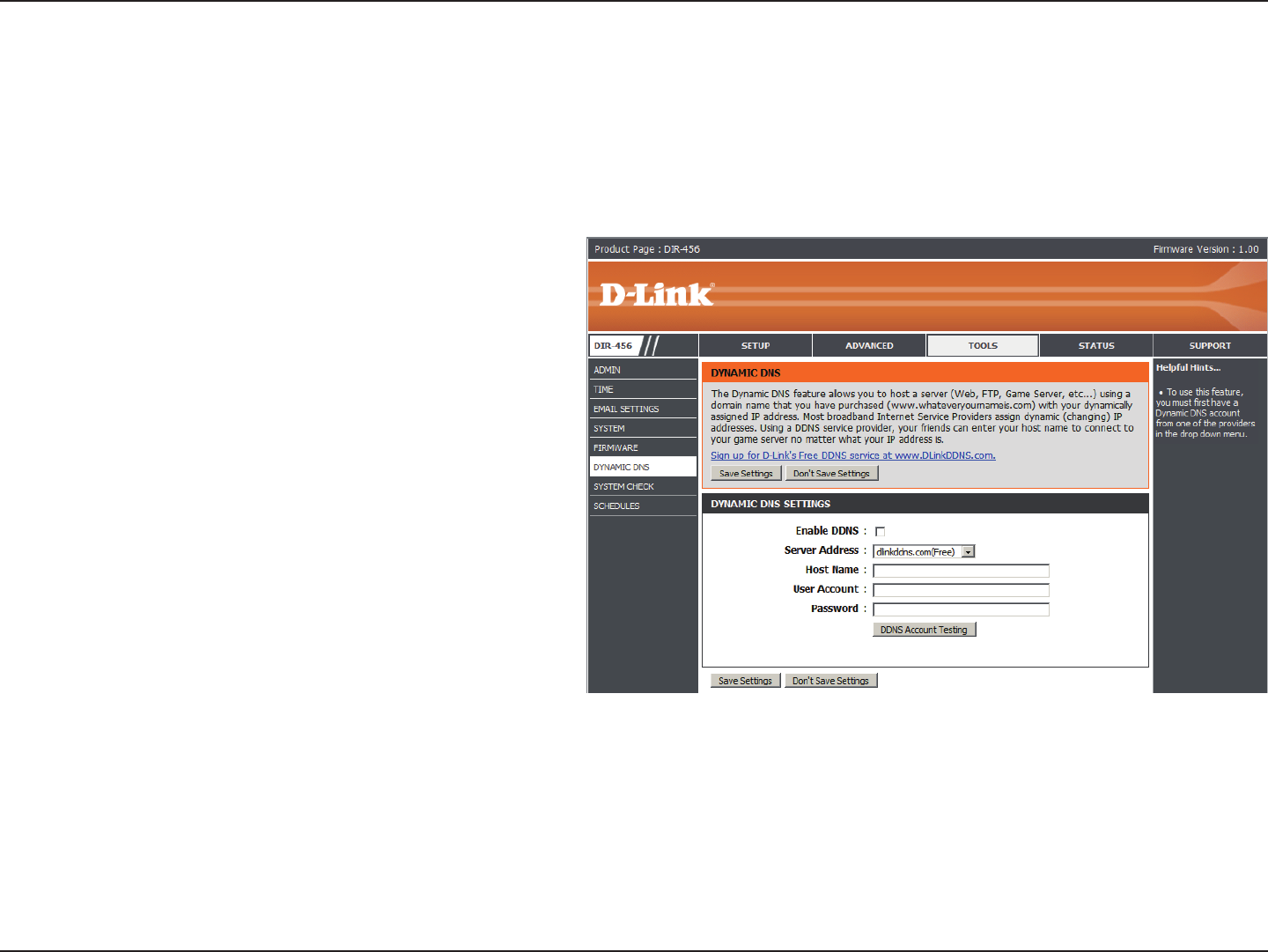
52D-Link DIR-456U User Manual
Section 3 - Configuration
Dynamic DNS
Dynamic Domain Name System
is a method of keeping a domain
name linked to a changing IP
Address. Select this box to enable
DDNS.
Select your DDNS provider from
the drop-down box.
Enter the Host Name that you
registered with your DDNS
service provider.
Enter the Username for your
DDNS account.
Enter the Password for your
DDNS account.
The DDNS feature allows you to host a server (Web, FTP, or Game Server) using a domain name that you have purchased
(yourname.com) with your dynamically assigned IP address.
Sign up for D-Link’s free DDNS service at www.dlinkddns.com.
Enable Dynamic DNS:
Provider:
Host Name:
Username / E-mail:
Password / Key:
Click Save Settings to save your changes, or click Don’t Save Settings to discard your changes.
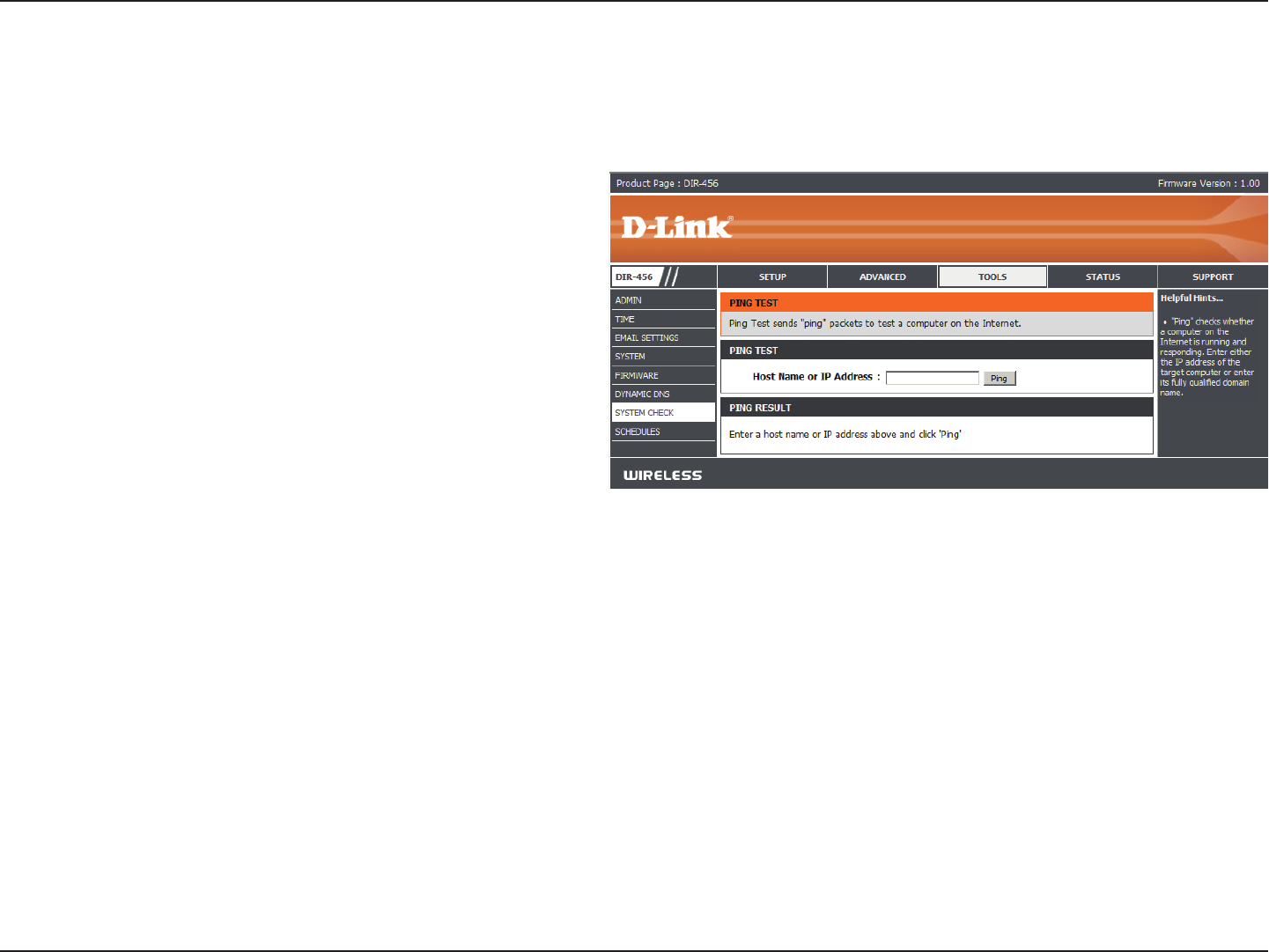
53D-Link DIR-456U User Manual
Section 3 - Configuration
System Check
Enter a host name or the IP address
that you want to ping (Packet Internet
Groper) and click Ping.
The status of your Ping attempt
will be displayed in the Ping Result
box.
This useful diagnostic utility can be used to check if a computer is connected to the network. It sends ping packets and listens for responses
from the specic host.
Host Name or IP Address:
PING Result:
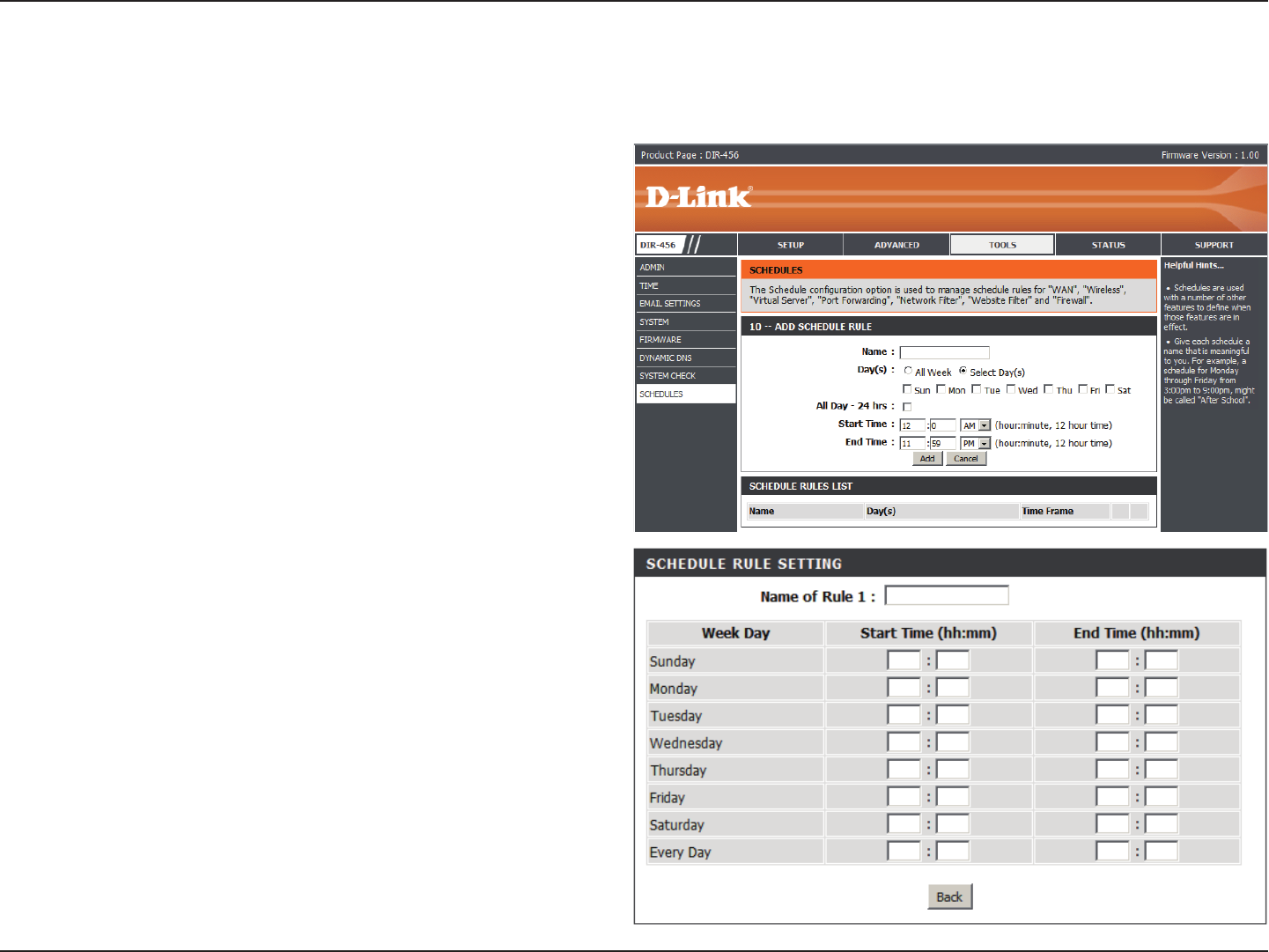
54D-Link DIR-456U User Manual
Section 3 - Configuration
Schedules
The name of the schedule being
dened.
Select a day, range of days, or select
the All Week checkbox to have this
schedule apply every day.
Check this box to have the schedule
active the entire 24 hours on the
days specied.
Select the time at which you would
like the schedule being dened to
become active.
Select the time at which you would
like the schedule being dened to
become inactive.
This displays all the schedules that
have been dened.
This section allows you to manage schedule rules for various rewall and parental control features.
Name:
Day(s):
All Day - 24 hrs:
Start Time:
End Time:
Schedule Rules List:
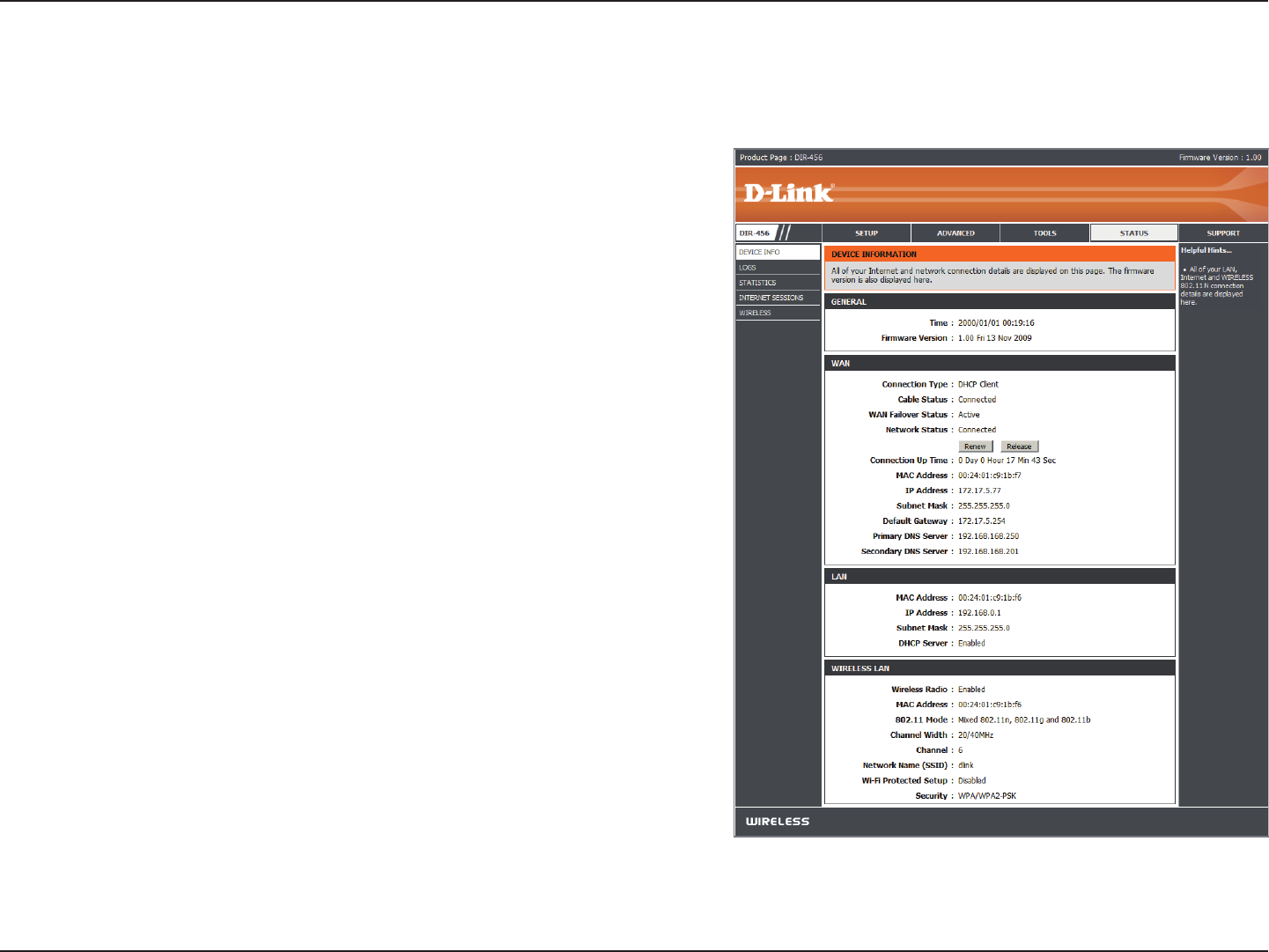
55D-Link DIR-456U User Manual
Section 3 - Configuration
Device Information
All of your Internet and network connection details are displayed on this page. The rmware version is also displayed here.
Displays the current time and rmware version.
Displays the MAC address and the private (local)
IP settings for the router.
Displays the MAC address and the public IP
settings for the router.
Displays the wireless MAC address and your
wireless settings such as SSID, Channel, and
Encryption type.
General:
WAN:
LAN:
Wireless LAN:
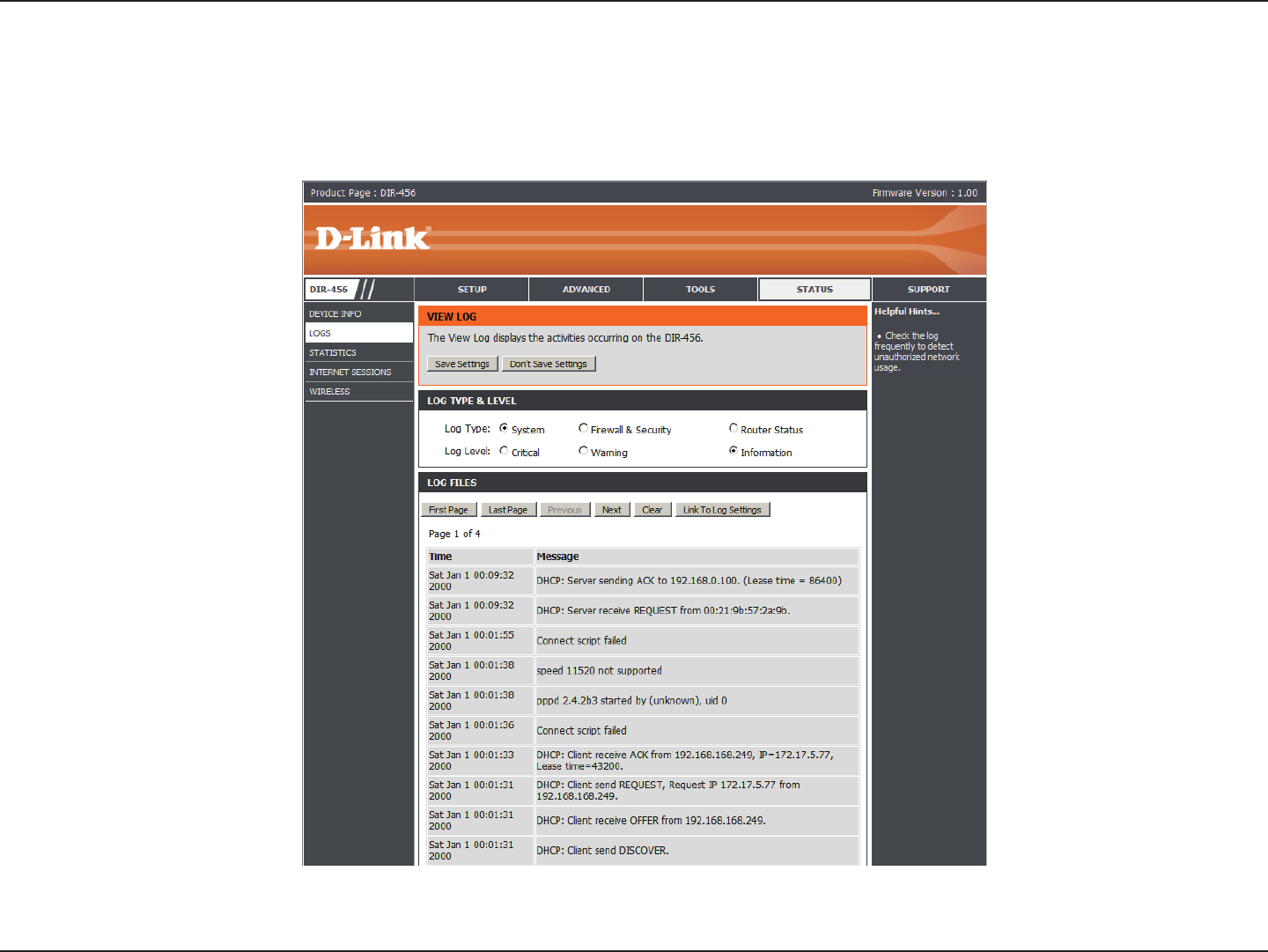
56D-Link DIR-456U User Manual
Section 3 - Configuration
Logs
Here, you can view logs and dene events that you would like to view.
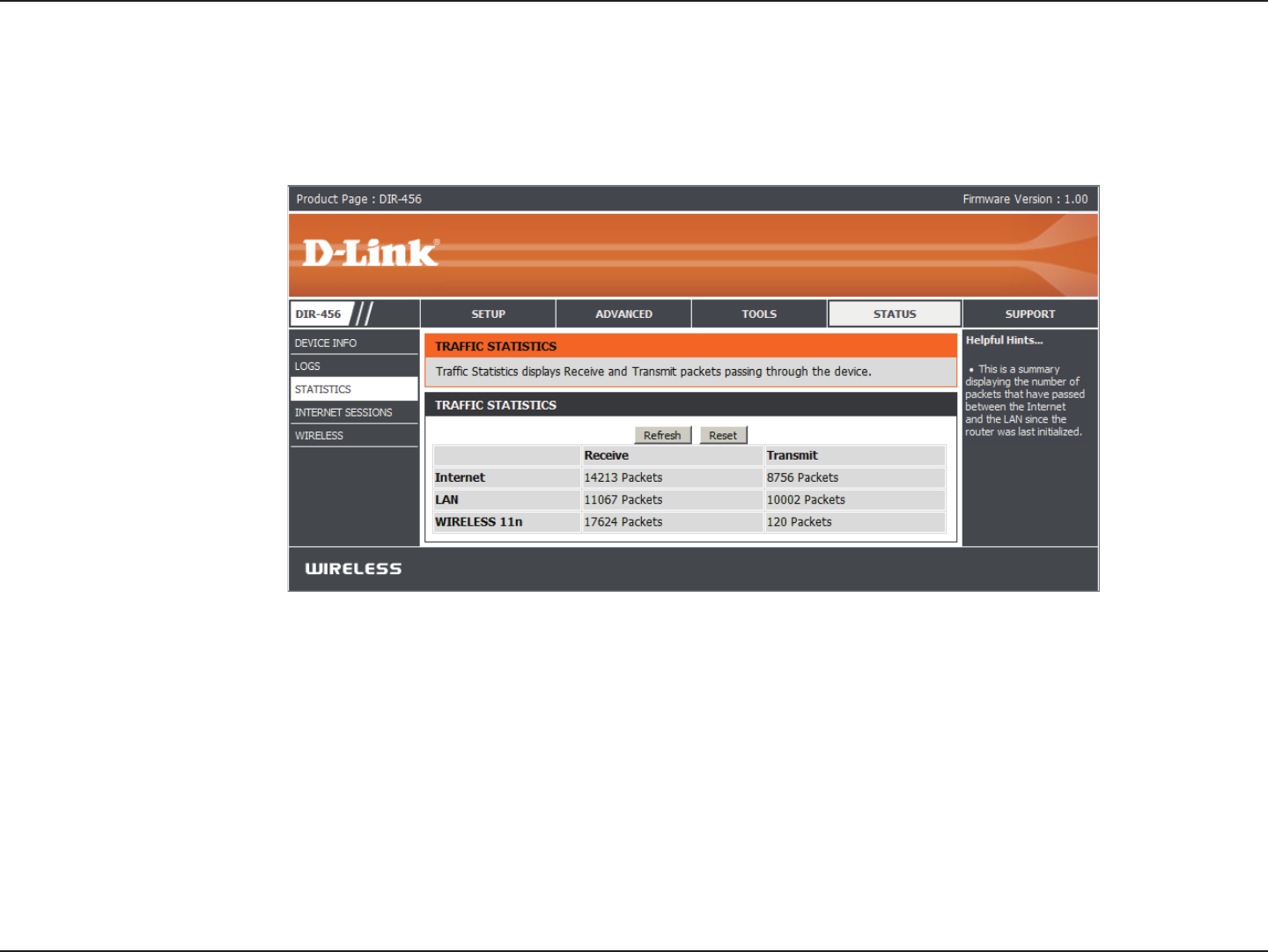
57D-Link DIR-456U User Manual
Section 3 - Configuration
Statistics
Here you can view the packets transmitted and received passing through your router on both WAN and LAN ports. The trafc counter will
reset if the device is rebooted.
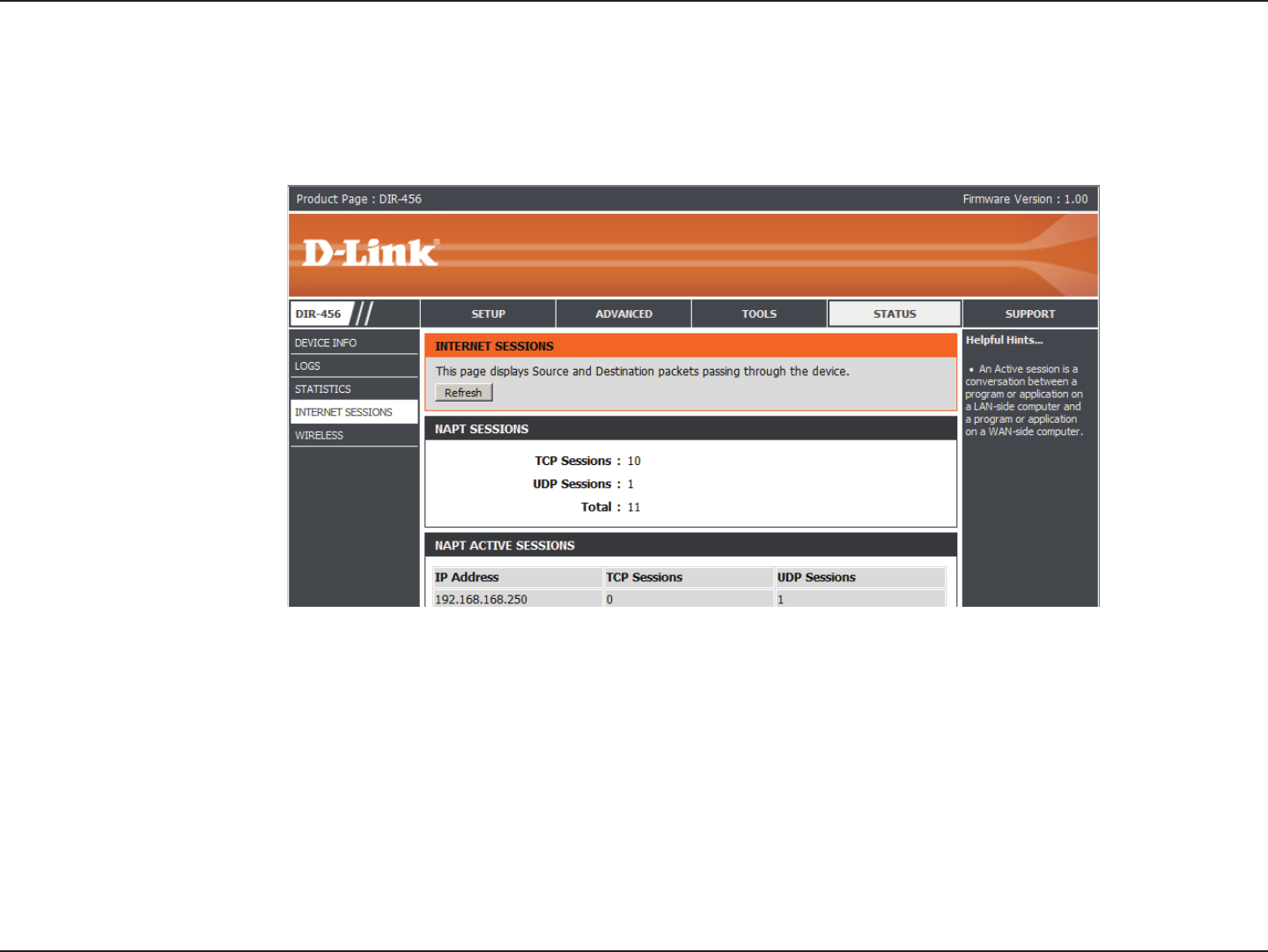
58D-Link DIR-456U User Manual
Section 3 - Configuration
Internet Sessions
This page displays Source and Destination packets passing through the device.
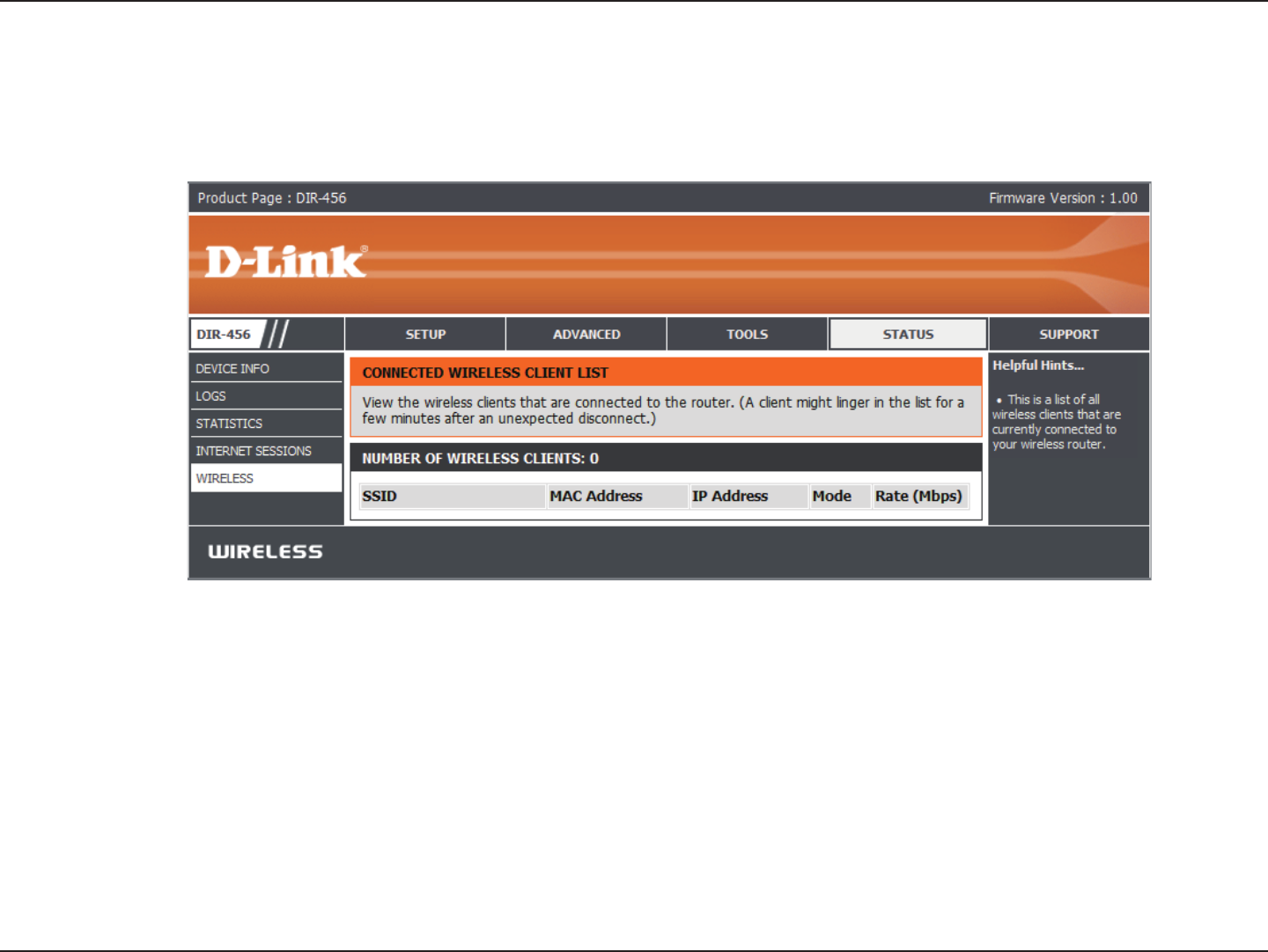
59D-Link DIR-456U User Manual
Section 3 - Configuration
Wireless
This table displays a list of wireless clients that are connected to your wireless router. It also displays the connection time and MAC
address of the connected wireless clients.
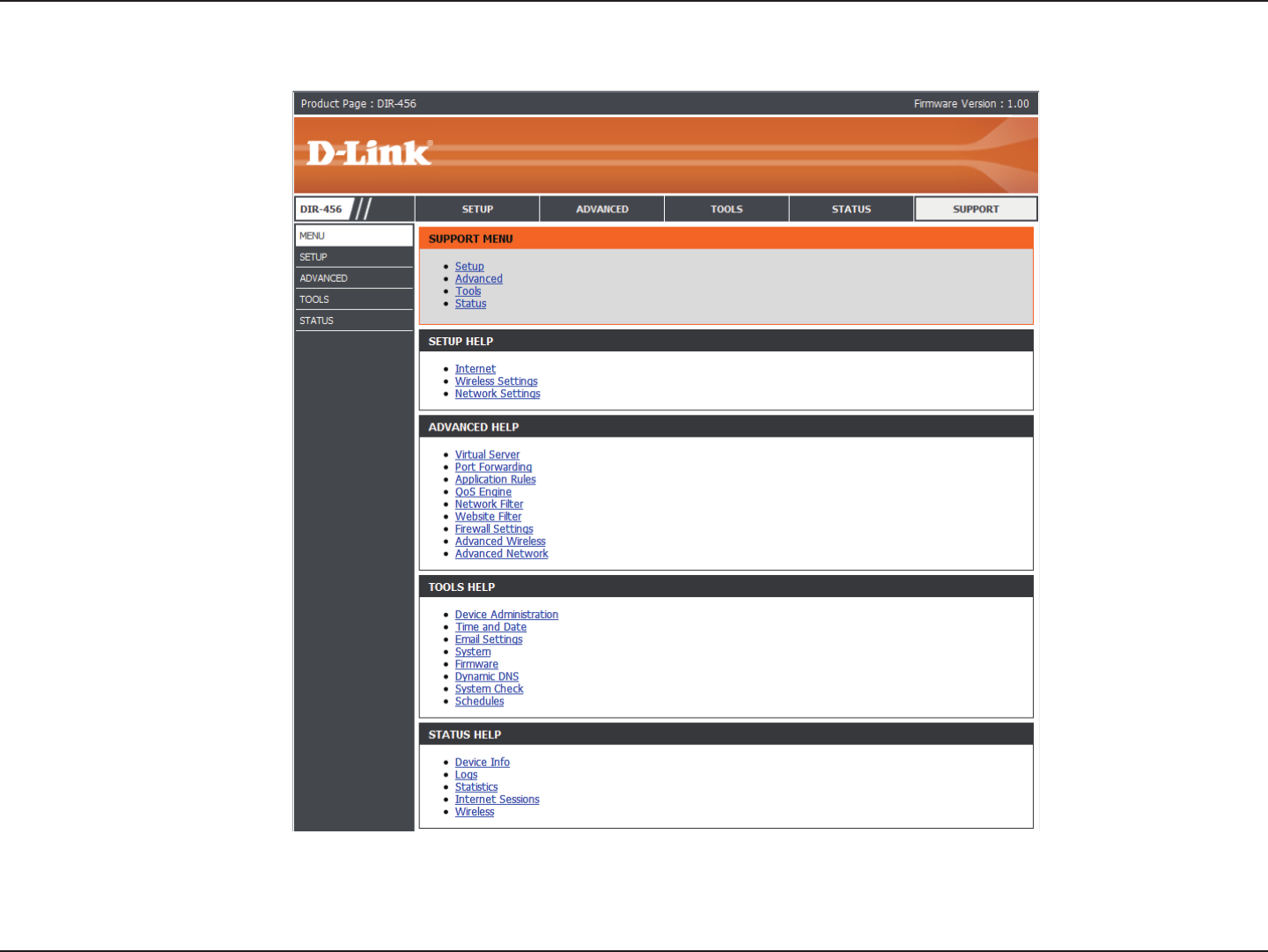
60D-Link DIR-456U User Manual
Section 3 - Configuration
Support

61D-Link DIR-456U User Manual
Section 4 - Security
Wireless Security
This section will show you the different levels of security you can use to protect your data from intruders. The
DIR-456U offers the following types of security:
• WPA2 (Wi-Fi Protected Access 2) • WPA2-PSK (Pre-Shared Key)
• WPA (Wi-Fi Protected Access) • WPA-PSK (Pre-Shared Key)
• WEP (Wired Equivalent Privacy)
What is WEP?
WEP stands for Wired Equivalent Privacy. It is based on the IEEE 802.11 standard and uses the RC4 encryption algorithm. WEP provides
security by encrypting data over your wireless network so that it is protected as it is transmitted from one wireless device to another.
To gain access to a WEP network, you must know the key. The key is a string of characters that you create. When using WEP, you must
determine the level of encryption. The type of encryption determines the key length. 128-bit encryption requires a longer key than 64-bit
encryption. Keys are dened by entering in a string in HEX (hexadecimal - using characters 0-9, A-F) or ASCII (American Standard Code for
Information Interchange – alphanumeric characters) format. ASCII format is provided so you can enter a string that is easier to remember.
The ASCII string is converted to HEX for use over the network. Four keys can be dened so that you can change keys easily.
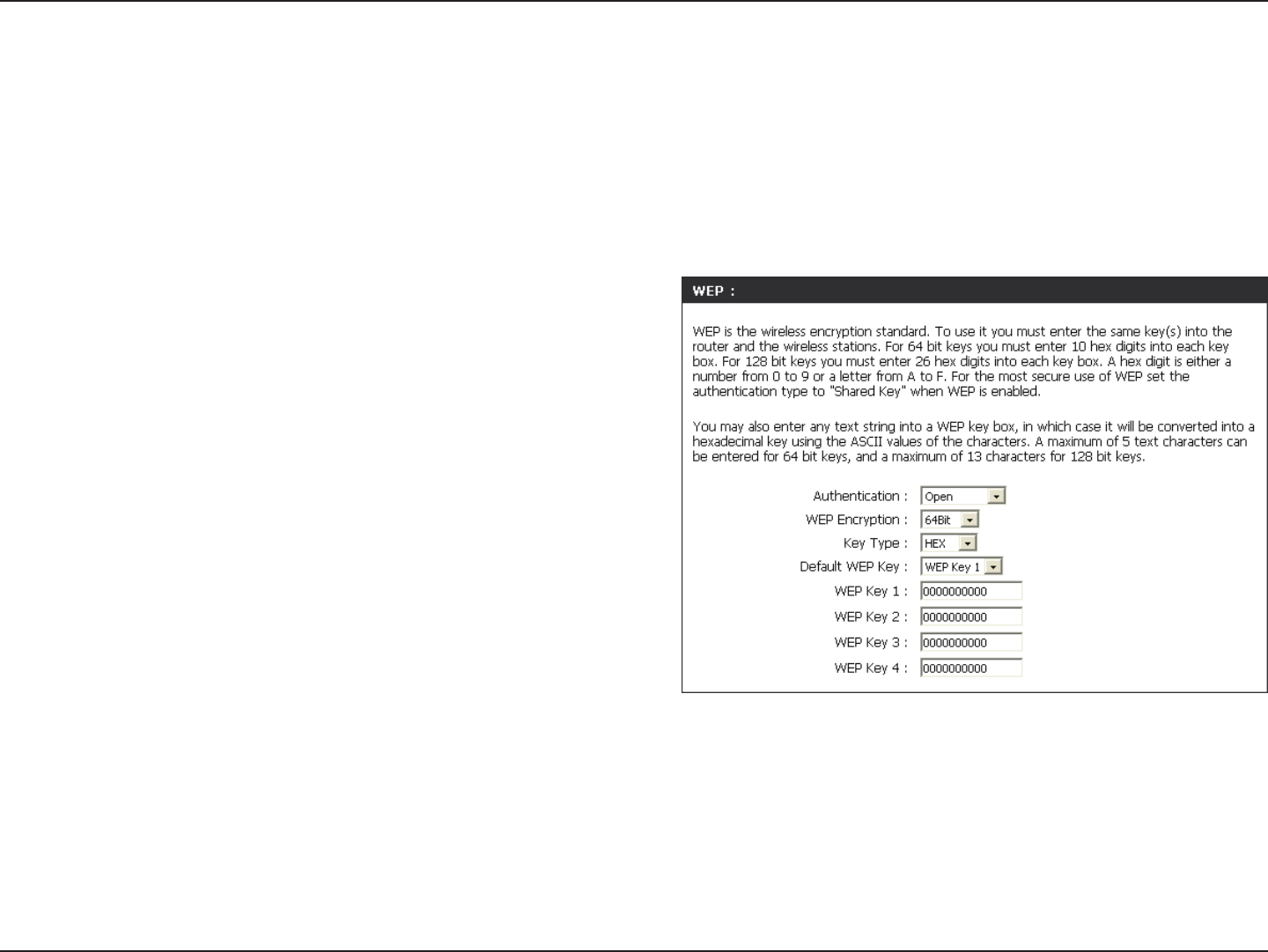
62D-Link DIR-456U User Manual
Section 4 - Security
Configure WEP
It is recommended to enable encryption on your wireless router before your wireless network adapters. Please establish wireless connectivity
before enabling encryption. Your wireless signal may degrade when enabling encryption due to the added overhead.
1. Log into the web-based conguration by opening a web browser and entering the IP address of the router (192.168.0.1). Click on
Wireless Settings on the left side.
2. Next to Security Mode, select Enable WEP Security.
3. Next to Authentication, select Open or Shared Key.
4. Select either 64-bit or 128-bit encryption from the drop-down box next
to WEP Encryption.
5. Next to Key Type, select either Hex or ASCII.
Hex (recommended) - Letters A-F and numbers 0-9 are valid.
ASCII - All numbers and letters are valid.
6. Next to Key 1, enter a WEP key that you create. Make sure you enter
this key exactly on all your wireless devices. You may enter up to 4
different keys.
7. Click Save Settings to save your settings. If you are conguring the router with a wireless adapter, you will lose connectivity until you
enable WEP on your adapter and enter the same WEP key as you did on the router.

63D-Link DIR-456U User Manual
Section 4 - Security
What is WPA?
WPA, or Wi-Fi Protected Access, is a Wi-Fi standard that was designed to improve the security features of WEP (Wired Equivalent
Privacy).
The 2 major improvements over WEP:
• Improved data encryption through the Temporal Key Integrity Protocol (TKIP). TKIP scrambles the keys using a hashing
algorithm and, by adding an integrity-checking feature, ensures that the keys haven’t been tampered with. WPA2 is based
on 802.11i and uses Advanced Encryption Standard (AES) instead of TKIP.
• User authentication, which is generally missing in WEP, through the extensible authentication protocol (EAP). WEP
regulates access to a wireless network based on a computer’s hardware-specic MAC address, which is relatively simple
to be sniffed out and stolen. EAP is built on a more secure public-key encryption system to ensure that only authorized
network users can access the network.
WPA-PSK/WPA2-PSK uses a passphrase or key to authenticate your wireless connection. The key is an alpha-numeric password between
8 and 63 characters long. The password can include symbols (!?*&_) and spaces. This key must be the exact same key entered on your
wireless router or access point.
WPA/WPA2 incorporates user authentication through the Extensible Authentication Protocol (EAP). EAP is built on a more secure public
key encryption system to ensure that only authorized network users can access the network.
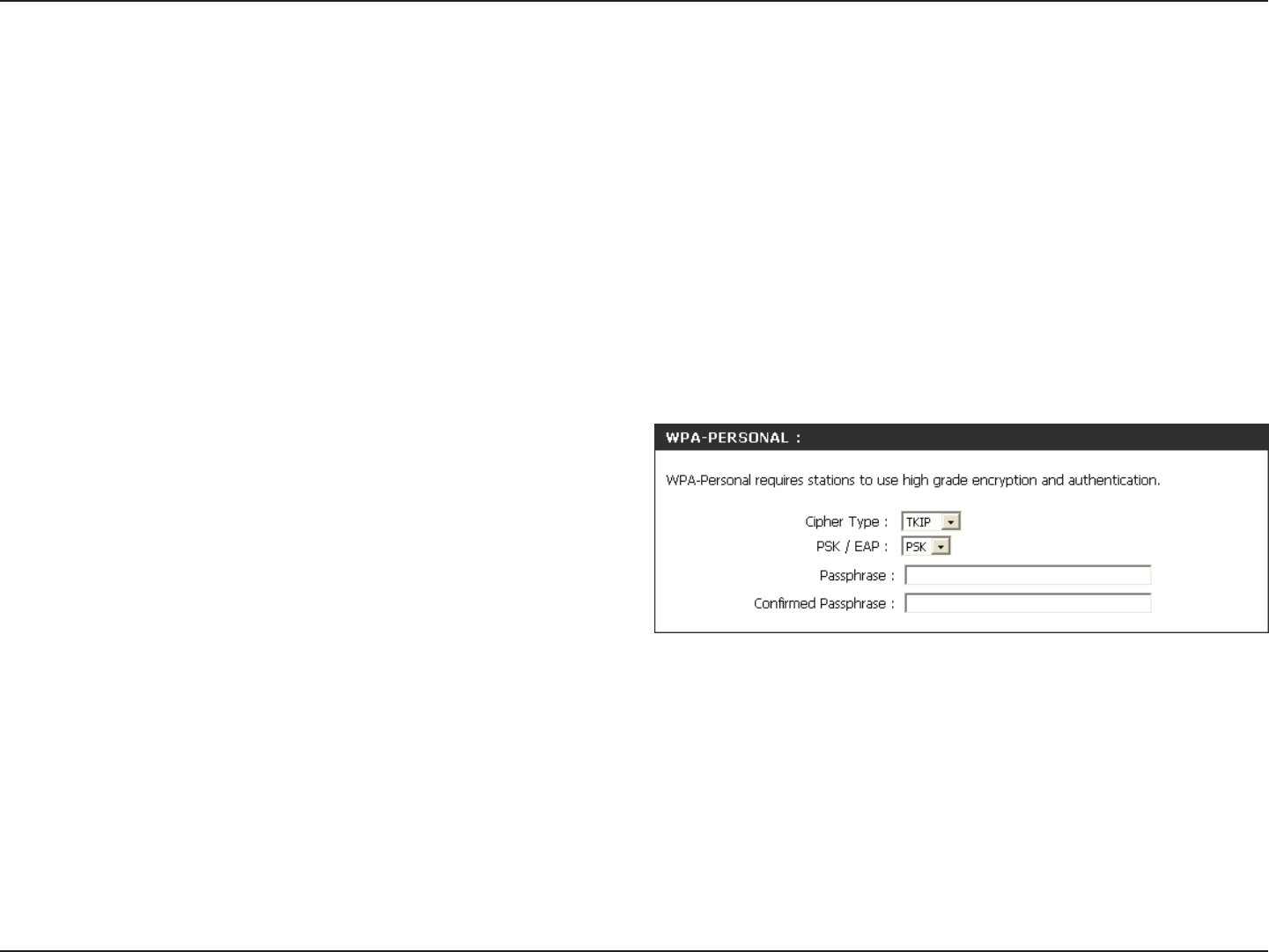
64D-Link DIR-456U User Manual
Section 4 - Security
Configure WPA-PSK
It is recommended to enable encryption on your wireless router before your wireless network adapters. Please establish wireless connectivity
before enabling encryption. Your wireless signal may degrade when enabling encryption due to the added overhead.
1. Log into the web-based conguration by opening a web browser and entering the IP address of the router (192.168.0.1). Click on
Wireless Settings on the left side.
2. Next to Security Mode, select Enable WPA-Personal Security or Enable WPA2-Personal Security.
3. Next to Cipher Mode, select TKIP, AES, or Auto.
4. Next to PSK/EAP, select PSK.
5. Next to Passphrase, enter a key (passphrase). The key is an alpha-
numeric password between 8 and 63 characters long. The password
can include symbols (!?*&_) and spaces. Make sure you enter this
key exactly the same on all other wireless clients.
6. Enter the passphrase again next to Confirmed Passphrase.
7. Click Save Settings to save your settings. If you are conguring the router with a wireless adapter, you will lose connectivity until you
enable WPA-PSK (or WPA2-PSK) on your adapter and enter the same passphrase as you did on the router.
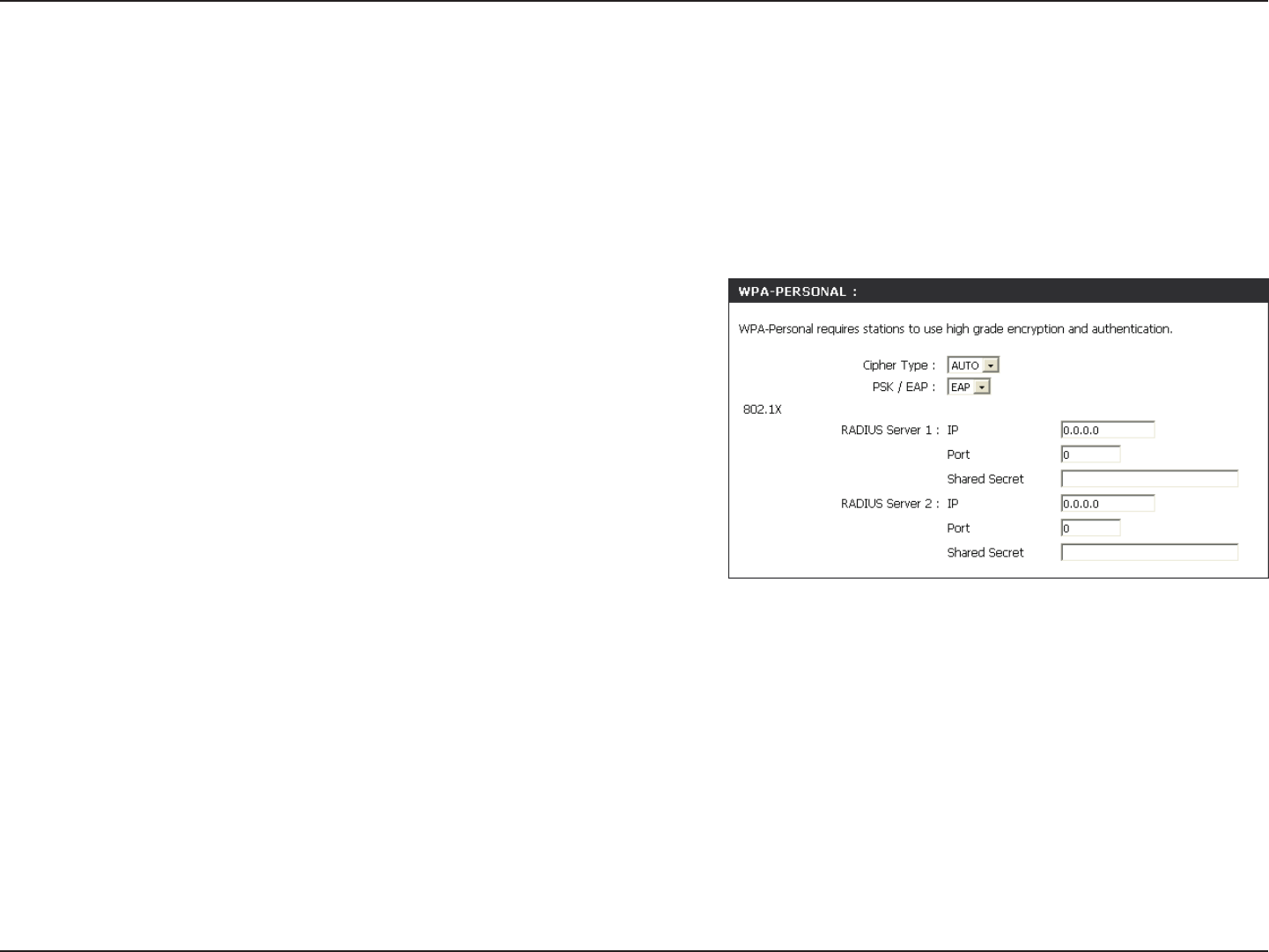
65D-Link DIR-456U User Manual
Section 4 - Security
Configure WPA (RADIUS)
It is recommended to enable encryption on your wireless router before your wireless network adapters. Please establish wireless connectivity
before enabling encryption. Your wireless signal may degrade when enabling encryption due to the added overhead.
1. Log into the web-based conguration by opening a web browser and
entering the IP address of the router (192.168.0.1). Click on Wireless
Settings on the left side.
2. Next to Security Mode, select Enable WPA-Personal Security or Enable
WPA2-Personal Security.
3. Next to Cipher Mode, select TKIP, AES, or Auto.
4. Next to PSK/EAP, select EAP.
5. Next to RADIUS Server 1 enter the IP Address of your RADIUS server.
6. Next to Port, enter the port you are using with your RADIUS server. 1812 is the default port.
7. Next to Shared Secret, enter the security key.
8. If you have a secondary RADIUS server, enter its IP address, port, and secret key.
9. Click Apply Settings to save your settings.

66D-Link DIR-456U User Manual
Section 5 - Connecting to a Wireless Network
Using Windows® 7 and WPS for Wireless Configuration
The following steps allow you to congure your DIR-456U wireless network settings using Windows® 7 through WPS.
1. Click the Start button and select Computer from the Start
menu.
2. Click the Network option.
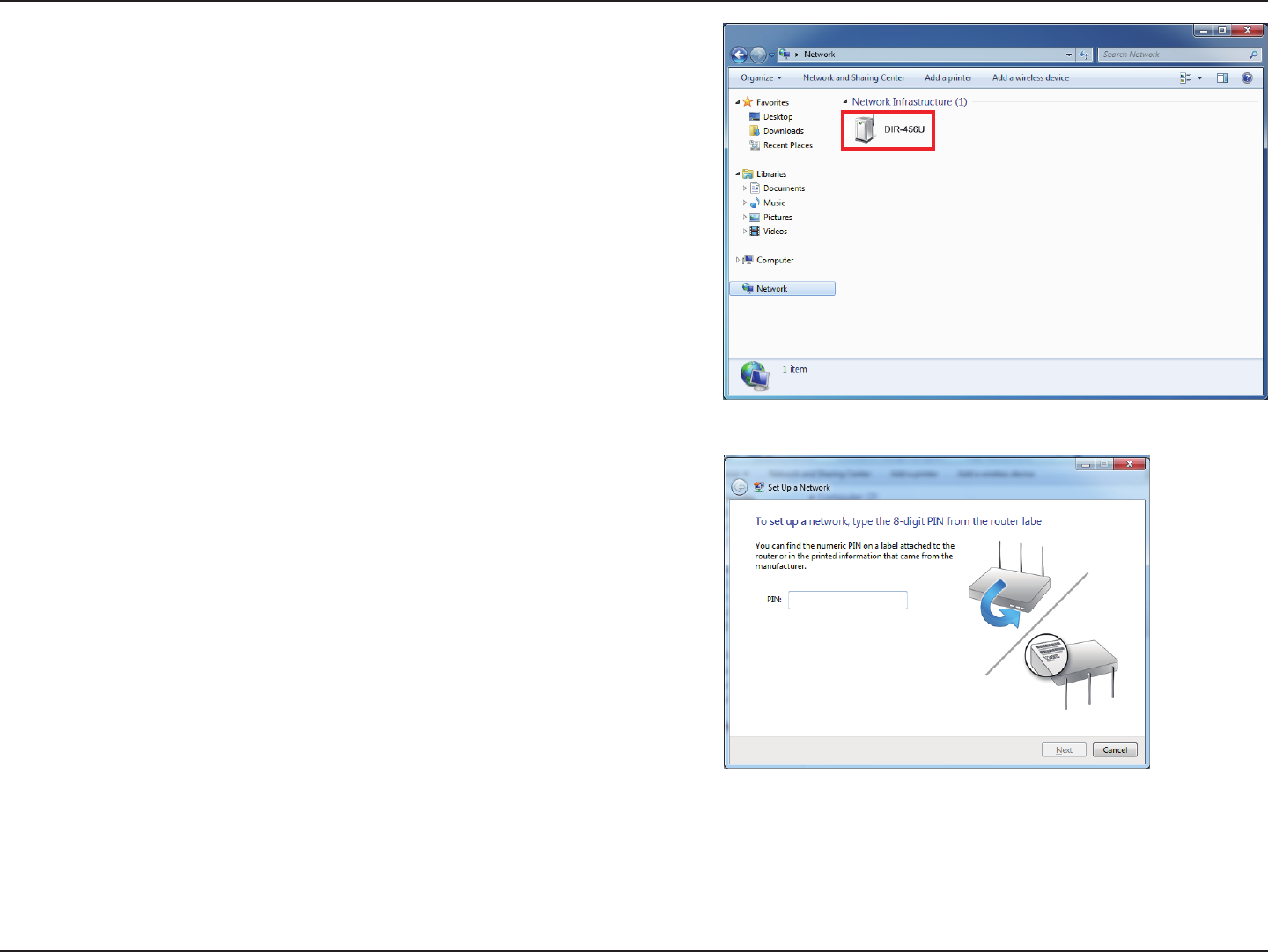
67D-Link DIR-456U User Manual
Section 5 - Connecting to a Wireless Network
3. Double-click the DIR-456U router.
4. Input the WPS PIN number (displayed in the Advanced >
Wi-Fi Protected Setup section in the Router’s Web UI) and
click Next.
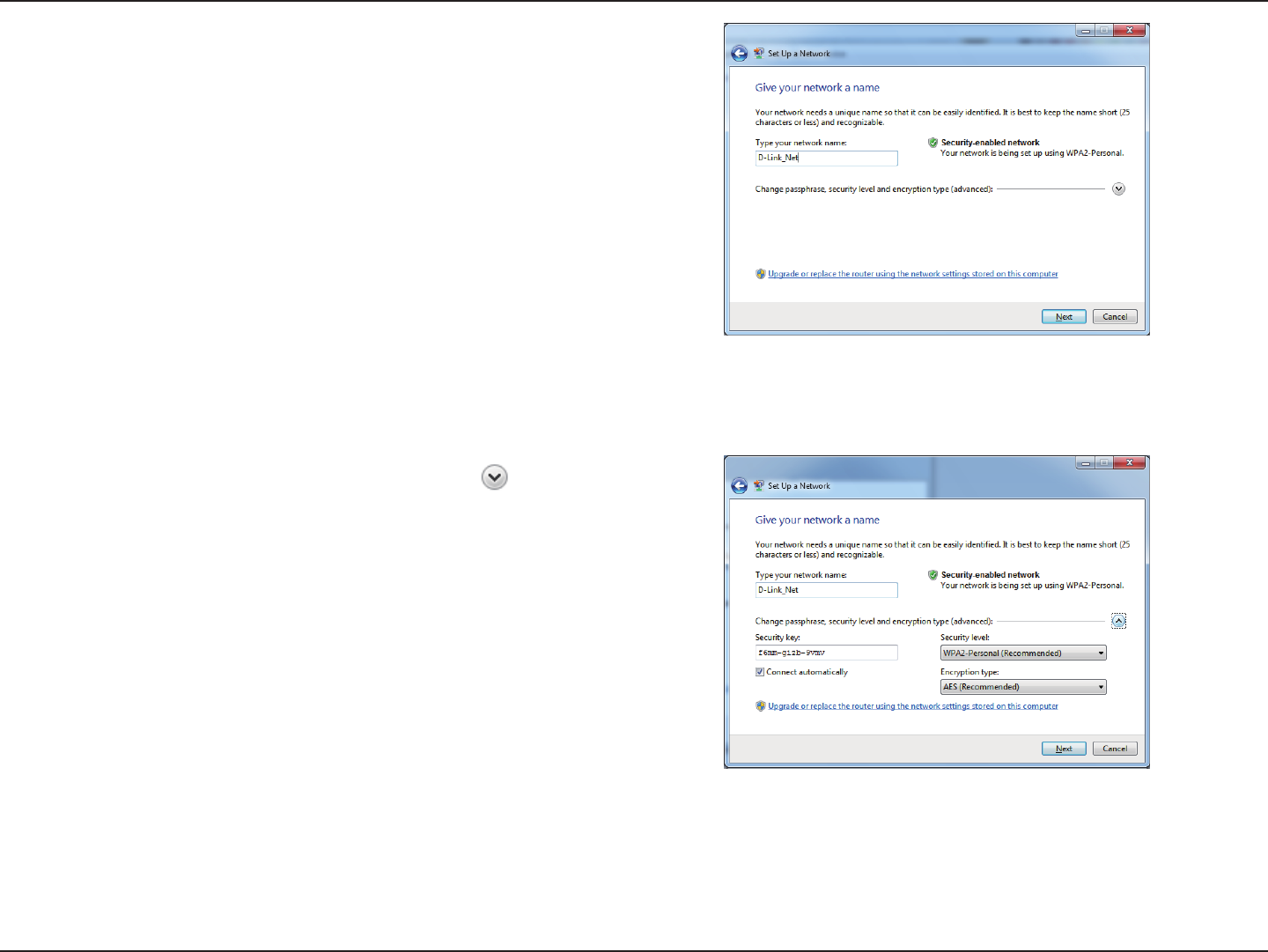
68D-Link DIR-456U User Manual
Section 5 - Connecting to a Wireless Network
5. Type a name for your wireless network.
6. To congure advanced settings, click the icon.
Click Next to continue.
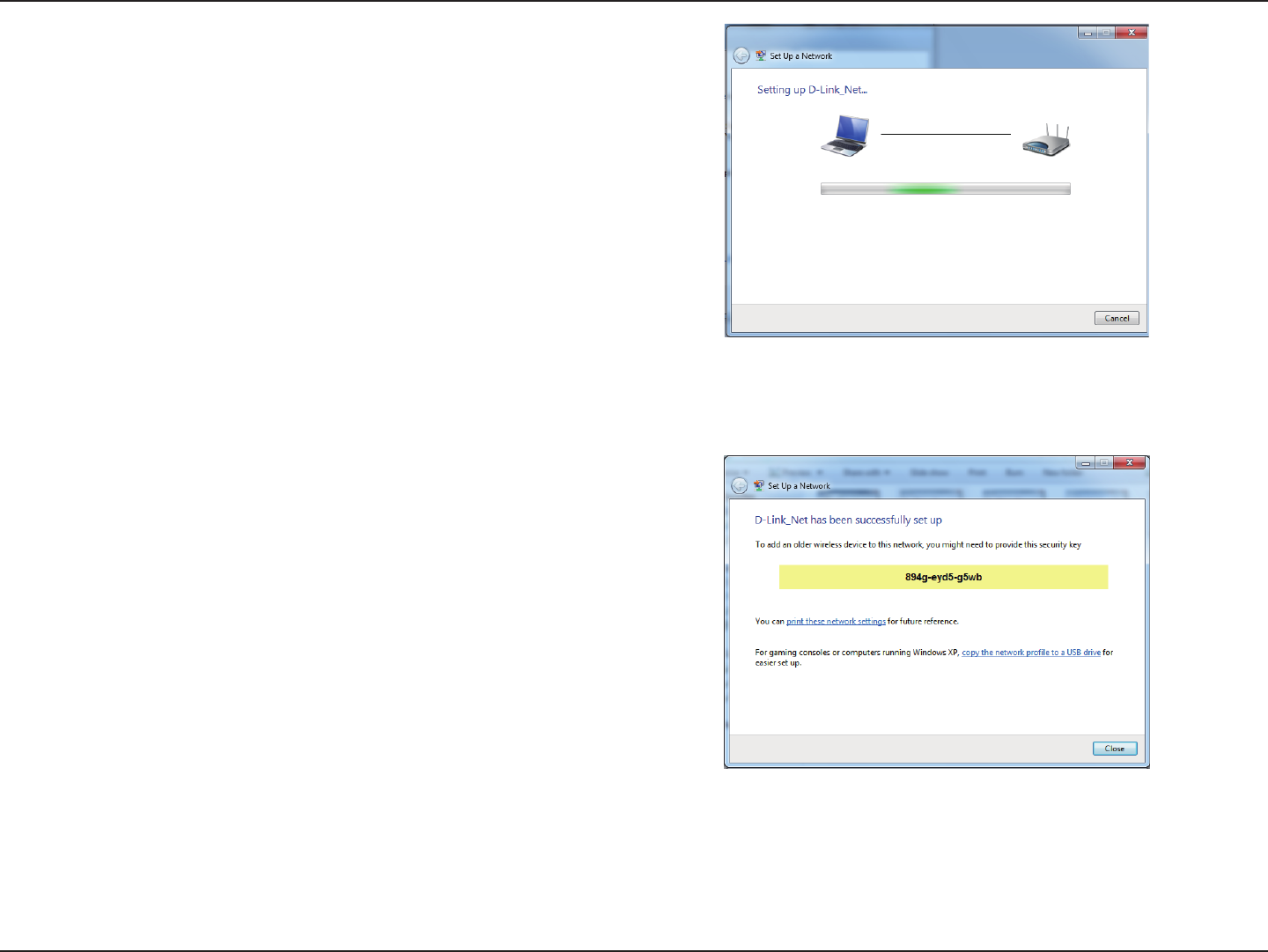
69D-Link DIR-456U User Manual
Section 5 - Connecting to a Wireless Network
7. The following window will appear while the Router is being
congured.
Wait for the conguration to complete.
8. After conguration is complete, a window will appear that your
wireless network has been set up successfully.
Make a note of the security key as you may need to provide
this security key when adding an older wireless device to the
network in the future.
Click Close to complete WPS setup.
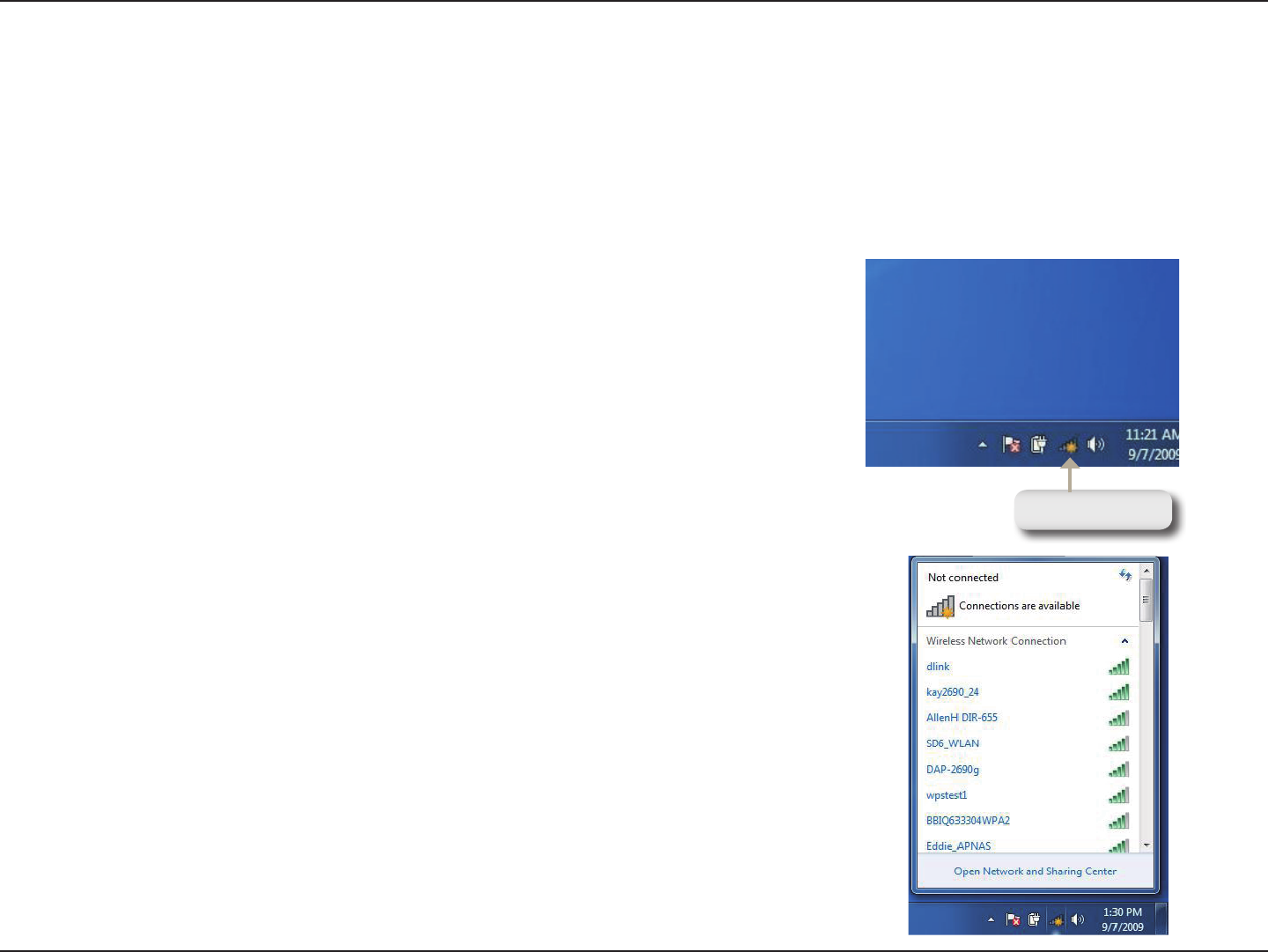
70D-Link DIR-456U User Manual
Section 5 - Connecting to a Wireless Network
Connecting to a Wireless Network
Using Windows® 7
It is recommended that you enable wireless security (WPA/WPA2) on your wireless router or access point before
conguring your wireless adapter. If you are joining an existing network, you will need to know the security key or
passphrase being used.
2. The utility will display any available wireless networks in
your area.
1. Click on the wireless icon in the system tray in the lower-
right corner of your screen.
Wireless Icon
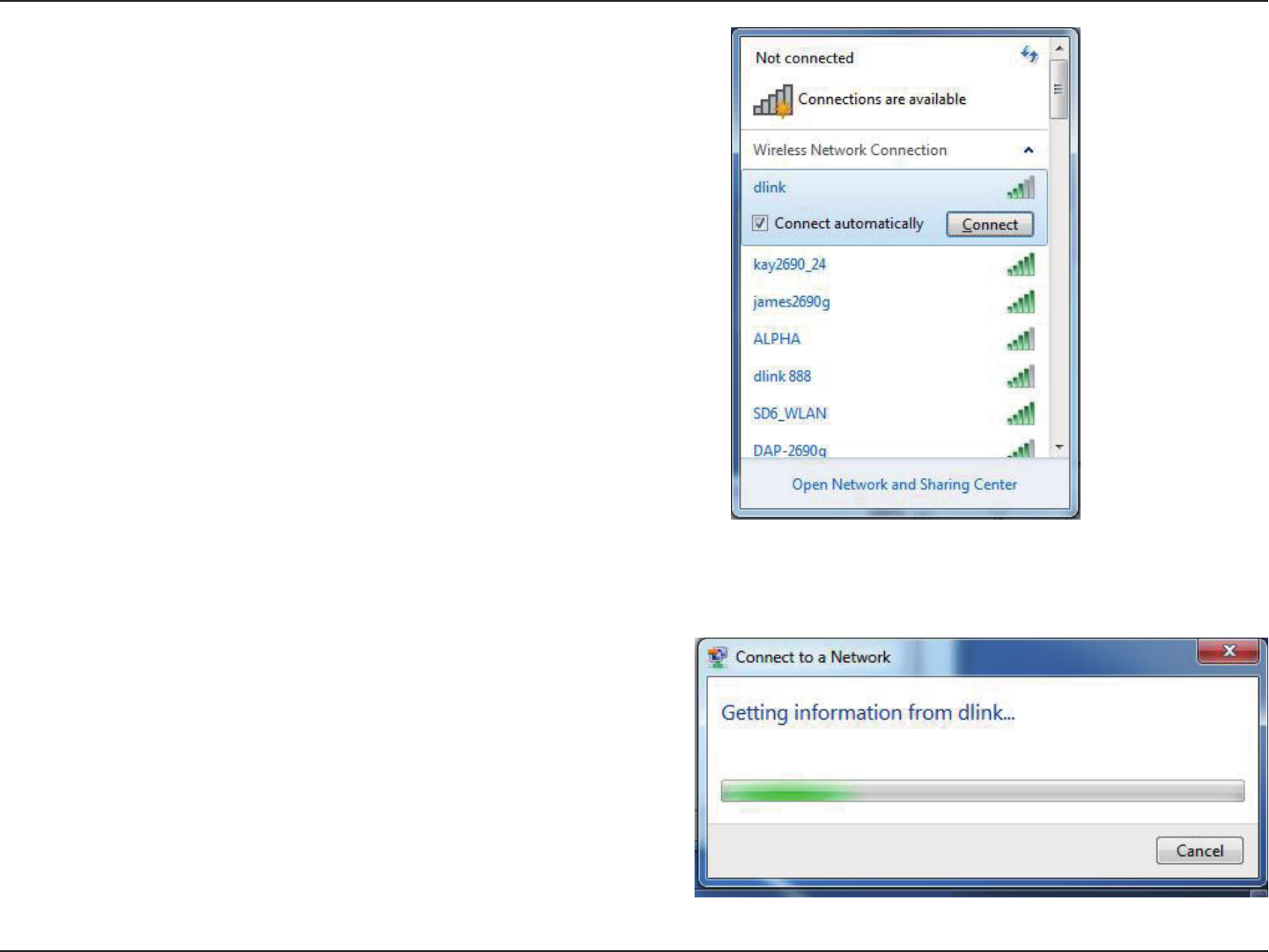
71D-Link DIR-456U User Manual
Section 5 - Connecting to a Wireless Network
3. Highlight the wireless network (SSID) you would like to
connect to and click the Connect button.
4. The following window appears while your computer tries
to connect to the router.
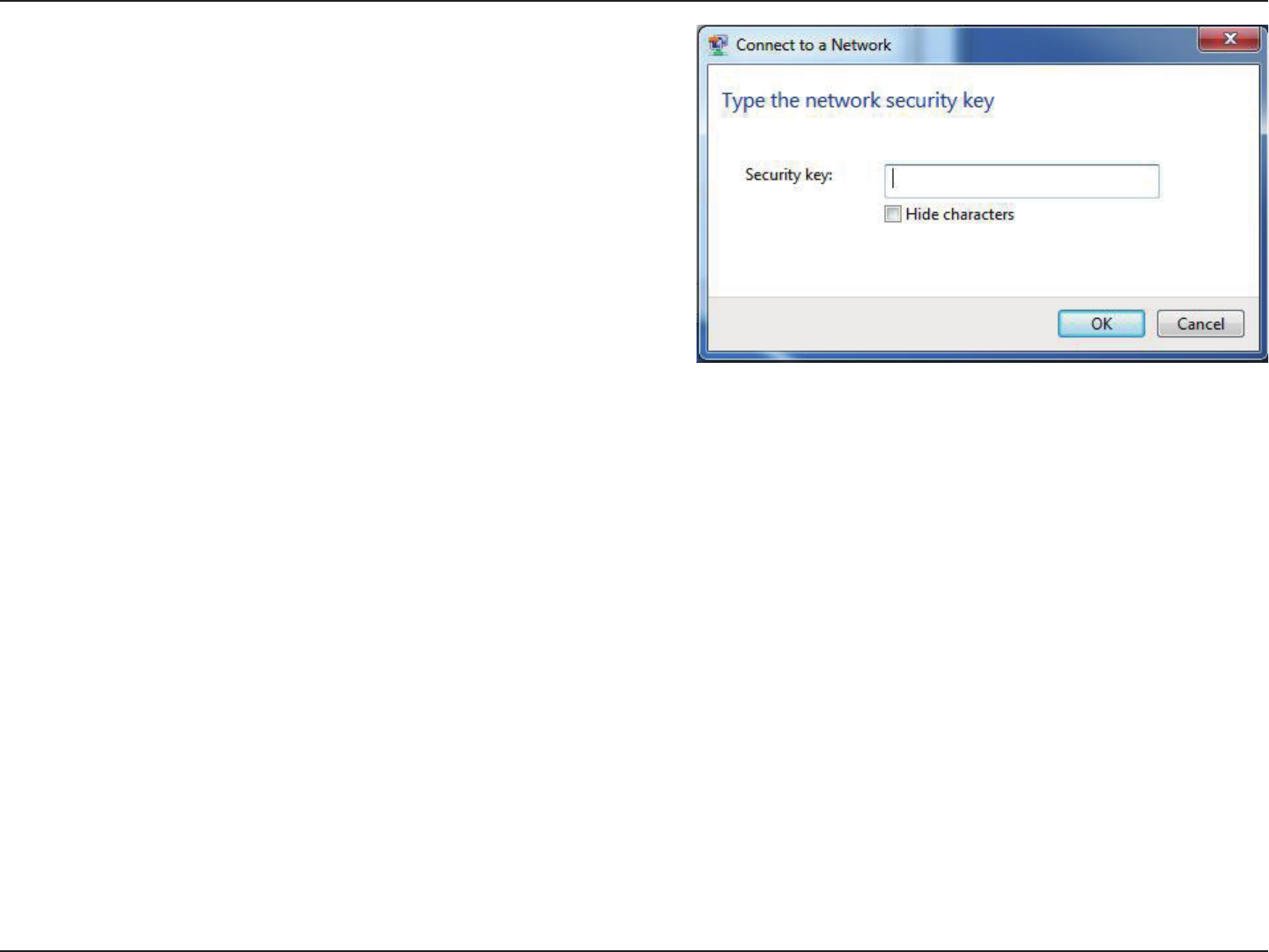
72D-Link DIR-456U User Manual
Section 5 - Connecting to a Wireless Network
5. If your wireless network uses encryption such as WEP or
WPA/WPA2, enter the encryption password/passphrase
for your wireless network and click Connect.
It may take 20-30 seconds to connect to the wireless
network. If the connection fails, please verify that the key
or passphrase is exactly the same as on the wireless
router.
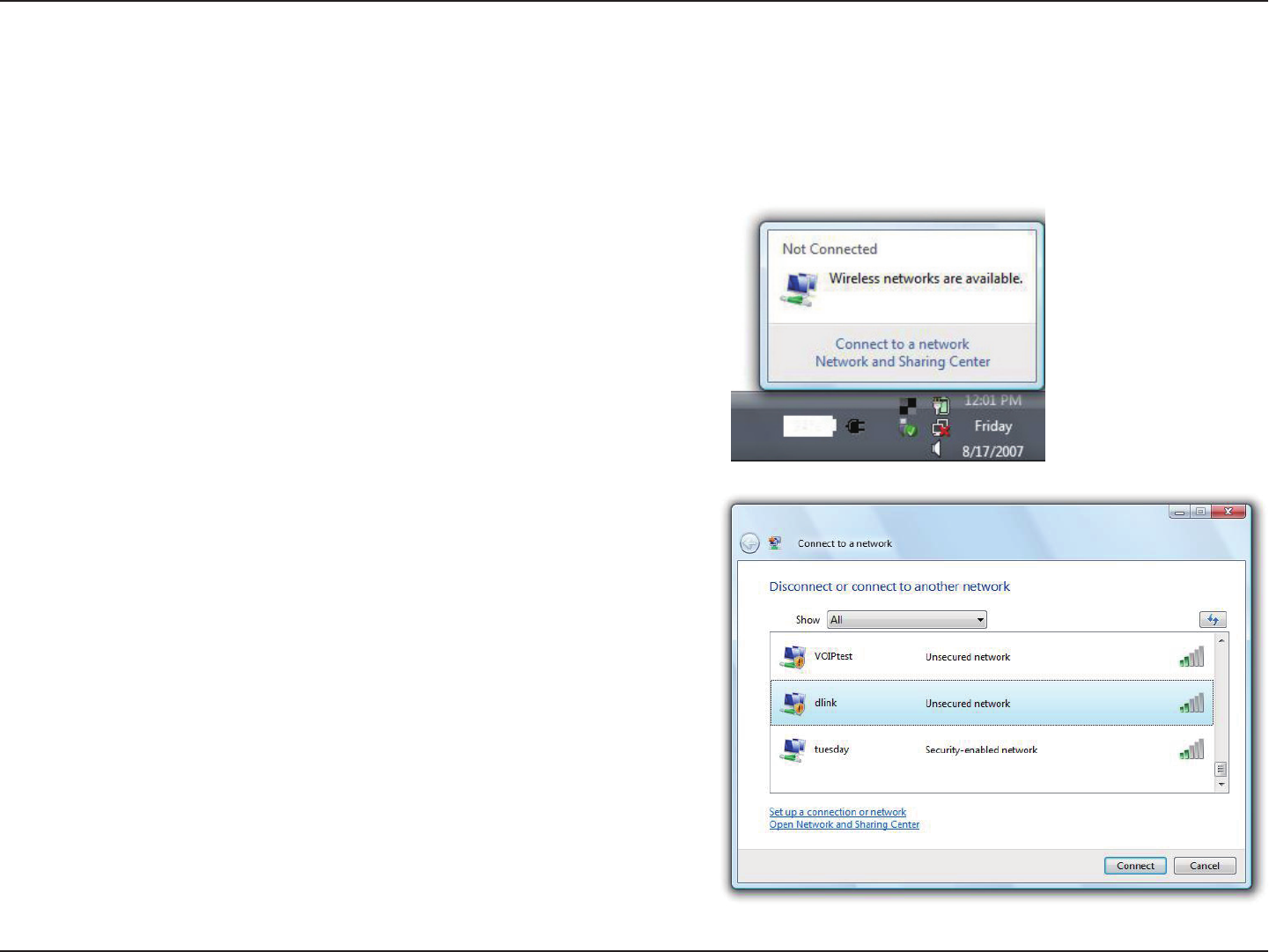
73D-Link DIR-456U User Manual
Section 5 - Connecting to a Wireless Network
Connecting to a Wireless Network Using Windows Vista®
It is recommended that you enable wireless security (WPA/WPA2) on your wireless router or access point before
conguring your wireless adapter. If you are joining an existing network, you will need to know the security key or
passphrase being used.
2. The utility will display any available wireless networks
in your area.
Highlight the wireless network (SSID) you would like to
connect to and click Connect.
If you get a good signal but cannot access the Internet,
check your TCP/IP settings for your wireless adapter.
Refer to the Networking Basics section in this manual
for more information.
1. Open the Windows Vista® Wireless Utility by right-clicking
on the wireless computer icon in the system tray in the
lower right corner of the screen. Select Connect to a
network.
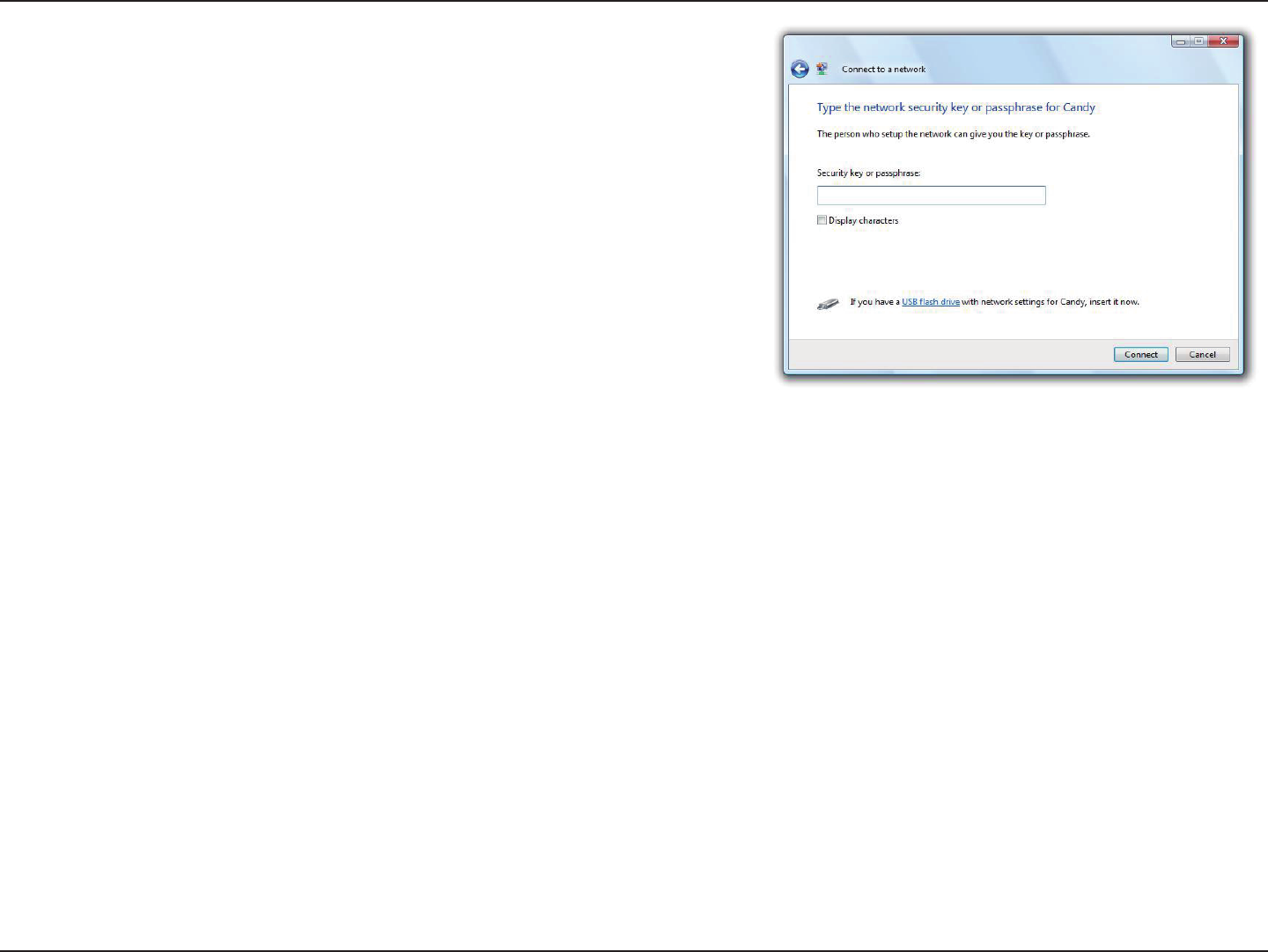
74D-Link DIR-456U User Manual
Section 5 - Connecting to a Wireless Network
3. If your wireless network uses encryption such as WEP or WPA/
WPA2, enter the encryption password/passphrase for your wireless
network and click Connect.
It may take 20-30 seconds to connect to the wireless network. If the
connection fails, please verify that the key or passphrase is exactly
the same as on the wireless router.
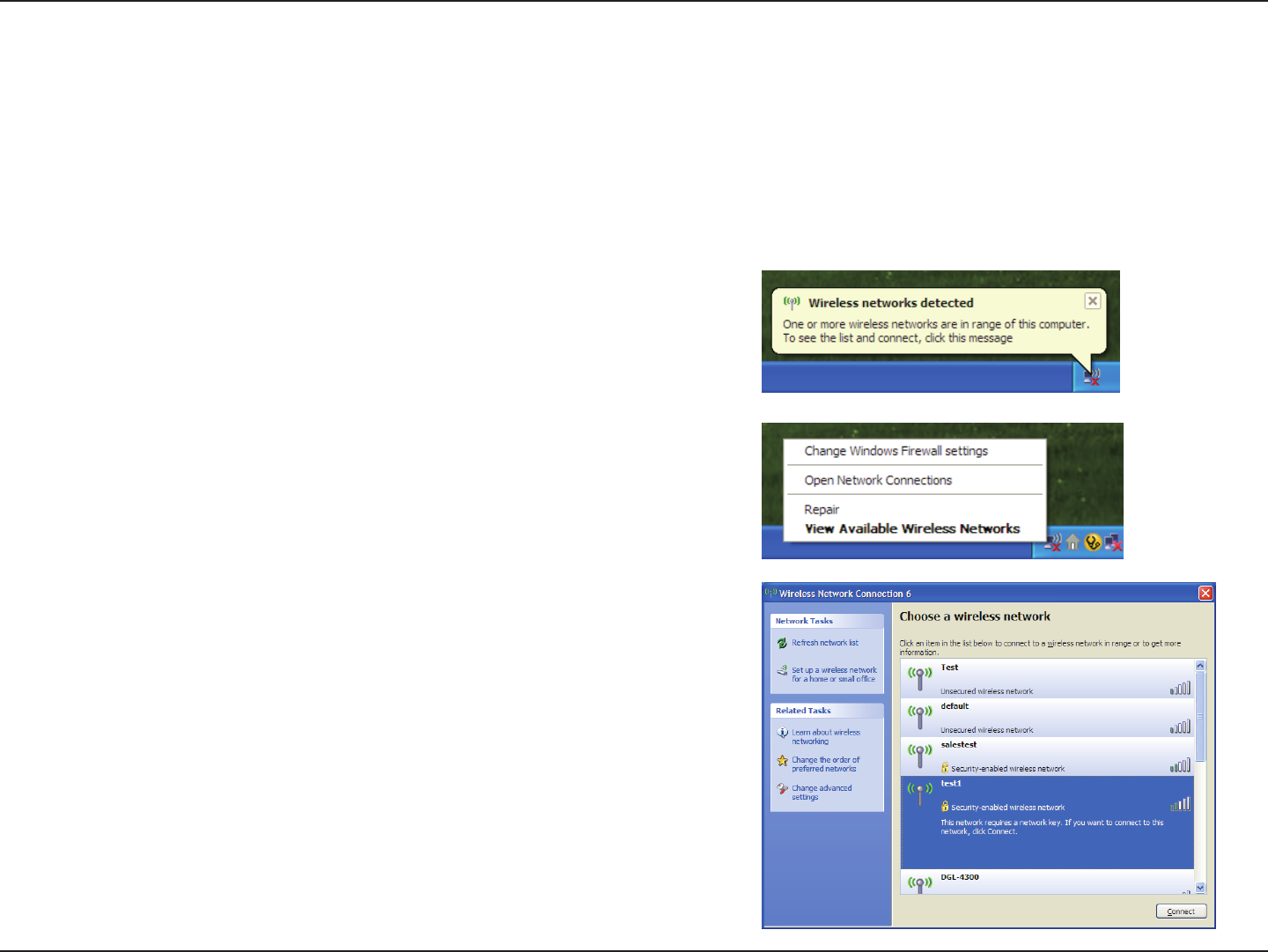
75D-Link DIR-456U User Manual
Section 5 - Connecting to a Wireless Network
Connecting to a Wireless Network
Using Windows® XP
Windows® XP users may use the built-in wireless utility (Zero Conguration Utility). The following instructions are for
Service Pack 2 users. If you are using another company’s utility or Windows® 2000, please refer to the user manual
of your wireless adapter for help with connecting to a wireless network. Most utilities will have a “site survey” option
similar to the Windows® XP utility as seen below.
1. If you receive the Wireless Networks Detected bubble, click
on the center of the bubble to access the utility.
or
Right-click on the wireless computer icon in the system tray
in the lower-right corner of the screen. Select View Available
Wireless Networks.
2. The utility will display any available wireless networks in your
area. Click on a network (displayed using the SSID) and click
the Connect button.
If you get a good signal but cannot access the Internet,
check you TCP/IP settings for your wireless adapter. Refer
to the Networking Basics section in this manual for more
information.
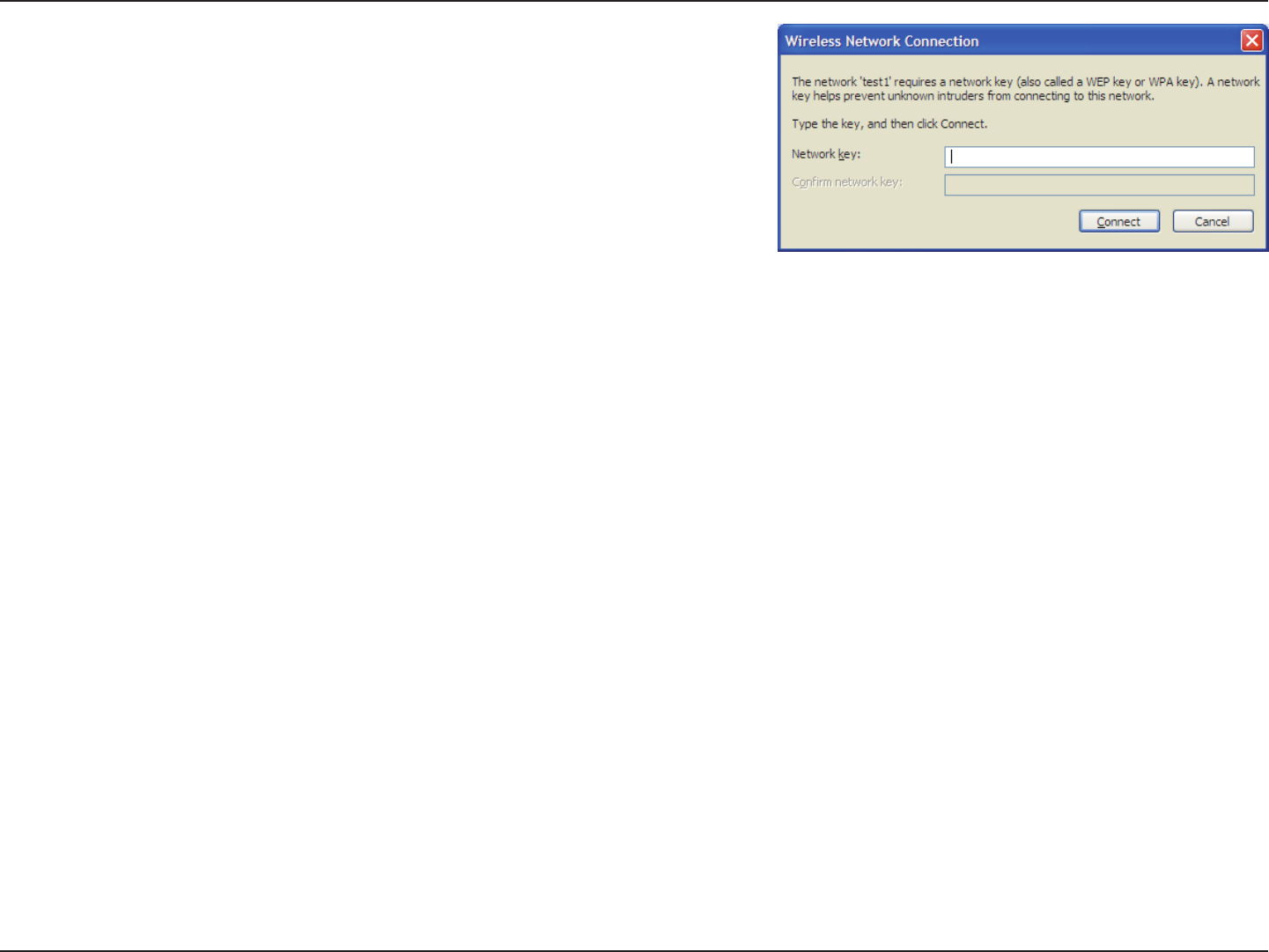
76D-Link DIR-456U User Manual
Section 5 - Connecting to a Wireless Network
3. If your wireless network uses encryption such as WEP or WPA/
WPA2, enter the encryption password/passphrase for your wireless
network and click Connect.
It may take 20-30 seconds to connect to the wireless network. If the
connection fails, please verify that the key or passphrase is exactly
the same as on the wireless router.

77D-Link DIR-456U User Manual
Section 6 - Troubleshooting
Troubleshooting
This chapter provides solutions to problems that can occur during the installation and operation of the DIR-456U. Read the following
descriptions if you are having problems. (The examples below are illustrated in Windows® XP. If you have a different operating system,
the screenshots on your computer will look similar to the following examples.)
1. Why can’t I access the web-based conguration utility?
When entering the IP address of the D-Link router (192.168.0.1 for example), you are not connecting to a website on the Internet or have
to be connected to the Internet. The device has the utility built-in to a ROM chip in the device itself. Your computer must be on the same
IP subnet to connect to the web-based utility.
• Make sure you have an updated Java-enabled web browser. We recommend the following:
• Internet Explorer 6.0 or higher
• Netscape 8 or higher
• Mozilla 1.7.12 (5.0) or higher
• Opera 8.5 or higher
• Safari 1.2 or higher (with Java 1.3.1 or higher)
• Camino 0.8.4 or higher
• Firefox 1.5 or higher
• Verify physical connectivity by checking for solid link lights on the device. If you do not get a solid link light, try using a different cable or
connect to a different port on the device if possible. If the computer is turned off, the link light may not be on.
• Disable any internet security software running on the computer. Software rewalls such as Zone Alarm, Black Ice, Sygate, Norton Personal
Firewall, and Windows® XP rewall may block access to the conguration pages. Check the help les included with your rewall software
for more information on disabling or conguring it.

78D-Link DIR-456U User Manual
Section 6 - Troubleshooting
• Congure your Internet settings:
• Go to Start > Settings > Control Panel. Double-click the Internet Options Icon. From the Security tab, click the button
to restore the settings to their defaults.
• Click the Connection tab and set the dial-up option to Never Dial a Connection. Click the LAN Settings button. Make sure
nothing is checked. Click OK.
• Go to the Advanced tab and click the button to restore these settings to their defaults. Click OK three times.
• Close your web browser (if open) and open it.
• Access the web management. Open your web browser and enter the IP address of your D-Link router in the address bar. This should
open the login page for your the web management.
• If you still cannot access the conguration, unplug the power to the router for 10 seconds and plug back in. Wait about 30 seconds and
try accessing the conguration. If you have multiple computers, try connecting using a different computer.
2. What can I do if I forgot my password?
If you forgot your password, you must reset your router. Unfortunately this process will change all your settings back to the factory
defaults.
To reset the router, locate the reset button (hole) on the rear panel of the unit. With the router powered on, use a paperclip to hold the
button down for 10 seconds. Release the button and the router will go through its reboot process. Wait about 30 seconds to access the
router. The default IP address is 192.168.0.1. When logging in, the username is admin and leave the password box empty.

79D-Link DIR-456U User Manual
Appendix A - Wireless Basics
D-Link wireless products are based on industry standards to provide easy-to-use and compatible high-speed wireless connectivity within
your home, business or public access wireless networks. Strictly adhering to the IEEE standard, the D-Link wireless family of products
will allow you to securely access the data you want, when and where you want it. You will be able to enjoy the freedom that wireless
networking delivers.
A wireless local area network (WLAN) is a cellular computer network that transmits and receives data with radio signals instead of wires.
Wireless LANs are used increasingly in both home and ofce environments, and public areas such as airports, coffee shops and universities.
Innovative ways to utilize WLAN technology are helping people to work and communicate more efciently. Increased mobility and the
absence of cabling and other xed infrastructure have proven to be benecial for many users.
Wireless users can use the same applications they use on a wired network. Wireless adapter cards used on laptop and desktop systems
support the same protocols as Ethernet adapter cards.
Under many circumstances, it may be desirable for mobile network devices to link to a conventional Ethernet LAN in order to use servers,
printers or an Internet connection supplied through the wired LAN. A Wireless Router is a device used to provide this link.
Wireless Basics

80D-Link DIR-456U User Manual
Appendix A - Wireless Basics
What is Wireless?
Wireless or Wi-Fi technology is another way of connecting your computer to the network without using wires. Wi-Fi uses radio frequency
to connect wirelessly, so you have the freedom to connect computers anywhere in your home or ofce network.
Why D-Link Wireless?
D-Link is the worldwide leader and award winning designer, developer, and manufacturer of networking products.
D-Link delivers the performance you need at a price you can afford. D-Link has all the products you need to build your network.
How does wireless work?
Wireless works similar to how cordless phone work, through radio signals to transmit data from one point A to point B. But wireless
technology has restrictions as to how you can access the network. You must be within the wireless network range area to be able to
connect your computer. There are two different types of wireless networks Wireless Local Area Network (WLAN), and Wireless Personal
Area Network (WPAN).
Wireless Local Area Network (WLAN)
In a wireless local area network, a device called an Access Point (AP) connects computers to the network. The access point has a small
antenna attached to it, which allows it to transmit data back and forth over radio signals. With an indoor access point as seen in the picture,
the signal can travel up to 300 feet. With an outdoor access point the signal can reach out up to 30 miles to serve places like manufacturing
plants, industrial locations, college and high school campuses, airports, golf courses, and many other outdoor venues.
Wireless Personal Area Network (WPAN)
Bluetooth is the industry standard wireless technology used for WPAN. Bluetooth devices in WPAN operate in a range up to 30 feet
away.

81D-Link DIR-456U User Manual
Appendix A - Wireless Basics
Compared to WLAN the speed and wireless operation range are both less than WLAN, but in return it doesn’t use nearly as much power
which makes it ideal for personal devices, such as mobile phones, PDAs, headphones, laptops, speakers, and other devices that operate
on batteries.
Who uses wireless?
Wireless technology as become so popular in recent years that almost everyone is using it, whether it’s for home, ofce, business, D-Link
has a wireless solution for it.
Home
• Gives everyone at home broadband access
• Surf the web, check e-mail, instant message, and etc
• Gets rid of the cables around the house
• Simple and easy to use
Small Ofce and Home Ofce
• Stay on top of everything at home as you would at ofce
• Remotely access your ofce network from home
• Share Internet connection and printer with multiple computers
• No need to dedicate ofce space

82D-Link DIR-456U User Manual
Appendix A - Wireless Basics
Where is wireless used?
Wireless technology is expanding everywhere not just at home or ofce. People like the freedom of mobility and it’s becoming so popular
that more and more public facilities now provide wireless access to attract people. The wireless connection in public places is usually
called “hotspots”.
Using a D-Link Cardbus Adapter with your laptop, you can access the hotspot to connect to Internet from remote locations like Airports,
Hotels, Coffee Shops, Libraries, Restaurants, and Convention Centers.
Wireless network is easy to setup, but if you’re installing it for the rst time it could be quite a task not knowing where to start. That’s why
we’ve put together a few setup steps and tips to help you through the process of setting up a wireless network.
Tips
Here are a few things to keep in mind, when you install a wireless network.
Centralize your Router or Access Point
Make sure you place the router/access point in a centralized location within your network for the best performance. Try to place the router/
access point as high as possible in the room, so the signal gets dispersed throughout your home. If you have a two-story home, you may
need a repeater to boost the signal to extend the range.
Eliminate Interference
Place home appliances such as cordless telephones, microwaves, and televisions as far away as possible from the router/access point.
This would signicantly reduce any interference that the appliances might cause since they operate on same frequency.
Security
Don’t let you next-door neighbors or intruders connect to your wireless network. Secure your wireless network by turning on the WPA or
WEP security feature on the router. Refer to product manual for detail information on how to set it up.

83D-Link DIR-456U User Manual
Appendix A - Wireless Basics
There are basically two modes of networking:
• Infrastructure – All wireless clients will connect to an access point or wireless router.
• Ad-Hoc – Directly connecting to another computer, for peer-to-peer communication, using wireless network adapters on
each computer, such as two or more WNA-2330 wireless network Cardbus adapters.
An Infrastructure network contains an Access Point or wireless router. All the wireless devices, or clients, will connect to the wireless
router or access point.
An Ad-Hoc network contains only clients, such as laptops with wireless cardbus adapters. All the adapters must be in Ad-Hoc mode to
communicate.
Wireless Modes
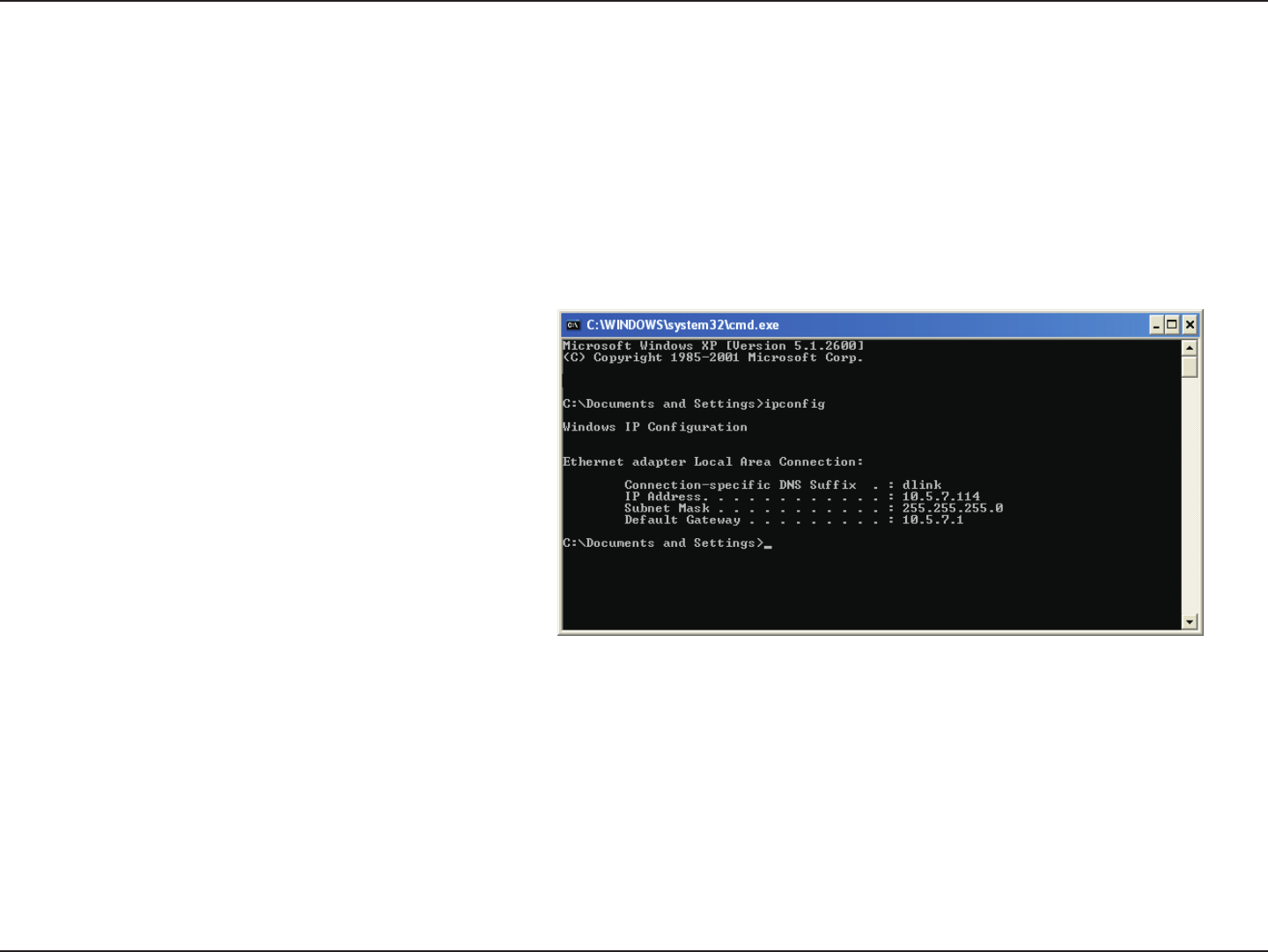
84D-Link DIR-456U User Manual
Appendix B - Networking Basics
Networking Basics
Check your IP address
After you install your new D-Link adapter, by default, the TCP/IP settings should be set to obtain an IP address from a DHCP server (i.e.
wireless router) automatically. To verify your IP address, please follow the steps below.
Click on Start > Run. In the run box type cmd and click
OK. (Windows® Vista™ users type cmd in the Start Search
box.)
At the prompt, type ipconfig and press Enter.
This will display the IP address, subnet mask, and the
default gateway of your adapter.
If the address is 0.0.0.0, check your adapter installation, security settings, and the settings on your router. Some rewall software programs
may block a DHCP request on newly installed adapters.
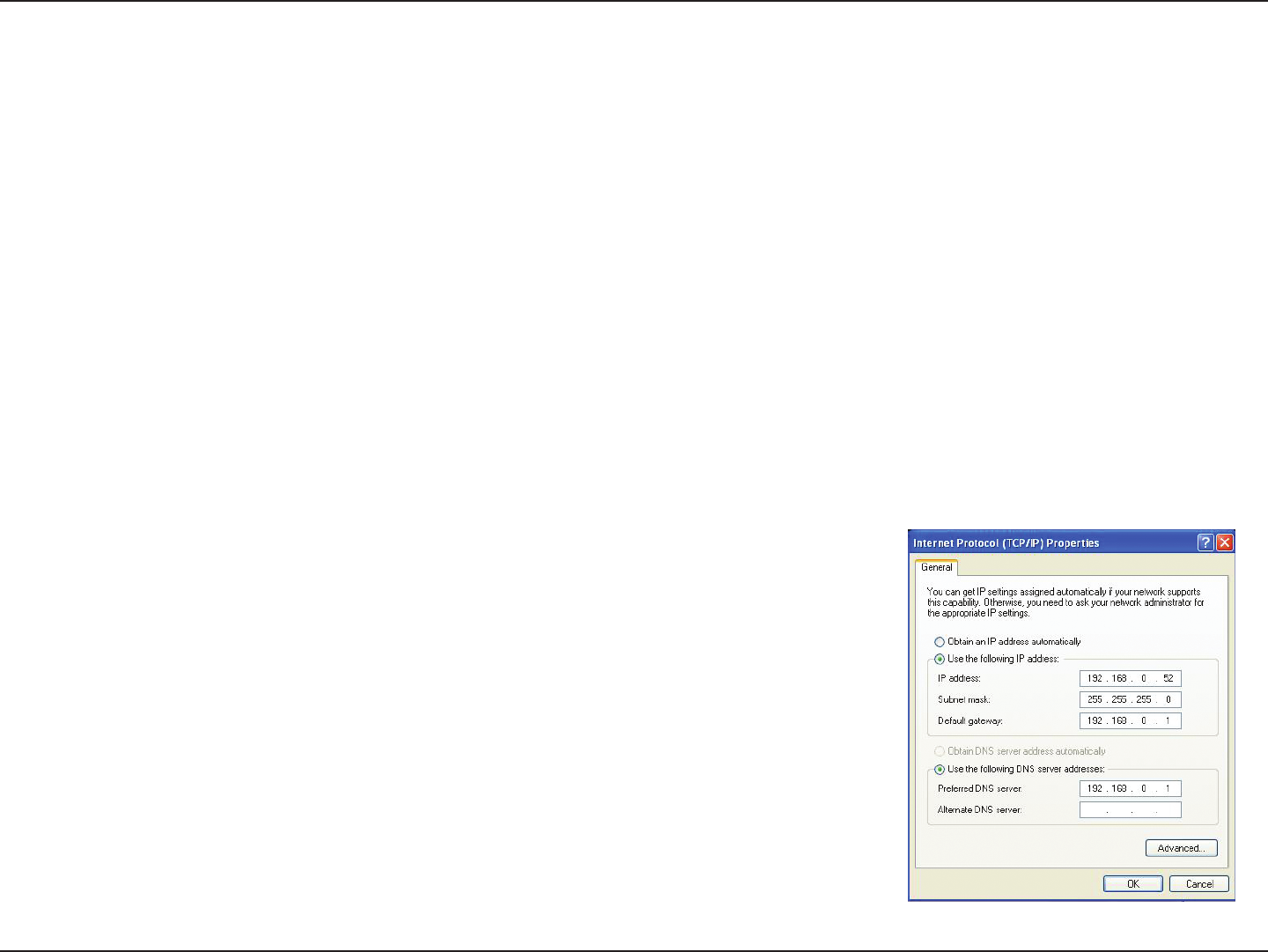
85D-Link DIR-456U User Manual
Appendix B - Networking Basics
Statically Assign an IP address
If you are not using a DHCP capable gateway/router, or you need to assign a static IP address, please follow the steps below:
Step 1
Windows® Vista™ - Click on Start > Control Panel > Network and Internet > Network and Sharing Center > Manage Network
Connections.
Windows® XP - Click on Start > Control Panel > Network Connections.
Windows® 2000 - From the desktop, right-click My Network Places > Properties.
Step 2
Right-click on the Local Area Connection which represents your network adapter and select Properties.
Step 3
Highlight Internet Protocol (TCP/IP) and click Properties.
Step 4
Click Use the following IP address and enter an IP address that is on the same subnet as your
network or the LAN IP address on your router.
Example: If the router´s LAN IP address is 192.168.0.1, make your IP address 192.168.0.X where
X is a number between 2 and 99. Make sure that the number you choose is not in use on the
network. Set Default Gateway the same as the LAN IP address of your router (192.168.0.1).
Set Primary DNS the same as the LAN IP address of your router (192.168.0.1). The Secondary
DNS is not needed or you may enter a DNS server from your ISP.
Step 5
Click OK twice to save your settings.
Federal Communication Commission Interference Statement
This equipment has been tested and found to comply with the limits for a Class B digital device,
pursuant to Part 15 of the FCC Rules. These limits are designed to provide reasonable
protection against harmful interference in a residential installation. This equipment generates,
uses and can radiate radio frequency energy and, if not installed and used in accordance with the
instructions, may cause harmful interference to radio communications. However, there is no
guarantee that interference will not occur in a particular installation. If this equipment does
cause harmful interference to radio or television reception, which can be determined by turning
the equipment off and on, the user is encouraged to try to correct the interference by one of the
following measures:
- Reorient or relocate the receiving antenna.
- Increase the separation between the equipment and receiver.
- Connect the equipment into an outlet on a circuit different from that
to which the receiver is connected.
- Consult the dealer or an experienced radio/TV technician for help.
This device complies with Part 15 of the FCC Rules. Operation is subject to the following two
conditions: (1) This device may not cause harmful interference, and (2) this device must accept
any interference received, including interference that may cause undesired operation.
FCC Caution: Any changes or modifications not expressly approved by the party responsible for
compliance could void the user's authority to operate this equipment.
IEEE 802.11b or 802.11g operation of this product in the U.S.A. is firmware-limited to channels 1
through 11.
IMPORTANT NOTE:
FCC Radiation Exposure Statement:
This equipment complies with FCC radiation exposure limits set forth for an uncontrolled
environment. This equipment should be installed and operated with minimum distance 20cm
between the radiator & your body.
This transmitter must not be co-located or operating in conjunction with any other antenna or
transmitter.
The availability of some specific channels and/or operational frequency bands are country
dependent and are firmware programmed at the factory to match the intended destination. The
firmware setting is not accessible by the end user.
以下警語適用台灣地區
經型式認證合格之低功率射頻電機,非經許可,公司、商號或使用者均不得擅自變更頻率、加大功
率或變更原設計之特性及功能。
低功率射頻電機之使用不得影響飛航安全及干擾合法通信;經發現有干擾現象時,應立即停用,並
改善至無干擾時方得繼續使用。前項合法通信,指依電信法規定作業之無線電通信。低功率射頻電
機須忍受合法通信或工業、科學及醫療用電波輻射性電機設備之干擾。
減少電磁波影響,請妥適使用